It seems we can’t find what you’re looking for. Perhaps searching can help.




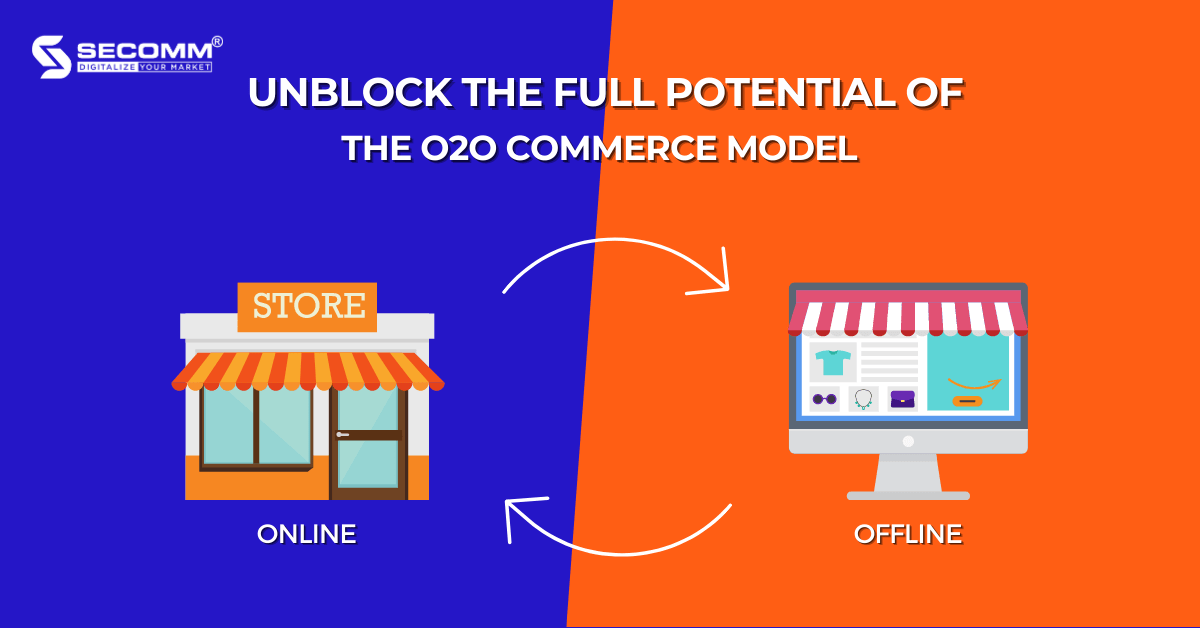
UNBLOCKED THE FULL POTENTIAL OF THE O2O COMMERCE MODEL
After Covid, eCommerce is on the rise and is expected to continue to thrive stronger and more resilient than ever. Global retail eCommerce sales reached $4.9 trillion in 2021, as stated by Statista. By 2025, this figure is projected to increase by 50% to approximately $7.4 trillion and there is no sign that the growth of online shopping will slow down anytime soon.
The expansion of eCommerce has raised concerns among physical store owners and urged them to embrace eCommerce quickly to avoid being left behind. It’s simple for businesses with a large budget, but other small and medium-sized businesses will not be able to move their entire operations online. Thus, the O2O Commerce model is the solution worth considering. Its popularity has been raised since 2021 and is expected to reach retailers soon.
What is O2O Commerce?
O2O or Online-to-Offline Commerce Model is a business strategy that draws potential customers from online channels to make purchases in brick-and-mortar stores. This model aims to create a seamless shopping experience at all stages: before, during, and after purchasing.
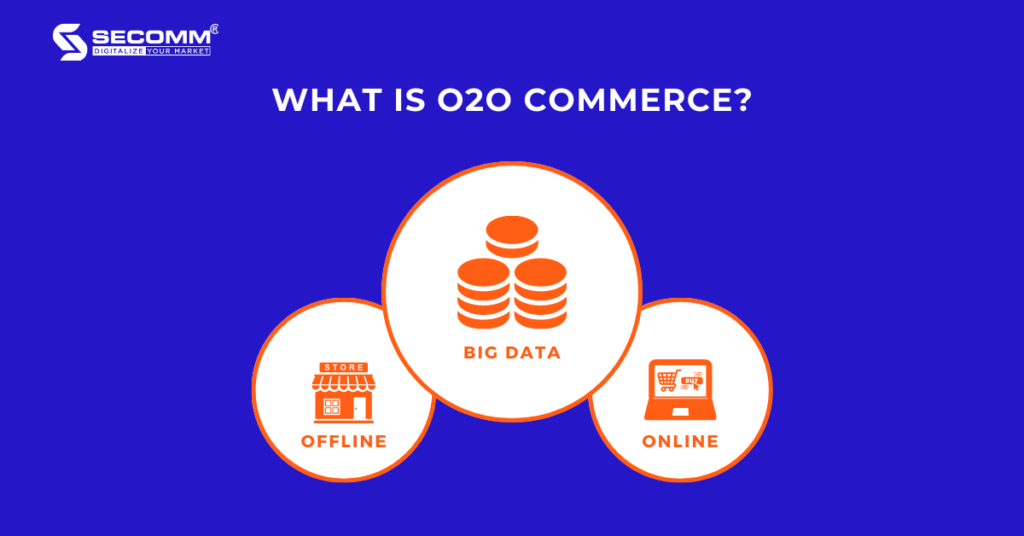
How does O2O Commerce work?
O2O Commerce combines online and offline business models. Its objective is to increase product awareness online, allowing customers to search for what they need before visiting a physical store to make a purchase. There are some O2O strategies that businesses can try including Buy Online Pick-up In-store (BOPIS), In-store Returns, Home Delivery, etc
For example:
- A man wants to buy a shirt from a particular fashion brand;
- He searches for it online and goes to the web store that sells the product he is interested in;
- Then, he chooses the shirt’s size and color, applies a discount code, and makes a purchase;
- He goes to a local store and picks up the shirt by providing his information;
- He tries on the shirt he ordered in the store to check its quality, size, and comfort. If he is not satisfied with the product, he can return it and get a refund.
That way, the customer can both take advantage of the discount code for the shirt, and try it on at the nearest store without having to wait for delivery. Moreover, he can completely return the shirt immediately and go to another store if he is not satisfied.
Home Delivery is also another popular strategy in the O2O world. It will take a few hours or a day. So, the man can buy his shirt online, select the home-delivery option and wait to get it. In another case, when going to the store to pick up the shirt, he sees and likes a jacket but needs help finding the right size or favorite color. He simply places an order online while in store and that desired jacket will be delivered to his door.
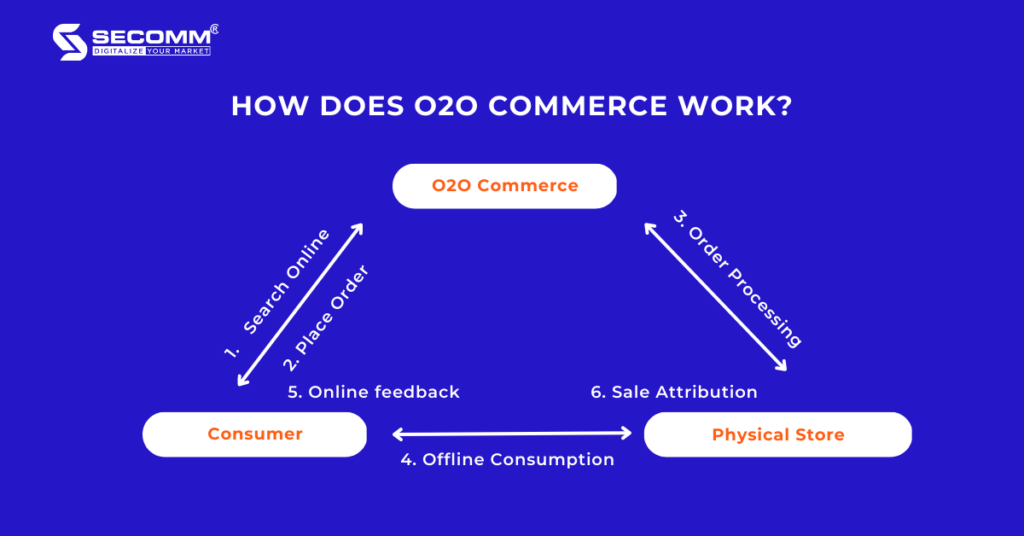
The differences between O2O and Omnichannel
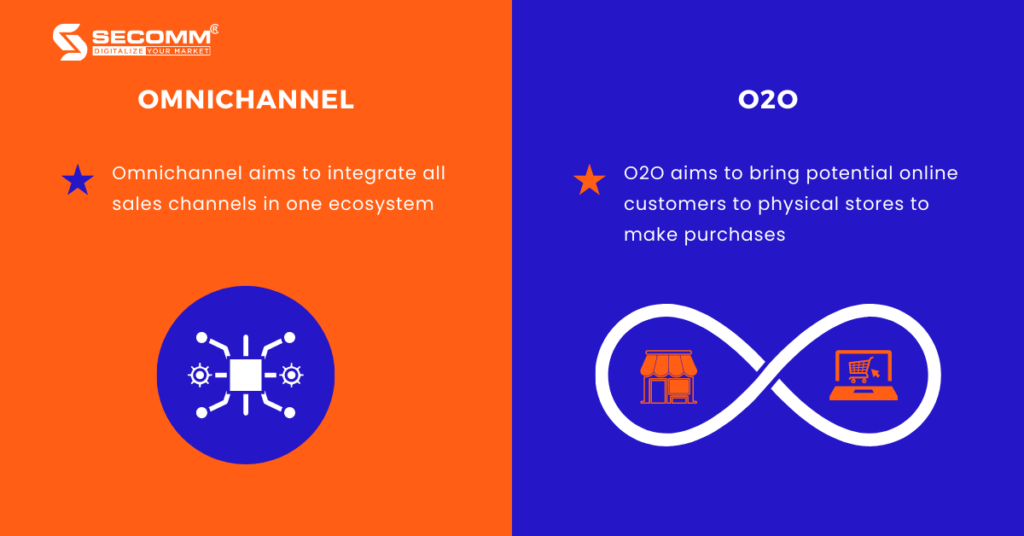
The example above may confuse the O2O commerce model and the Omnichannel commerce model. Although they both facilitate a more seamless shopping experience among channels, their main goals are quite different. While Omnichannel aims to integrate all sales channels in one ecosystem, O2O aims to bring potential online customers to physical stores to make purchases. Both strategies are designed to bridge the gap between online and offline sales, but O2O prioritizes a specific buying journey instead of multiple touchpoints in Omnichannel commerce.
Case studies

Topshop
One of the brands that understand what they are doing to connect in-store shopping with online shopping in a tight way is Topshop. By partnering with eCommerce website ShangPin to open retail stores in malls, with giant iPhones decorated in Topshop style, customers can access “The Mobile Adventure” by scanning a QR code to view and try on virtual Topshop fashion products in the store. Then they share their look on social media and place an order.
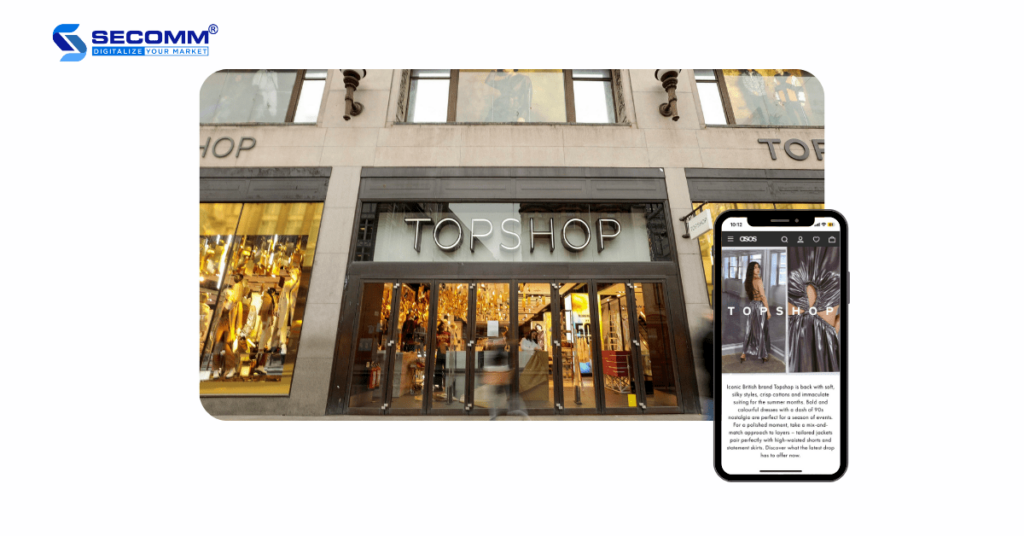
Tommy Hilfiger
When it comes to fashion, Tommy Hilfiger has shown his agility when deploying the O2O model. In 2015, the brand launched digital showrooms, pioneering the fashion industry’s digital revolution. In 2016 they launched a chatbot through Facebook Messenger and in 2017 they launched the Hilfiger Club app with a loyalty program of personalized special offers and invitations to the brand’s events. All of that gives customers a good reason to come to the store.
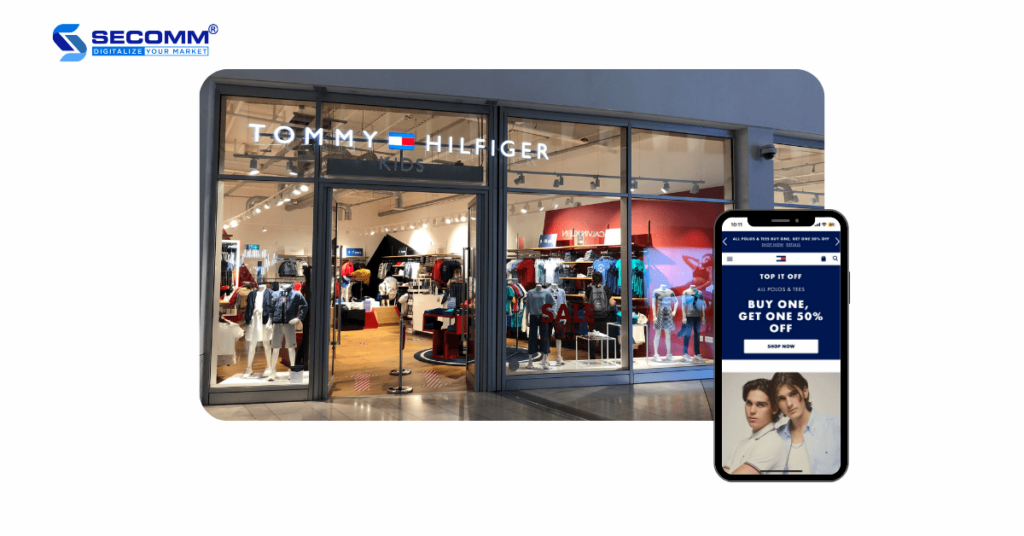
99 Ranch Market and WeChat’s Shake
In recognition of the significance of an O2O commerce strategy, WeChat introduced a “Shake” feature that enables mobile users to connect to a nearby local business by shaking their phones. The retailer’s unique offers are then all accessible, encouraging customers to engage in the in-store buying experience.
Soon after, the 99 Ranch Market, a chain of Chinese-American supermarkets, benefited from the popularity of WeChat’s “Shake” feature and the rise of O2O among the Chinese community in the US. Customers can play a “beacon shake” game the company has created, which is activated by in-store beacons and gives them the chance to win a variety of prizes and coupons for their subsequent purchases.
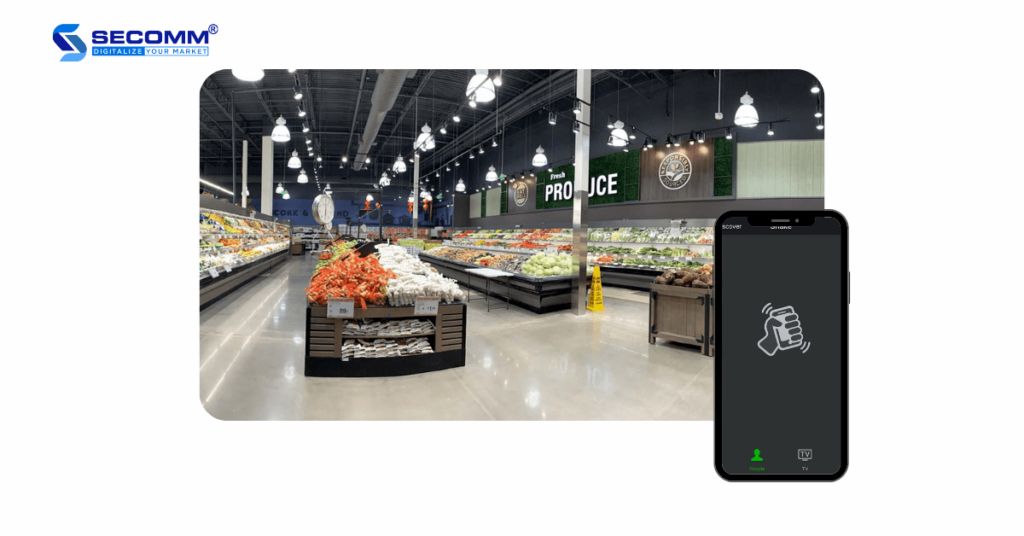
The O2O Commerce model is an incredible idea with great potential to change both online and offline sales in the eCommerce era. While customers can shop both in-store and online, brands can optimize engagement, conversion rates, and average order value.
Today, when customers’ expectations for online shopping are similar to offline shopping, one condition for physical stores to survive is to build their online presence quickly. The O2O strategy is about leveraging both online and offline channels, thereby enhancing brand loyalty, and providing a seamless Online-to-Offline shopping experience at all stages: before, during, and after purchases.
Want to know more? Contact our experts to learn more about O2O Commerce and how to implement it in your business.
 2
2

 2,658
2,658

 0
0

 1
1
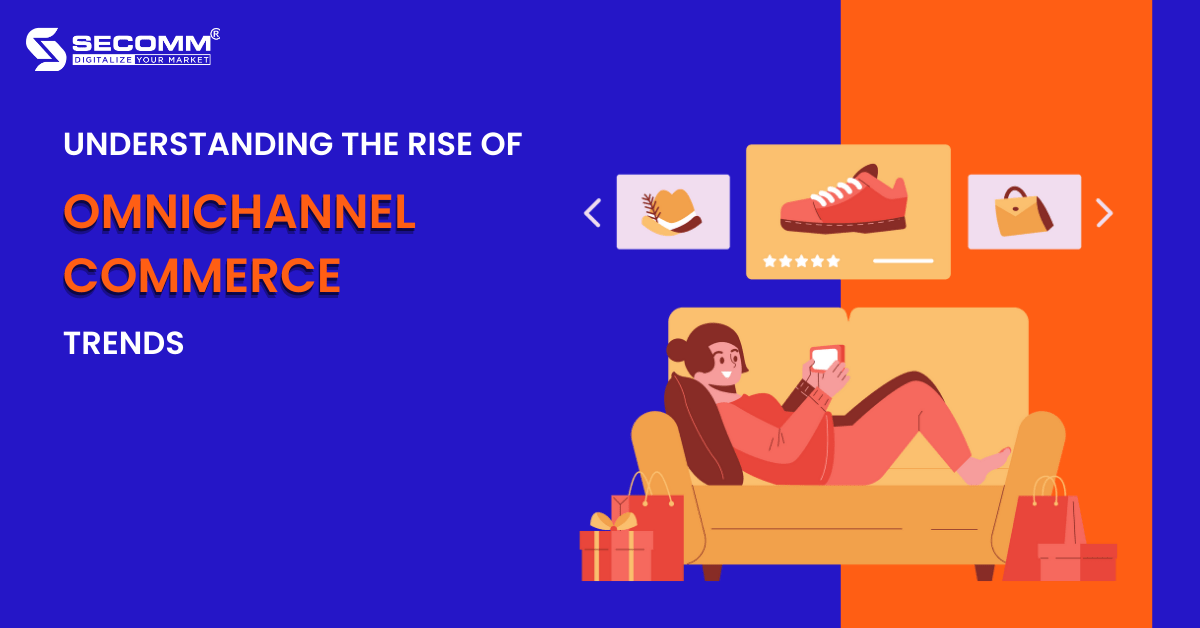
UNDERSTANDING THE RISE OF OMNICHANNEL COMMERCE TRENDS
We are living in a world where the younger generation has taken the lead in setting ever-rising standards for digital experience. So, it’s important for businesses to quickly adapt to new trends for sustainable development to keep up with the shift.
Especially during a global pandemic, eCommerce has become one of the top priorities of every business owner. In order to thrive in a rapidly changing market and keep customers loyal, brick-and-mortar businesses have had to build an online presence and increase their eCommerce capabilities.
The term “Omnichannel Commerce” is defined as a “trend” that helps businesses achieve the aforementioned objectives and this trend is expected to continue to accelerate in the coming years.
What is Omnichannel Commerce?
Omnichannel Commerce is a multichannel approach that focuses on offering a seamless shopping experience by marketing and selling across all channels where potential customers are present including mobile devices, social networks, eCommerce websites, and brick-and-mortar stores.
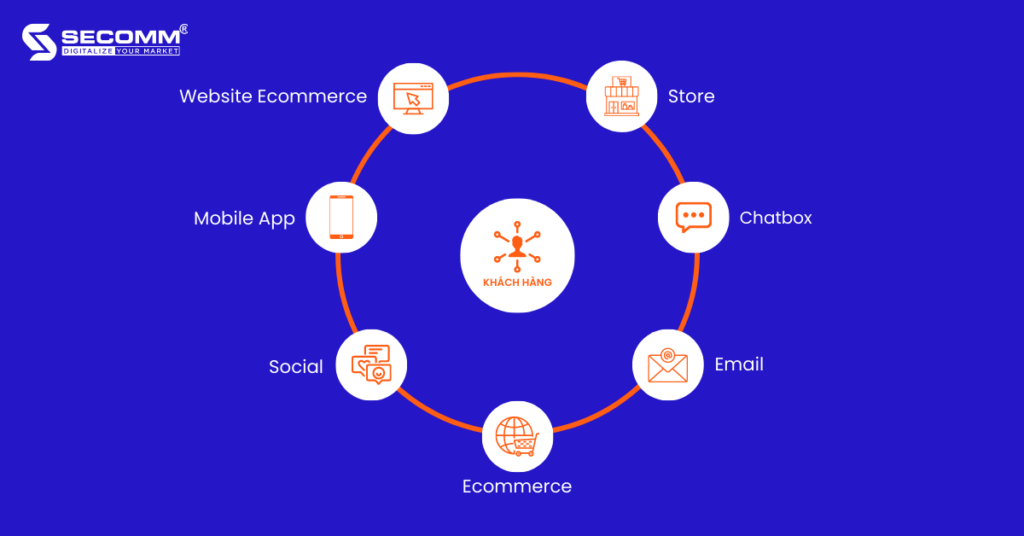
The main differences between Single Channel, Multichannel, and Omnichannel
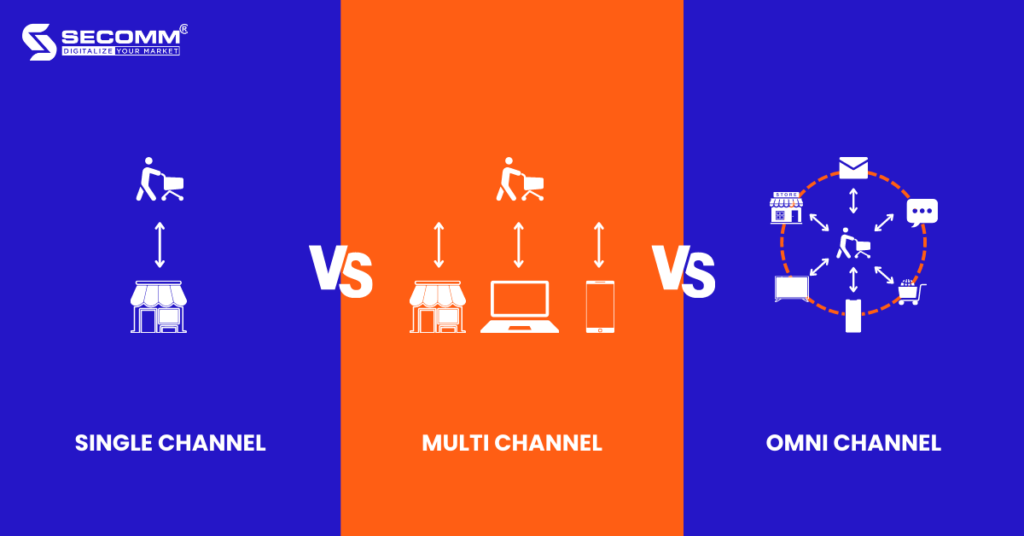
Single-channel Commerce
When a company sells its products or services only through one channel, that approach is known as single-channel commerce. It could be a physical store, an eCommerce website, or a marketplace like Shopee, Lazada, Tiki, etc.
Selling through a single channel could initially be quite successful, but if businesses desire to provide their customers with a richer shopping experience and increase brand awareness, they need to add multiple channels to showcase and sell their products or services.
Multichannel Commerce
When it comes to the Multichannel Commerce strategy, businesses will interact with customers and sell their products through both online and offline channels. This strategy makes use of touchpoints where customers can perform the same action at any available channel. These touchpoints, however, are independent and barely or not at all connected among channels. For example, a physical store with an eCommerce website has no inventory-sharing function.
Omnichannel Commerce
Similar to Multichannel Commerce, Omnichannel Commerce enables a company’s marketing and sales efforts to be spread across numerous channels. The main distinction is that Omnichannel Commerce prioritizes the customer, connects all touchpoints, and creates a unified buying experience. But, Multichannel Commerce aims to reach as many channels as possible, with unique content for each and customers will interact with brands through their preferred channels.
How does Omnichannel Commerce work?
An effective Omnichannel Commerce strategy includes effective operations of each sales channel that will be integrated in a seamless and consistent manner. Touchpoints should provide a unique but connected experience based on previous interactions. That experience takes customers to the end of the customer journey to get the business’s objectives.
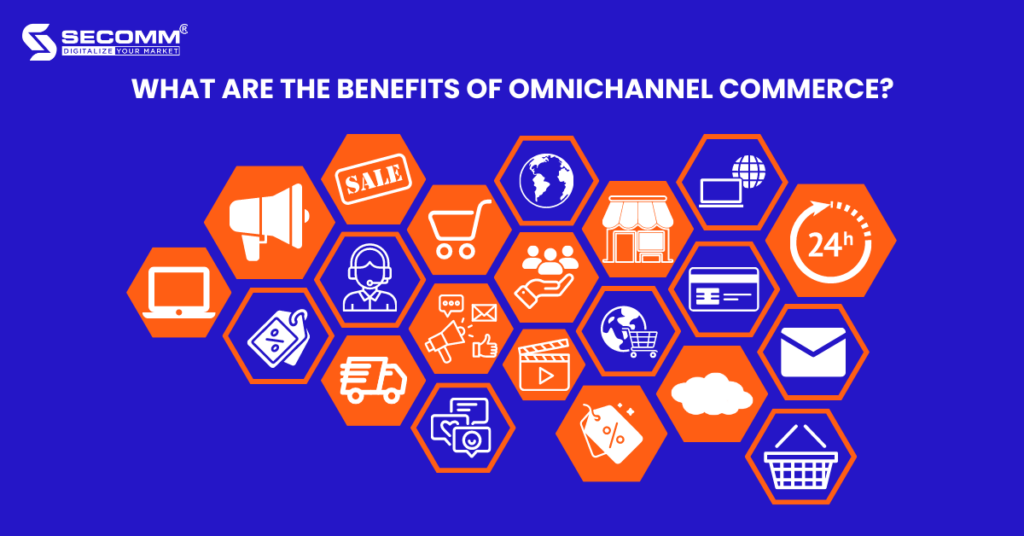
Imagine a man who wanted to buy a new washing machine. After seeing an attractive TVC with the merchant’s information, he used his laptop to begin searching on the Internet. He discovered the merchant’s eCommerce website, and his desired product is offered at a local physical store. He decided to add that product to his shopping cart after chatting with the customer service team.
He downloaded the merchant’s app, signed into his account, and accessed his cart before heading to the store because he wanted to see and check that washing machine in person before making a purchase. He checked the app to ensure the item is still in stock, its quantity, the best payment method, and any associated special offers.
When he arrived, he checked the product’s quality and checked out with the QR Code. The transaction is finished. Under the CRM system, his information and data would be saved for upcoming marketing campaigns and post-sale efforts.
What are the benefits of Omnichannel Commerce?
Nowadays, consumers receive a ton of offers and messages from many brands day after day. This brings up many considerations when choosing a brand to engage with. Developing an Omnichannel strategy to connect with customers in a seamless manner across multiple channels will set a brand apart from the competition.
Omnichannel Commerce is a customer-centric model, connecting touchpoints and providing personalized experiences. This contributes to the company’s revenue increase as expected with cross-sell and up-sell opportunities.
Also, the branding strategy will be effective and successful, enhancing customer loyalty as well as the brand message will reach the right target audience thanks to the consistency of the Omnichannel Commerce model. It’s not only useful for increasing customer engagement but also for customer data evaluation.
Thus, businesses will have a bigger picture of the customer journey, the times and channels customers usually interact with, as well as the most effective and valuable marketing campaigns. All this data needs to be meticulously analyzed and reused in the next marketing campaigns.
3 examples of Omnichannel Commerce in the real world
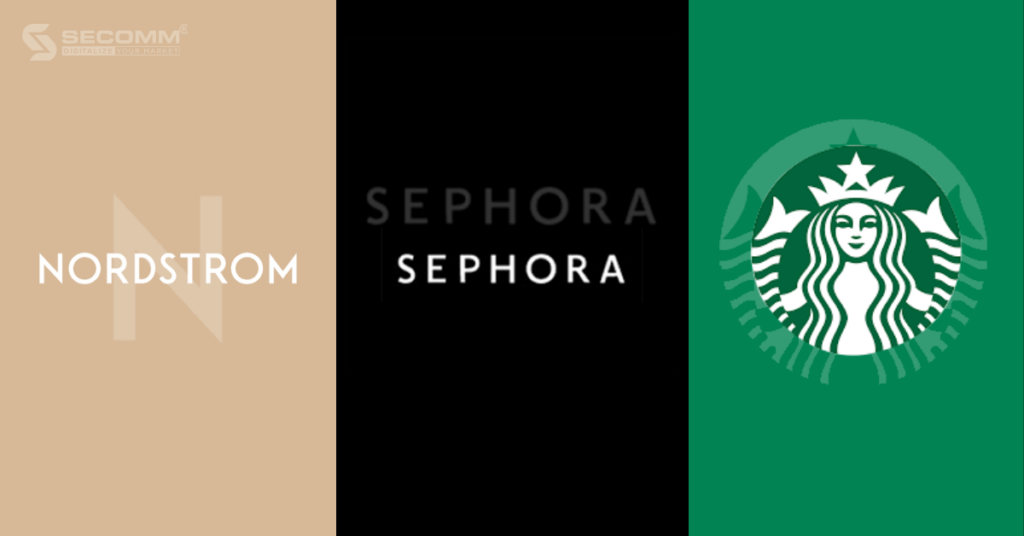
Nordstrom
Omnichannel Commerce has long been a strength for Nordstrom. They created the Pincode feature that allows customers to use their smartphone to scan and access Pinterest to get a $100 Nordstrom giveaway while in the store. The brand also showcases in the store Pinterest’s best-selling products as an interesting suggestion.
In addition to Pinterest, it uses Youtube to create video tutorials for matching outfits and suggests its customers go to the physical store to meet a professional. At the store, they will receive valuable advice that may lead to a purchase decision.
Recently, Nordstrom has leveraged Instagram’s shoppable posts to inspire shopping and encourage customers to make quick decisions.

Sephora
Sephora is one of the major brands in the beauty industry that is successful with Omnichannel Commerce. The company has established a strong connection between online and offline shopping experiences. Customers can access Sephora Beauty Bag’s personal account by using available tablets in its brick-and-mortar stores.
This account allows them to look up details of the items they are interested in and try them out using virtual reality. Additionally, Sephora’s benefits, like its in-store makeup tutorials and personalized gifts, have encouraged customers to make larger purchases.
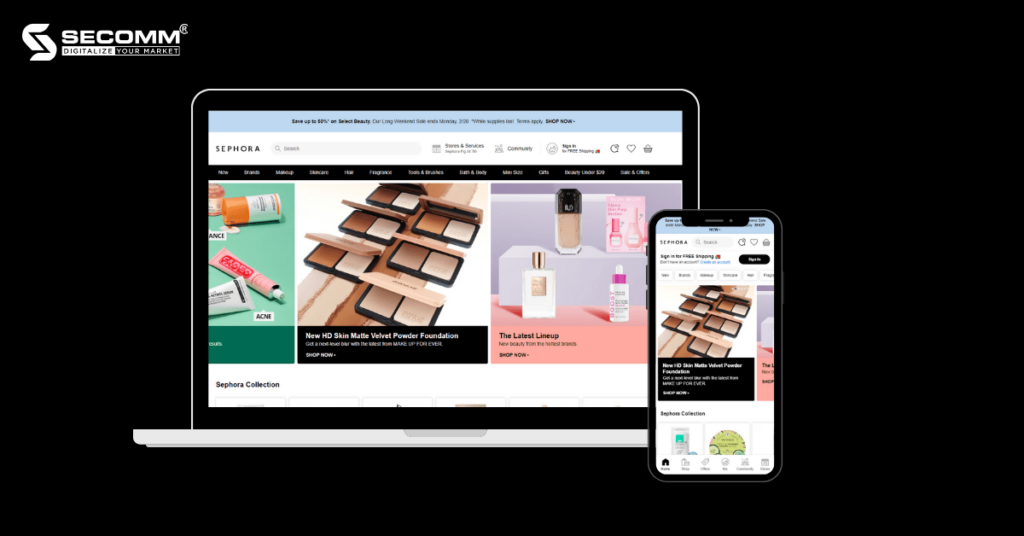
Starbucks
The world-famous beverage brand – Starbucks has launched the Starbucks Rewards App which is considered the pinnacle of Omnichannel Commerce. After creating an account, Starbucks fans can find a list of local stores, order drinks, and pay in advance so they don’t have to wait in line.
The app also regularly makes personalized recommendations for each customer based on previous orders, loyalty programs, weather, holiday seasons, or local store inventory.

Keeping up with the ever-changing business world is not easy. In fact, many big brands in the world have implemented Omnichannel Commerce early and have achieved great success. Plus, many other businesses are tending to gradually shift from Single-channel or Multichannel to Omnichannel and recognize this model as a bridge connecting customer experience between online and offline channels in a seamless way.
With many years of experience in successfully implementing eCommerce for many customers in many countries, SECOMM understands the difficulties when doing an Omnichannel Commerce strategy.
Contact our expert now to get a free consultation.
 2
2

 2,140
2,140

 0
0

 1
1
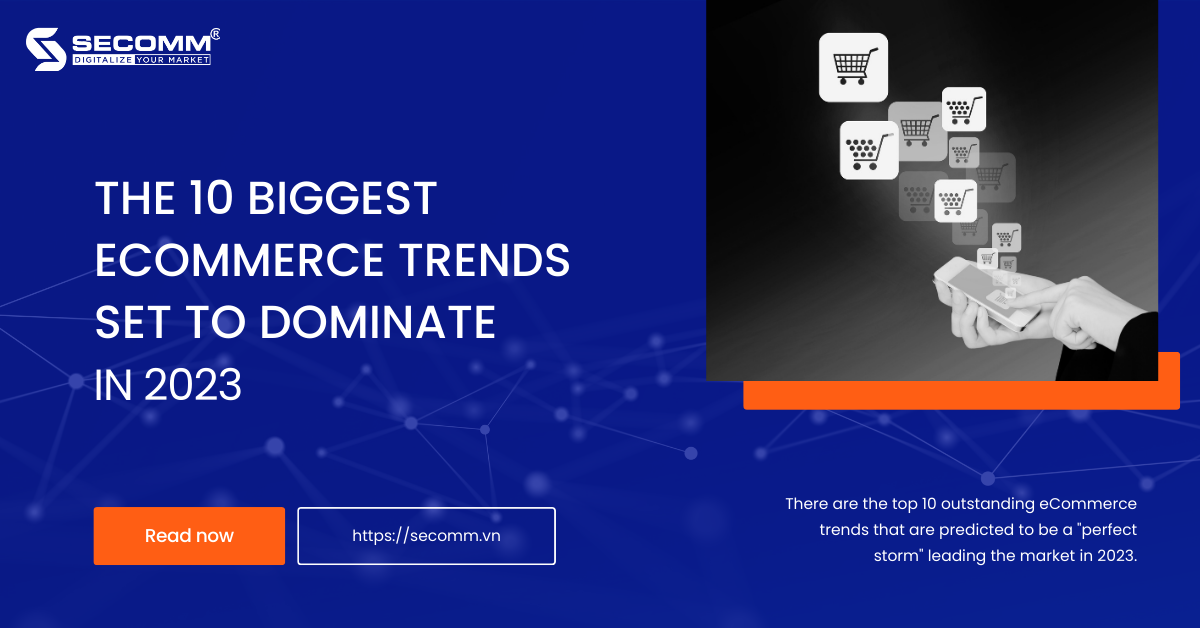
THE 10 BIGGEST ECOMMERCE TRENDS SET TO DOMINATE IN 2023
The eCommerce industry has a sizable market share in the Vietnamese economy and has shown impressive growth over the past two years due to the effects of the worldwide pandemic and social isolation.
After a year of society adjusting to the “new normal”, customers have started to buy at traditional stores again but the established trend of eCommerce consumption and the push from the wave of global digital transformation have encouraged businesses to change in order to suit the way the digital economy works.
Therefore, recognizing and anticipating the eCommerce trend of 2023 is extremely necessary for businesses’ New Year’s Marketing strategies to be implemented effectively and successfully.
Below is a list of 10 eCommerce trends that are forecast to “storm” the market in the next year.
Omnichannel
Omnichannel is an omnichannel sales model that helps businesses reach customers through many channels such as eCommerce websites, social networks, eCommerce platforms, chain stores, and distribution agents but operating in just one management system.
Additionally, there is a second type of sales model called “Multi-channel” that differs from Omnichannel in that it allows for discrete marketing content, unlinked data, and independent channel operation.
When purchasing across numerous channels, continuous and seamless updates result in a heterogeneous and seamless customer experience.

Due to the lifting of social distance restrictions, consumers are beginning to return to in-store buying after two years of online shopping.
However, that doesn’t mean that eCommerce’s growth momentum is stagnant; on the contrary, it keeps exploding.
Businesses there make use of the current rise in popularity of online shopping to encourage the use of Omnichannel to improve the varied and efficient shopping experience.
As researchers have noted:
- An estimated 56% of customers use smartphones to look up products while in a retail store.
- Nearly 75% of users use many different channels such as websites, social networks, and physical stores to shop.
- Around 73% of eCommerce consumers say they take an Omnichannel approach throughout the experience journey. For example, after shopping at a store, shoppers continue to follow the brand’s website, social networking sites, and eCommerce platforms.
As a result, 2023 will still be recognized as a strong year for omnichannel in eCommerce.
Mobile Commerce
Mobile Commerce or mCommerce is a business model that allows companies and individuals to deliver goods and services directly to consumers through handheld wireless devices such as smartphones and tablets.
According to Bankmycell, the number of smartphone users worldwide in 2022 is 6.648 billion, equivalent to 83.07% of the world population owning a smartphone.
Moreover, it is predicted that this number will increase to 7,516 billion by 2026. In addition, the percentage of global users participating in online shopping in 2022 accounts for 58.4%.
In Vietnam alone, interesting figures are listed in the Vietnam eCommerce White Book in 2022:
- 88% of people’s means of accessing the Internet are mobile phones, while this rate will only reach 57% in 2021.
- The percentage of Internet users participating in online shopping is 74.8%.
- 91% of the electronic means commonly used to order online are mobile phones.
- Among online shopping channels, 47% of users make purchases through mobile shopping applications.
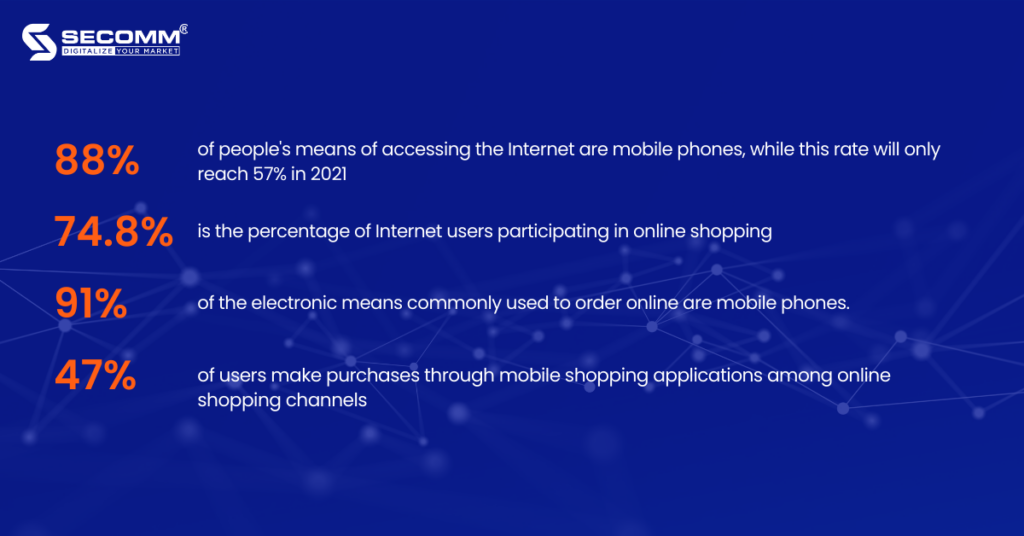
In upcoming years, the percentage of global people and Vietnamese people as well who own mobile devices and use them for online shopping is high and predicted to increase significantly.
Social Commerce
Social commerce refers to the method through which companies advertise and sell goods and services online using social networking sites like Facebook, Instagram, TikTok, Youtube, Zalo, etc. In other words, this type of business combines eCommerce and social media.
The impact of social networks has grown significantly in recent years. Over 59% of the world’s population uses social media, it is not surprising that this percentage will continue to rise.
While in the past businesses used social media to raise brand awareness and draw in new customers, today eCommerce businesses boost sales by offering goods and services to clients online via social media.
As a result, it’s incredibly handy for customers to interact, exchange information, and search and shop online all in one location.
According to Statista, global social commerce sales will reach $992 billion in 2022 and are projected to reach nearly $3 trillion by 2026.
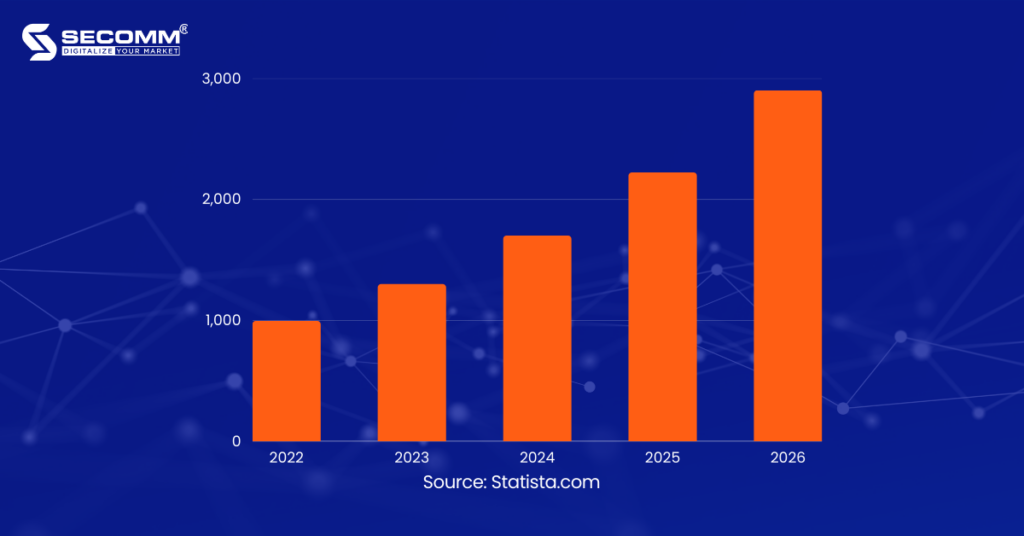
Thanks to the development of social networks, social commerce has had a strong acceleration and has become a magnet for brands to come to approach and analyze a large number of potential customers, and achieve marketing and sales goals.
As a result, failing to prioritize social commerce in enterprises’ marketing strategies in 2023 is probably to lead to a significant loss of competitive advantages in the eCommerce market.
Headless Commerce
Today, businesses have a lot of choices to build an eCommerce website, but basically, the structure of a website will include the following main parts:
- Frontend: Everything the user sees and interacts with when accessing the website including the interface, content, and functions,… is received from the backend.
- Backend: All the active parts of the website or app that are not visible to the user such as the database system, design tools, management tools, and custom functions.
For websites using a traditional structure, the frontend and backend will be operated on the same platform and from there will be closely connected with each other. Therefore, any changes on the website will be edited in two parts at the same time. However, with Headless Commerce, the backend and frontend will be decoupled from each other and operate independently on two separate systems.
The benefits of deploying Headless Commerce:
- Increase customization
- Increase Scalability
- Increase the page load speed
- Seamless integration
- Multi-channel sales support
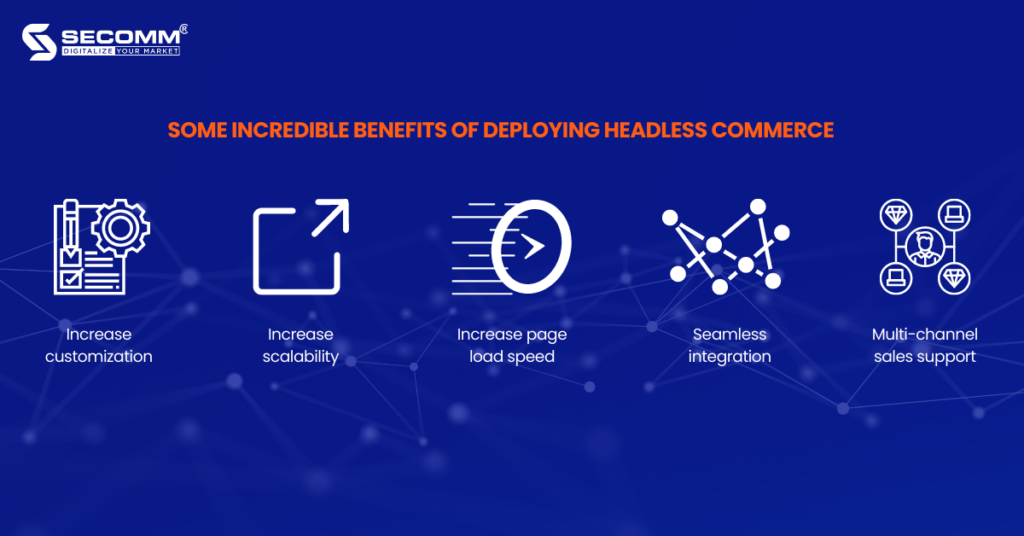
By using the Headless structure, Nike has become a brand with a much larger market share than Adidas – a formidable competitor of Nike.
Moreover, Nike’s website recorded more than 60 million pageviews in just 1 month. In addition, the proportion of direct purchases without intermediaries also increased significantly.
From Nike’s Case Study, one of the practical alternatives for companies looking to encourage eCommerce sales growth is Headless Commerce.
Shoppertainment
Shoppertainment is a form of shopping combined with entertainment that is used as a marketing strategy to encourage customer engagement with brands and consequently increase shopping demand. Moreover, it is used and takes over most of the online commerce in the era of digital transformation, when eCommerce is positioned at the forefront of contemporary business trends.
Some common practices of Shoppertainment trends:
- Live selling
- Shoppable video
- Gamification
These three practices all focus on entertainment and interaction. Then, the emotional element is aroused, leading to a series of unwise and unplanned shopping decisions. From a business perspective, this is beneficial for brands. TikTok‘s recent research proves it:
- In Southeast Asia, 82% of consumers purchase goods from companies they hardly ever use.
- 55% of consumers have made unplanned purchases.
- After watching videos on TikTok, 89% of consumers made unplanned purchases.
- Half of TikTok users confess to finding new brands or products while using the app.
- One in three customers desires to purchase and is satisfied with it.
- One in three customers wants to add fun and entertainment to shopping.
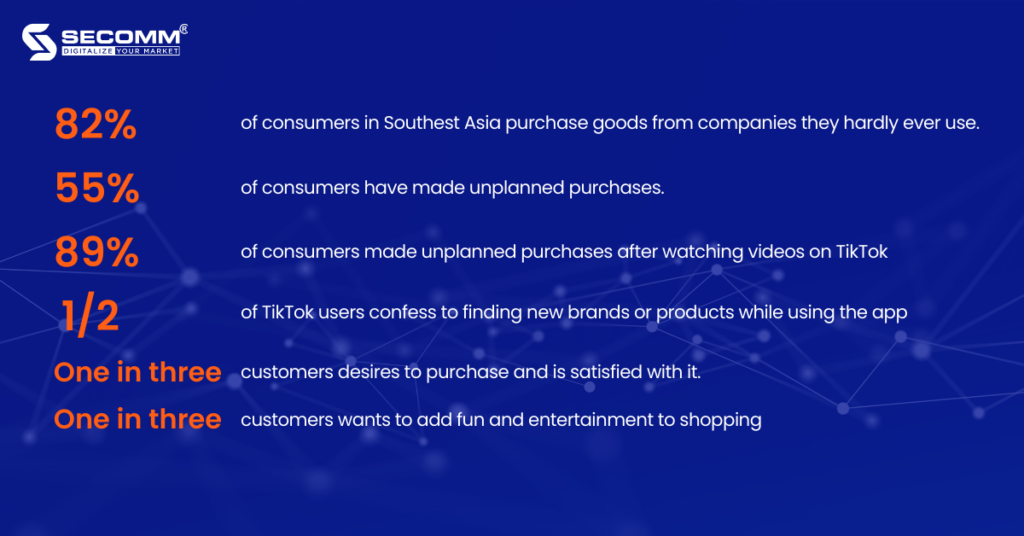
The growth of the Shoppertainment trend in recent years demonstrates the extreme demand for social interaction and connection following the period of Covid’s life.
Shoppertainment is the solution that businesses seek. This is a way to make the most of the customer’s biggest weakness – emotions.
When feelings of euphoria and joy are elicited during the shopping process, customers engage more, and purchase more unplanned products, conversion rates are higher, and sales follow.
AI Technology
Artificial intelligence now has a significant impact on eCommerce businesses in providing solutions to optimize the online shopping experience of customers.
The following statistics demonstrate the incredible influence of AI on the eCommerce market and businesses operating in this field:
- The AI-powered eCommerce market is estimated to reach 16.8 billion USD by 2030 (InsightAce Analytics).
- In the retail eCommerce market, the value of AI is predicted to increase from $1.7 million in 2021 to $36.4 million in 2030 (Precedence Research).
- 78% of brands have used AI for eCommerce websites (Oracle)
- Chatbot’s market value is predicted to reach 3.99 billion USD by 2030 (Grandview Research).
- It is predicted that eCommerce transactions made through Chatbots will reach 112 billion USD in 2023 (Business Solution).
- The cost of using AI Chatbots for customer care is 30% lower than hiring personnel to do this (Business Solution).
- 79% of eCommerce business owners admit that combining AI with marketing and sales helps increase the company’s revenue (McKinsey).
- 54% of businesses in France think that AI is good for analyzing eCommerce data (Statista).
- 70% of eCommerce business leaders in Europe and North America think that AI technology can help optimize customer experience personalization (Statista).
- 37% of users who click on an AI-driven eCommerce recommendation on their first visit to a website, return the next day (Investp).
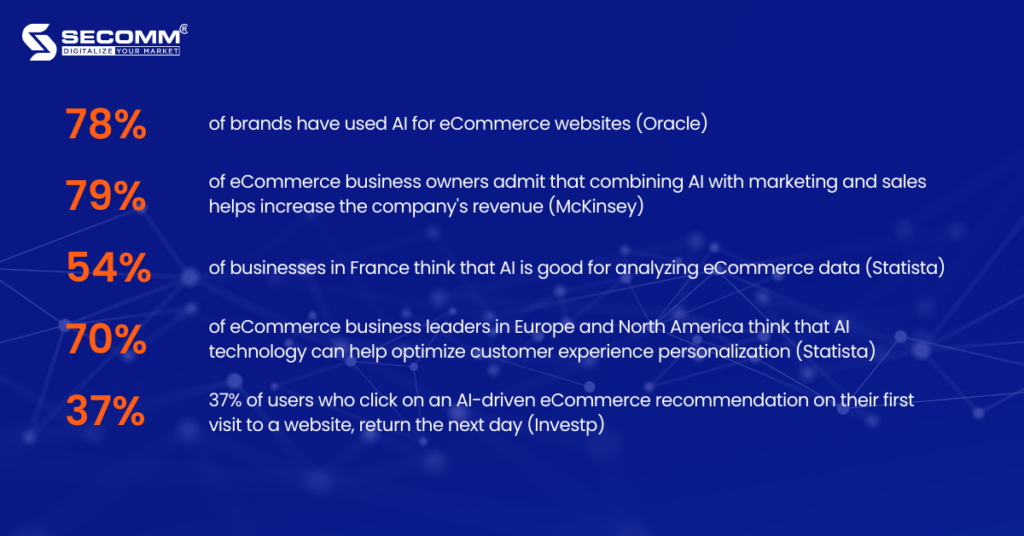
Currently, there are two applications of AI technology that are commonly used in eCommerce:
Chatbots
For eCommerce businesses, Chatbots will be like salespeople who can interact directly with customers 24/7. This helps businesses narrow the distance in terms of geography and time zones, helping the sales and customer services process to take place effectively without interruption.
Personalized Advertising Campaigns
By collecting customer data, AI can create tailored content and recommendations for each specific customer. To improve marketing campaigns and personalize the customer experience, AI can also predict purchasing behavior based on a user’s browsing and search history, when the data is legally available.
VR/AR Technology
VR (Virtual Reality) is a modern technology that brings users into a simulated but still very realistic space with only 3D glasses (virtual reality glasses). The virtual world that the user sees is actually set up and controlled by a highly configurable computer system.
AR (Augmented Reality) is a new technology enhanced from VR technology. This technology has the potential to erase the boundary between the real world and the virtual 3D model. That is, users will experience virtual models in real space through smartphones or computers.
With a clear plan and the appropriate approach, Lazada has been in front of the augmented reality trend for a number of years and developed a certain competitive advantage in luring both consumers and sellers.

In particular, the VTO (Virtual Try On) function on Lazada includes a wealth of features to assist customers in freely selecting and trying goods like eyeshadow, eyeliner, foundation, and cushions whenever and wherever they like.
Since its launch, LazMall brand partners in the cosmetics sector have experienced tremendous success with the VTO function, which has helped to boost conversion rates by 3.1x and average order values by up to 11%.
KOL/KOC
The rapid growth of social networks and eCommerce has given marketing efforts a fresh and original breeze thanks to KOL/KOC. Although KOL and KOC have long existed in some form, they have truly taken off in recent years.
KOL – Key opinion leader, also known as an “influencer”, is an individual or organization with expert product knowledge and influence in their field or industry.
KOC – Key Opinion Consumers are “the most influential consumers in the market”. Their job is to test products and services and make comments and reviews.
KOL will suit mid- to high-end brands, while KOC will suit mid-range brands. If KOL is used to select brand ambassadors, holiday season ambassadors, or product launch campaigns, KOC is used to boost sales in a short time or direct customers to websites or eCommerce platforms.
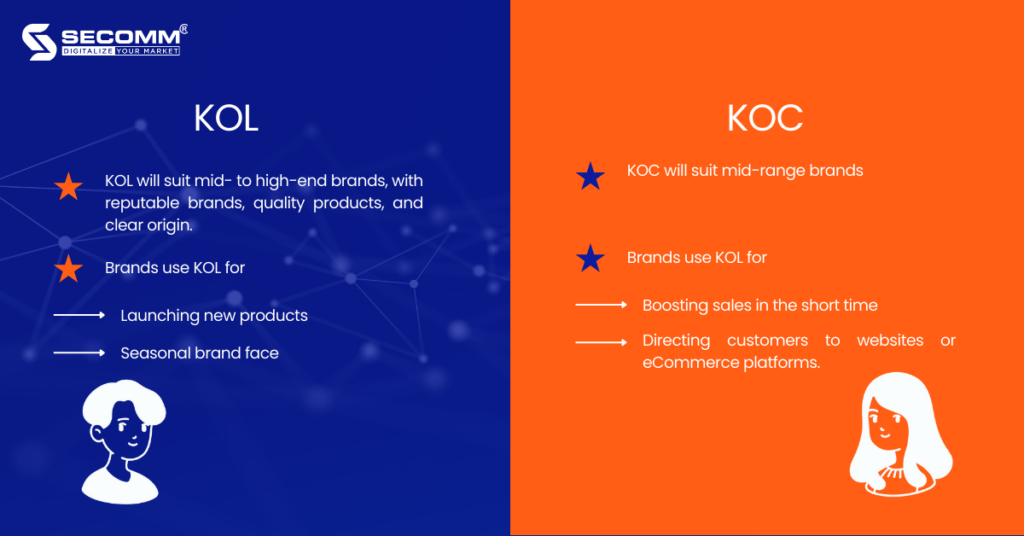
Some famous KOLs in Vietnam: Helly Tong, Giang Oi, Dino Vu, Co em Trendy, Chau Bui, Khanh Vy, Khoai Lang Thang,…
Some famous KOCs in Vietnam: Ha Linh, Call Me Duy, 1m88, Ong Giao Review, Chau Muoi, Hoang Viet, Pu Met 7,…
BOPIS
BOPIS – Buy Online Pick-up In Store is one of the shopping trends that promise to explode in 2023. Customers won’t have to be concerned about shipping costs, extended delivery times, or the risk of receiving unexpected goods when using BOPIS.
Businesses all around the world are pushing up their BOPIS implementation to meet customer expectations when merging online buying with in-person pickup. This is the ideal approach to boost store visits and close the gap between the offline and online buying experiences.
According to GlobeNewswire, the global BOPIS market is projected to reach $703 billion by 2027 with an estimated CARG of 19.3% between 2021-2027.
In addition, the following BOPIS trend statistics can help businesses consider implementing in 2023:
- In the last 6 months of 2022, 67% of US consumers use BOPIS.
- 49% of BOPIS consumers admit to buying more products while in store to pick up their items.
- 65% of customers choose BOPIS to avoid shipping costs.
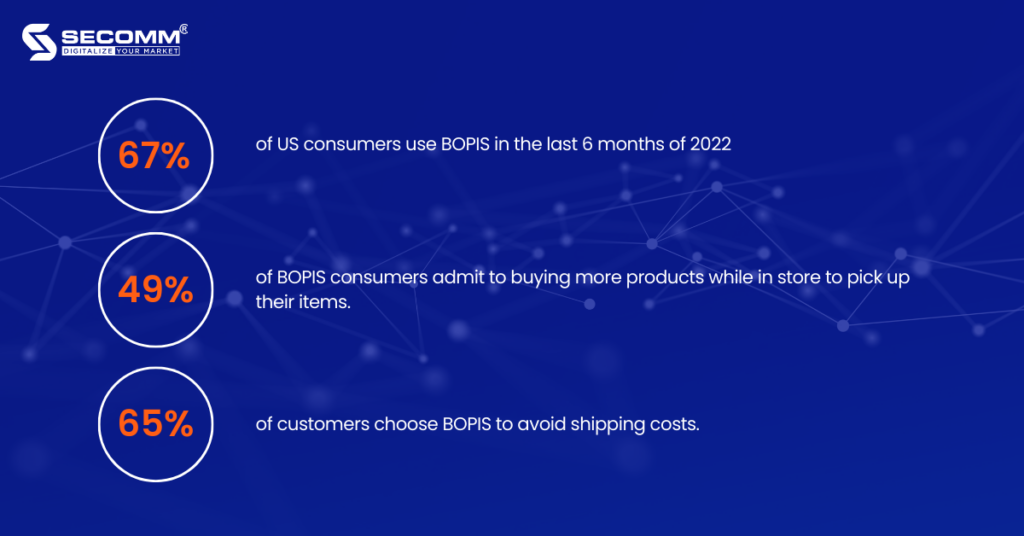
The BOPIS model also aids businesses in cutting expenses, expediting deliveries, boosting demand for retail goods, and lowering the risk of product returns.
UGC
User Generated Content, also known as UGC, includes text, photos, video and reviews. Because people are becoming less and less engaged in the brand’s message over the past ten years, UGC has grown in importance.
According to a recent Salesforce survey, 53% of Millennials think user-generated content (UGC) influences their shopping decisions, and 92% of consumers prefer content created by friends and family over that created by brands. The reason for the above numbers is trust.
Therefore, user-generated content (UGC), such as photos, videos, and customer evaluations, is trustworthy social proof and aids in the development of a company’s reputation.
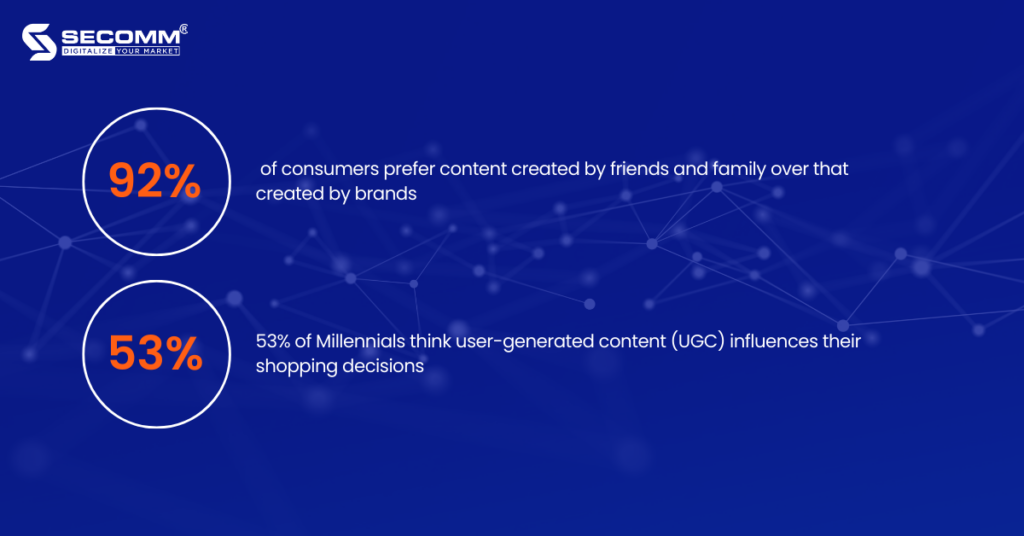
In a nutshell, businesses must quickly adapt to evolving eCommerce and digital technology trends in order to avoid falling behind and being driven out of the market. By reading 10 eCommerce trends that stated and analyzed above, businesses will have an overview to be ready for the new journey.
With many years of experience in successfully implementing eCommerce for many customers in many countries, SECOMM specializes in providing consulting services with comprehensive and professional eCommerce implementation solutions.
Contact SECOMM today for free support and advice.
 2
2

 3,444
3,444

 0
0

 1
1

WINE ECOMMERCE SHINES BRILLIANTLY IN THE DIGITAL ERA
Over time, the Covid-19 pandemic has greatly damaged the world economy, with significant consequences for investors and business owners across a wide range of sectors, including the wine sector.
Sales of alcoholic beverages have decreased dramatically as a result of the closure of hotels, restaurants, and nightclubs as well as the postponement of big events and festivals.
Despite the global economic issues, eCommerce must be considered among the industries that perform very well. Some companies across multiple areas have enthusiastically embraced eCommerce to weather the downturn.
Also, wine firms follow that wave of change, making eCommerce shine in the new era – the era of digital transformation.
Why 2023 is the perfect year to deploy wine eCommerce?
Wine eCommerce growth statistic
- Wine eCommerce sales reached $6 billion in 2021, an increase of 131% compared to 2020. In the two years 2021-2022, online wine sales increased by 4%, while in 2020 they only increased by 2%.
- The online revenue of the wine market reached more than 261 billion USD in 2022 and is expected to grow at 10.51% annually from 2022 to 2025.
- According to IWSR, the global wine eCommerce market value will reach $42 billion by 2024.
- An estimated 1.6% of the total liquor market revenue in 2023 will be generated from online sales.
- The average annual growth rate of wine eCommerce in the US is around 20%.
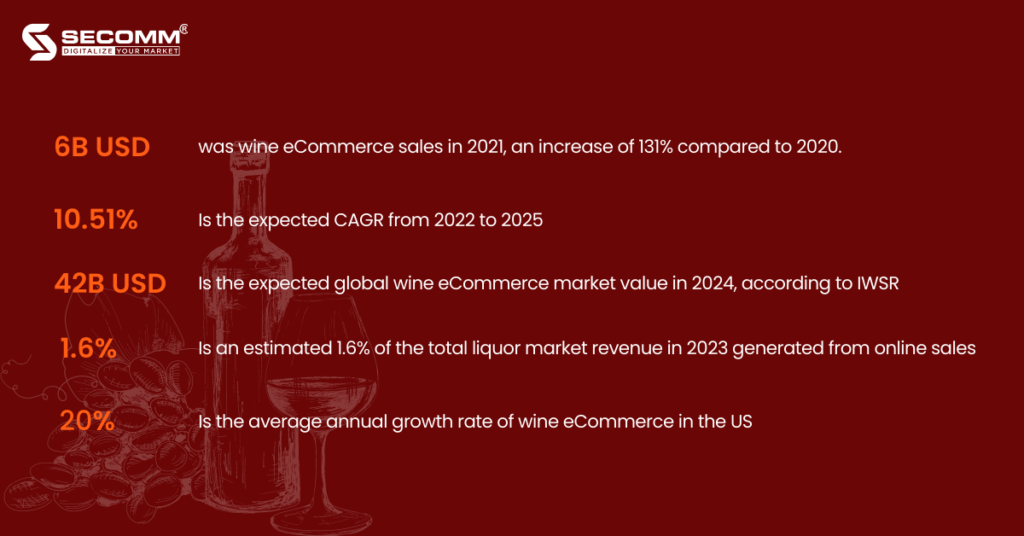
Key drivers of wine eCommerce growth
Global Pandemic
In the midst of the global pandemic-related crises, the wine business, like many others, saw a breakthrough in the speed of online purchasing.
When the pandemic breakout occurred, 44% of American consumers placed their first-ever online wine and liquor orders.
The year 2020 saw a 42% increase in wine eCommerce as a result. Online wine sales increased from just $1 billion in 2018 to $6 billion by 2021.
Young wine consumer
In the US, according to Avalara, Millennials and the legal drinking age population are steadily increasing.
By 2023, the Millennial generation is estimated to account for nearly 45% of the LDA (Legal Drinking Age) population under the age of 80. By 2030, this number is projected to be 54%.
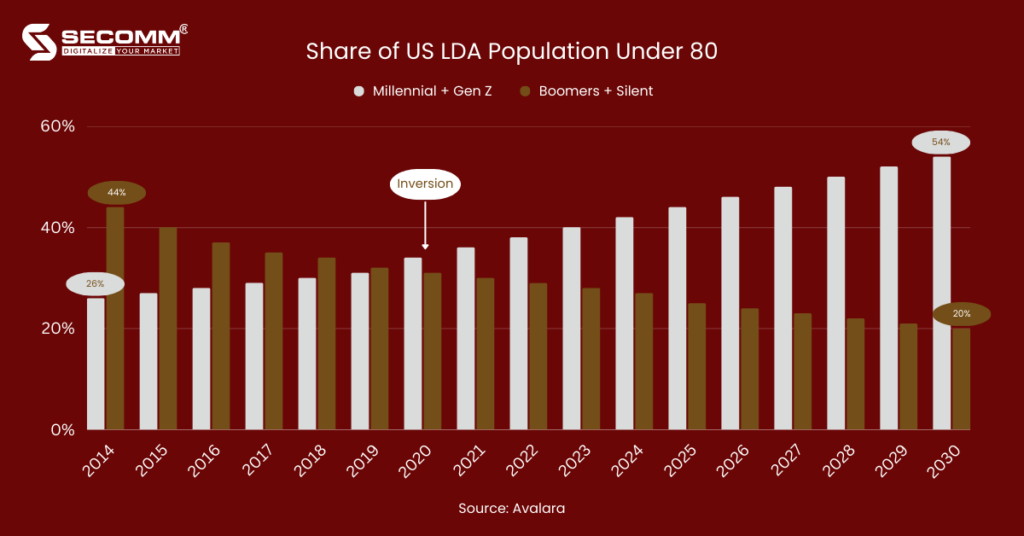
In Vietnam, Millennials (25–38 years old) and Gen Z (18–24 years old), often known as MillennialZ, currently make up 47% of the population or about 45 million people who are of drinking age. The population structure of the MillennialZ generation is expected to keep growing.
The primary factors influencing the growth of the eCommerce sector as well as the digital economy of Vietnam will also be the young people’s awareness of and keeping up with new trends in digital technology compared to previous generations.
Case study
iShop Changi Wines
The Duty Free Shop Group (DFS) and Changi Airport Group (CAG) collaborated on the iShop Changi Wines eCommerce online project, which offers world-renowned and premium wines and spirits with exclusive discounts to visitors to Changi Airport, particularly those who are CAG members.
The iShop Changi Wines website is cutting-edge and exquisitely styled, showcasing the distinctive qualities of the wine industry as well as the aesthetics from page layout, color, font text, logo, and banner, all of which are guaranteed to optimize the purchasing experience while also, and this is crucial, emphasizing the identity and brand-development elements for both CAG and DFS.
Due to the fact that this is a project of well-known companies, the iShop Changi Wines website has consistently received a lot of traffic, averaging approximately 592 thousand views each month since its introduction.
Therefore, to combat the unexpected surge in traffic and orders during the busiest shopping seasons of the year, the eCommerce system must be continually enhanced and optimized.

The fact that major corporations CAG and DFS both started and developed successful wine eCommerce websites shows the enormous potential of this industry now and in the future.
Previously, the business scope of wine businesses was quite limited, but now that limit has been broken thanks to the dominance of the Internet and the rise of eCommerce.
Moreover, the government’s assistance in lowering legal restrictions has given wine producers the assurance to confidently market their goods to a significant number of potential buyers in several nations across the world.
The Warehouse
The Warehouse, established in 2001, is renowned as a top supplier of wines and spirits in Vietnam, offering more than 16 different varieties of wine from numerous nations.
In addition, along with Annam Gourmet Market, Yves Rocher, and Flormar, this is another well-known retail brand of the Nam Group. Before being formally put on the market, products at The Warehouse are consistently inspected and carefully chosen to fulfill quality criteria.
The company has so far increased the reach of its distribution network across the nation, including Ho Chi Minh City, Hanoi, Da Nang, Nha Trang, Hoi An, Quang Ninh, and Phu Quoc.
The Warehouse achieved its objective of serving the wine market with B2B and B2C business models by utilizing the Magento platform.
This implies that the business will broaden the retail channel to include private customers in addition to distributing wines to restaurants, hotels, resorts, pubs, and lounges.
A series of symbols, logos, and banners created especially to fit the characteristics of the wine industry are combined with Bordeaux red to create a website interface that is focused on UI/UX perfection.

The Warehouse is flexible, secure, and has quick ordering, payment, and delivery options. Therefore, customers can place orders through phone, mobile app, or eCommerce website.
Customers can then pick up their purchases from the store or, in major cities like HCM, Hanoi, and Da Nang, the company will deliver them quickly within 2 to 3 hours. In other places, conventional courier delivery takes 2 to 5 days.
The Warehouse has been successful in raising brand recognition, expanding its customer base, and increasing both offline and online sales as a result of the timely growth of its business model and digital transformation
Trentham Estate
Long-standing Australian company Trentham Estate Winery, founded in 1988, focuses on the manufacture and distribution of wine.
After many years in business, the company is well regarded for its creativity in the wine-making process, which resulted in a variety of wines with different delicious flavors. Also, the brand has received hundreds of medals, titles, and other industry awards.
In the beginning, the business created and ran a WordPress website system for branding purposes.
Trentham Estate, however, has been forced to increase its company scale by making a substantial investment in an entire eCommerce website system due to the growth of eCommerce and the increasingly varied purchasing needs of potential clients.

In the beginning, the business created and ran a WordPress website system for branding purposes. Trentham Estate, however, has been forced to increase its company scale by making a substantial investment in an entire eCommerce website system due to the growth of eCommerce and the increasingly varied purchasing needs of potential clients.
That is what led to the creation of the website trenthamestate.com.au, which has a modern interface while still accurately capturing the distinctive features of the wine industry.
Similar to The Warehouse, Trentham Estate likewise creates an eCommerce website based on the Magento platform with a variety of features that satisfies eCommerce requirements and wine industry specifics.
Therefore, businesses can access and serve a wide range of large customer files not only in Australia and internationally thanks to effective marketing and branding strategies, towards a sustainable business model along with the changes of the digital age.
It would be hard to believe that an industry as sensitive as wine could be traded online so easily and efficiently. In that efficiency and convenience, there is a great contribution of the trend of eCommerce and the comprehensive National Digital Transformation program that is committed to supporting by the Government. This is an extremely appropriate time for wine businesses to confidently deploy eCommerce because of the support from the Government and the push from the market.
However, planning to implementation are two completely different categories. Businesses are required to have a practical strategy and technical assistance from highly skilled firms to hasten the success journey and help advance the National Digital Transformation goal.
SECOMM has many years of expertise in effectively executing eCommerce for numerous customers in various countries. We specialize in offering free consultation services with qualified eCommerce implementation solutions.
Contact us right away for free counsel and assistance.
 2
2

 2,715
2,715

 0
0

 1
1
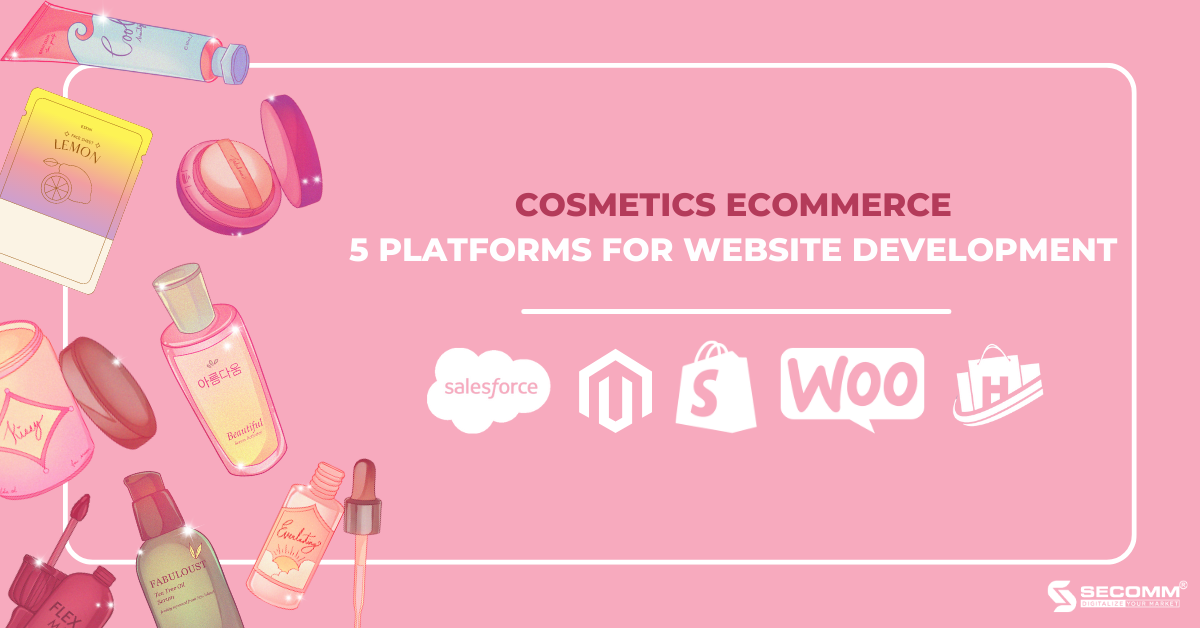
COSMETICS ECOMMERCE: 5 PLATFORMS FOR WEBSITE DEVELOPMENT
Cosmetics eCommerce is currently developing into a fresh and promising sales channel for companies in addition to the traditional sales channel. Businesses must work hard to sustain and achieve breakthrough growth through eCommerce platforms, though.
As a result, numerous cosmetics companies started developing online cosmetics business websites and found surprising success, such as Kylie Cosmetics, Hasaki, and Guardian,…
These websites’ success can be attributed to their early selection of an adequate and suitable eCommerce platform. Which platforms are appropriate for the cosmetics industry, then?
Salesforce Commerce Cloud
Salesforce Commerce Cloud (SFCC) is a highly flexible SaaS eCommerce platform that allows companies to offer the best B2B and B2C shopping experiences. Moreover, Salesforce gives Commerce Cloud access to Einstein AI to further enhance this system’s intelligence.
Top cosmetic brands currently using Salesforce Commerce Cloud to deploy eCommerce include L’Occitane, Lancôme, Loreal, Nars, Neutrogena, NYX Cosmetics, and Shiseido,…

Pros:
- SFCC offers a flexible and scalable hosting infrastructure as a cloud-based SaaS platform, and this vendor will be in charge of configuration, updates, maintenance, security, etc., helping users save time and money in these areas.
- Since SFCC is practically a ready-made solution, businesses only need to express their ideas, and SFCC’s IT team will develop them in a matter of weeks.
- The amazingly functional system supports cosmetic eCommerce businesses by allowing customers to select product sizes, purchase items in sets, take advantage of shock deals and flash sales, and receive new customer discounts and loyalty points.
- Unlike other SaaS platforms, SFCC scales and manages traffic spikes for sales seasons and other unplanned events with ease.
- Synchronizing sales channels, reaching, and serving clients across many channels are made possible by omnichannel solutions for the cosmetics industry.
Cons:
- Developers and businesses are required extensive SFCC understanding.
- SFCC charges users on a revenue-based model. Depending on the selected plan package, customers will pay 1 or 2% GMV (Gross Merchandise Value) to preserve website ownership. This means that the higher the revenue, the more expenses must be paid to SFCC.
- Limited integration with 3rd party services.
=> SFCC is suitable for B2C and B2B cosmetic businesses.
Magento
Magento is a popular open-source commerce platform in the field of eCommerce, with nearly 200,000 websites in use. Currently, Magento has 2 versions: Magento Open Source (free), and Magento Commerce (paid).
Cosmetic eCommerce websites built successfully on the Magento platform with high brand awareness include Laneige, Sigma Beauty, and Hasaki,…

Pros:
- Many cosmetics themes from the global developer community and Magento website developers so businesses can use existing themes which easy to customize or use self-designed themes.
- Functional systems from basic to advanced, specialized for the cosmetic industry such as choosing product size, buying in sets, exclusive deals, product suggestions, viewed products, member incentives, etc.
- Due to its comprehensive customization options, Magento enables businesses to fully own, control, and customize the source code, facilitating the efficient operation of systems. Moreover, Magento may be customized to fit the eCommerce requirements of enterprises of various sizes.
- Highly scalable, beneficial for future system expansion, and featuring multiple sites, stores, languages, and currencies.
- Because Magento is a complete eCommerce system, it can guarantee smooth operation and minimize potential dangers from data systems and transaction processes, resulting in high security. As a result, the reputation of the website, system safety, and user rights are all improved.
- There is a huge skilled Magento developer community present worldwide, ready to help with technical issues as well as provide assistance in creating eCommerce solutions appropriate for each business model.
Cons:
- There is no repository of themes from Magento to support businesses.
- Implementation typically takes three to six months, but it might take up to a year due to a sophisticated functioning system.
- Although the platform is free to use, the cost of implementing eCommerce with Magento is quite high, about $50,000-$100,000 depending on the complexity of the project.
=> Magento is appropriate for a range of cosmetics business types, including B2B, B2C, and B2B2C, as well as for various business sizes, including start-ups, SMEs, and major companies. However, large organizations use Magento because it is frequently relatively expensive to deploy.
WooCommerce
WooCommerce is a free WordPress plugin that allows businesses to transform a regular WordPress website into a professional eCommerce website with full features and easy customization with just a few simple steps.
A few good examples of big brands that have built successful eCommerce websites with WooCommerce and generated huge sales such as: MOI Cosmetics, Bo Shop, Nuty Cosmetics, AB Beauty World, Beauty Garden,. ..

Pros:
- There are many free and premium themes from the WordPress and WooCommerce communities for the cosmetics sector which are easy to customize or businesses can use self-designed themes.
- Functional systems from basic to advanced for cosmetic eCommerce business such as similar product suggestions, viewed products, discount vouchers, and new customer incentives,…
- Easy integration with a variety of 3rd party services.
- The cost of building an eCommerce website is not too high compared to other open-source platforms like Magento, with total annual costs ranging from $110 to $1,500+ for domains, hosting, themes, extensions, plugins, etc.
- eCommerce website implementation time with WooCommerce takes about 1 to 3 months to complete.
Cons:
- The functional system is still limited in terms of features specific to the cosmetics industry.
- The scalability is not as high compared to other open-source platforms such as Open Cart, and Magento because it depends on the WordPress system.
=> WooCommerce will be suitable for cosmetics businesses that are familiar with the WordPress platform and want to develop an eCommerce system.
Shopify
Shopify is a popular SaaS platform in the world that provides a variety of solutions for businesses of all sizes to successfully build eCommerce websites. After being in the market for about 20 years, Shopify has gradually grown to become one of the top eCommerce platforms in the world, trusted by many Vietnamese and foreign companies.
Kylie Cosmetics, Innisfree, Sulwhasoo, Cho Tinh Cua Boo, Guardian, and Ofélia are some examples of companies in the cosmetics industry leveraging Shopify for eCommerce websites and enjoying great success.

Pros:
- Available and diverse themes for the cosmetics industry.
- Functional system from basic to advanced, supporting eCommerce business such as similar product suggestions, viewed products, discount vouchers, and new customer incentives.
- The initial cost is quite reasonable with a variety of options for businesses from $29/month to about $2,000/month.
- The time to build an eCommerce website is quite fast from 1-7 days, or more depending on the complexity of the system.
- Shopify has a large developer community to serve businesses.
Cons:
- The layout of existing templates causes duplicating, and it’s challenging to alter themes or create your own interface because doing so will have an adverse effect on the entire system.
- The system of specific functions for the cosmetics sector is still limited.
- A wider range of 3rd party services but still only integrated with services available in Shopify’s app store.
- Deployment costs are both advantages and disadvantages of Shopify when the initial cost is quite reasonable, but in the long run, businesses have to pay the cost of using the platform, interface, application, etc., regularly every month. This makes it difficult to manage cash flow.
- Because it is a SaaS platform, it will be difficult for Shopify to expand its website in the future.
=> Shopify is considered suitable for start-ups or SMEs with global operations.
Haravan
Haravan is a leading technology firm in Vietnam, that was founded in 2014, with the intention of eventually extending to many other Southeast Asian nations.
It specializes in offering businesses and merchants in Vietnam solutions for eCommerce, engagement marketing, and omnichannel retail.
Haravan has gained the trust of many companies in the cosmetics industry as a result of the efficiency of the website system that the business has created and the ground-breaking online retail sales.
The Face Shop, The World of Lipsticks, The World Skin Food, and Lam Thao Cosmetics are some well-known cosmetics companies in Vietnam that have launched eCommerce websites using the Haravan platform.

Pros:
- Available and diverse themes for the cosmetics industry.
- Wide range of applications, from basic to advanced to start an eCommerce business.
- Reasonable eCommerce deployment cost, various packages from 200,000 VND/month to 3,000,000 VND/month, making it easy for customers to choose.
- The time to build an eCommerce website is fast, only about 30 minutes for businesses to own a website with all the necessary features to get started. However, for the website to work effectively, businesses need to spend more time researching and developing the system.
Cons:
- The layout of existing templates causes duplicating, and it’s challenging to alter themes or create your own interface because doing so will have an adverse effect on the entire system.
- The system of specific functions for the cosmetics sector is still limited.
- Only integrated with services/utilities located in Haravan’s ecosystem.
- Because it is a SaaS platform, it will be difficult for Haravan to expand the website in the future.
=> Haravan is suitable for start-up cosmetics businesses or SMEs (small and medium-sized enterprises) with operations mainly in Vietnam.
An extremely critical first step in developing a cosmetic eCommerce website is selecting the appropriate platform. Businesses may develop websites more quickly and affordably while enhancing their competitive advantage and sustainable growth by choosing the right eCommerce platform.
The improper platform, on the other hand, will cost firms a lot of money and effort to adopt and switch platforms repeatedly. Therefore, in order to select the best platform, organizations must take into account the objectives and issues with the current model.
With many years of experience in successfully implementing eCommerce for many customers in many countries, SECOMM specializes in providing consulting services with comprehensive and professional eCommerce implementation solutions.
Contact SECOMM today for free support and advice.
 2
2

 1,531
1,531

 0
0

 1
1
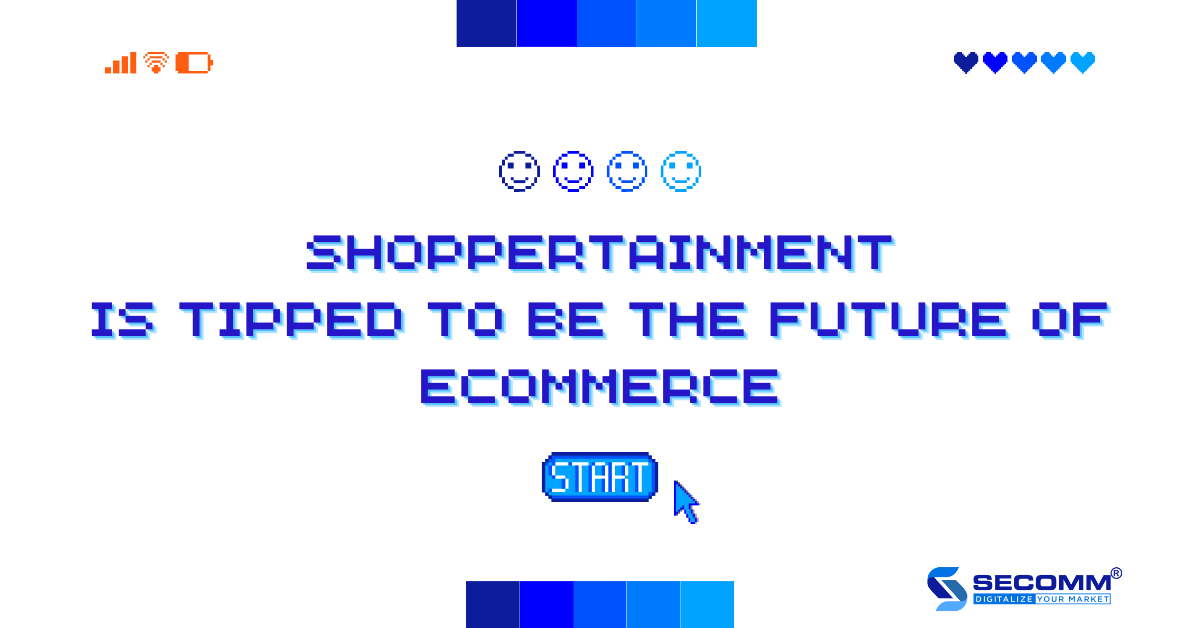
SHOPPERTAINMENT IS TIPPED TO BE THE FUTURE OF ECOMMERCE
The Covid-19 pandemic not only encourages the tremendous growth of eCommerce but also helps shift consumers’ priorities from in-store to online buying. However, instead of just buying, consumers frequently prefer to seek out novel, inspiring experiences.
Therefore, every company should strive to implement the approach of shopping combined with entertainment (Shoppertainment) in order to improve marketing effectiveness and boost sales.
What is Shoppertainment?
Shoppertainment is a combination of two elements “shopper/shopping” and “entertainment”.
Shoppertainment is described as “the provision of recreational or leisure facilities within or next to a retail store or shopping center, as part of a marketing strategy, which is designed to attract customers and stimulate purchasing” in the Oxford Dictionary (1990).
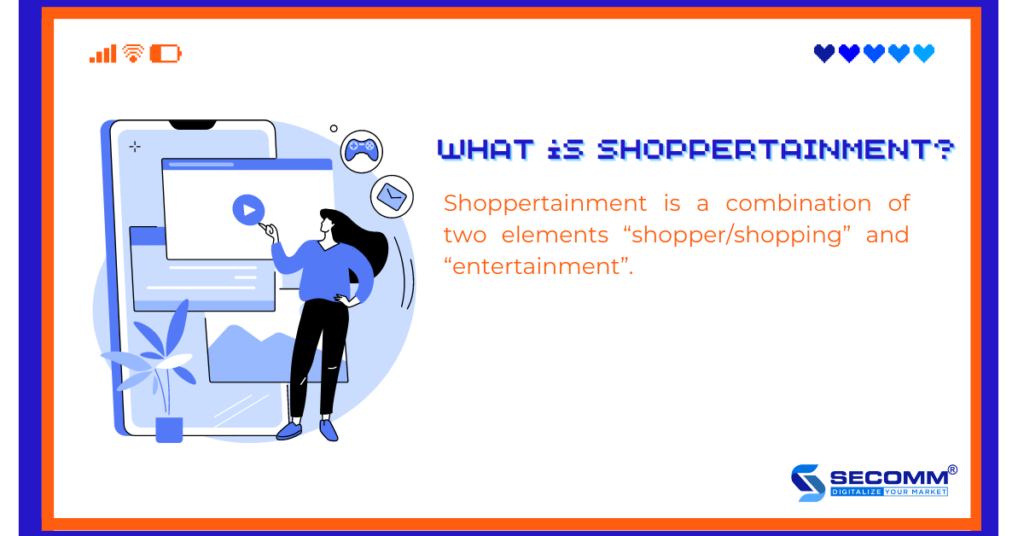
Many companies, notably IKEA, the biggest furniture retailer in the world, have used shoppertainment with success in the past. IKEA launched a campaign in 2019 called “IKEA nightclub – Tonight is to sleep” for 100 lucky individuals.
During this campaign, customers can partake in activities like manicures, massages, snacks, and tea instead of cocktails before spending the night in rooms with IKEA furniture that is soon to be released.
The brand has had remarkable sales success thanks to the campaign’s resonance in North America.
The shoppertainment trend, however, is no longer just restricted to stores or other physical locations thanks to the growth of eCommerce and digital marketing but has instead gained popularity and taken over online shopping activities.
In comparison to the prior definition, shoppertainment has been enlarged and changed. Shoppertainment is a trend that combines online shopping with entertainment, allowing buyers to engage with merchants in addition to purchasing products as usual.
In Vietnam and in the Asia-Pacific region, certain forms of entertainment-infused shopping are very common. Examples include live streaming, shoppable videos, and gamification.
What role does shoppertainment play in eCommerce?
According to the Vietnam eCommerce White Paper 2022, the size of the retail eCommerce market in Vietnam will increase from $11.8 billion in 2020 to $13.7 billion in 2021 and is estimated to reach 16.4 billion USD in 2022.
Meanwhile, the percentage of consumers shopping online on eCommerce websites is 78% in 2021, up 4% over the same period last year.
Because of the urgency, lack of options, and social isolation, the effects of the epidemic have actually contributed to a change in consumption tendencies from in-person purchases to online purchases.
Since that time, it has seen the quick decline of the conventional commerce model and the rise of eCommerce. By 2026, Statista projects that eCommerce sales will total $8.1 trillion.
Additionally, it is not surprising that consumers like shoppertainment. Although this combination is not novel, it promises to set the consumption trend in the years to come as eCommerce takes center stage.
The demand for online shopping will be higher there, and expectations for the best shopping experience—including both online shopping and fascinating experiences will also be higher.
Retail businesses around the world have seen a significant rise in sales during the outbreak by combining online shopping with live streams, entertainment videos, and video games to create real-time digital interactions with customers.
For instance, Taobao Live, which Alibaba introduced in 2016, saw a 150% surge in sales in 2020 when the epidemic first appeared in China.
“Shoppertainment is now a basic expectation. You really have to leverage engaging tools so the shopper gets to learn about the product, its superiority, and has fun along the way,” notes Alex Vogler, senior director and head of marketing, eBusiness, Procter & Gamble (P&G) Asia, Middle East, and Africa.
The Covid-19 pandemic has had a significant negative impact on the human psyche, causing issues including depression and anxiety. On the other hand, a portion of the populace said that the social connections they were unable to have prior to the epidemic significantly improved their psychological well-being.
People need to connect with the community and others like them more than just for amusement. Brands have therefore concentrated on improving the consumer experience by transforming personal experiences into shared ones that bring communities together.
As an example, consider the hashtag #TikTokMadeMeBuyIt. Through the TikTok platform, users can easily and amusingly share their shopping experiences, resulting in videos going viral and receiving more than 4.5 billion views.
Shoppertainment will result in emotional and impulsive purchasing decisions since it emphasizes entertainment and connection. According to a recent TikTok research:
- In Southeast Asia, 82% of consumers purchase goods from companies they hardly ever use.
- 55% of consumers have made unplanned purchases.
- After watching videos on TikTok, 89% of consumers made unplanned purchases.
- Half of TikTok users confess to finding new brands or products while using the app.
- One in three customers desires to purchase and is satisfied with it.
- One in three customers wants to add fun and entertainment to shopping.
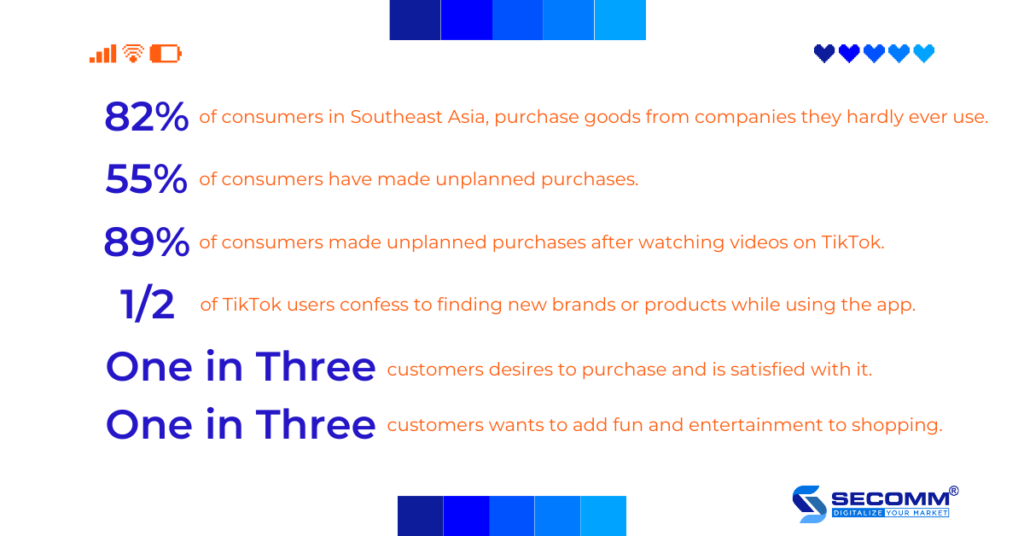
The studies mentioned above demonstrated the enormous influence that social networks and online shopping trends have on consumer decisions.
Because of this, Vietnamese retail companies have prioritized shoppertainment in their marketing plans.
Customers demand a more social and engaging online shopping experience, as well as the ability to connect and converse with one another while buying, which is the reason for any of this.
Best Shoppertainment practices
Live Selling
In recent years, both buyers and sellers in the Asia-Pacific (APAC) area have grown accustomed to live selling. Live selling is less common in the US and Europe than it is in APAC, but businesses there are nonetheless keeping an eye on this trend.
For instance, AliExpress initially introduced the live selling feature in France in May 2020, and since then, more than 3,000 live programs have been launched, with the involvement of more than 100 vendors.
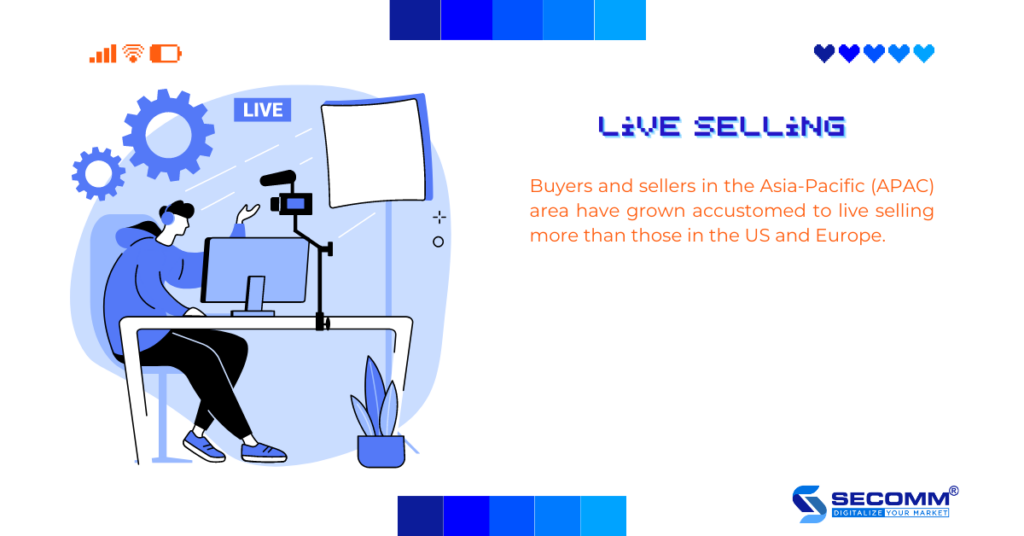
The combination of sales, interaction, and entertainment makes this one of the top social selling strategies. Customers can interact with vendors directly, view actual product photos, and make decisions by pushing their shopping emotions.
Plus, the engaging social interactions that take place throughout live streaming help retailers make an impact on customers, resulting in a high return rate.
Due to the growth of the Shoppertainment trend and the effectiveness of live streaming in generating sales through social networks, eCommerce marketplaces have started to put more of an emphasis on investing in producing engaging entertainment material for users on their apps, particularly through live streaming.
The customer buying experience is improved by several well-known live stream channels, like TaobaoLive, LazLive, Shopee Live, TikiLive, etc.
These companies have the resources to develop this feature for themselves, but lower-budgeted companies can still try the live-selling concept by integrating Facebook or YouTube live stream with an eCommerce website.
Shoppable Video
Live-streaming videos will be effectively replaced by shoppable videos. One of the joys of using this type of video is that companies may produce videos in their own distinctive styles that quickly introduce customers to their products, explain how they operate, and demonstrate how to use them. These videos can be attached to an eCommerce website. Users can always click the product link in this kind of short video to find out extra details or to make a purchase. The short-form video has overtaken popular platforms like TikTok, Instagram Reels, and Youtube Shorts as the go-to method for branding, cultivating customer trust, and influencing purchasing decisions.
83% of people, according to Nielsen study, prefer watching videos of advertisements to GIFs or text. Short-form videos have gained popularity as a result of global digital transformation and consumer preference, and many brands now opt to use those as part of their video marketing strategies due to their useful advantages, which include the following:
- Simplify the customer journey
- Increase customer engagement
- Improve the conversion rates
- Get a boost in sales
- Create brand loyalty
- Build a better customer experience
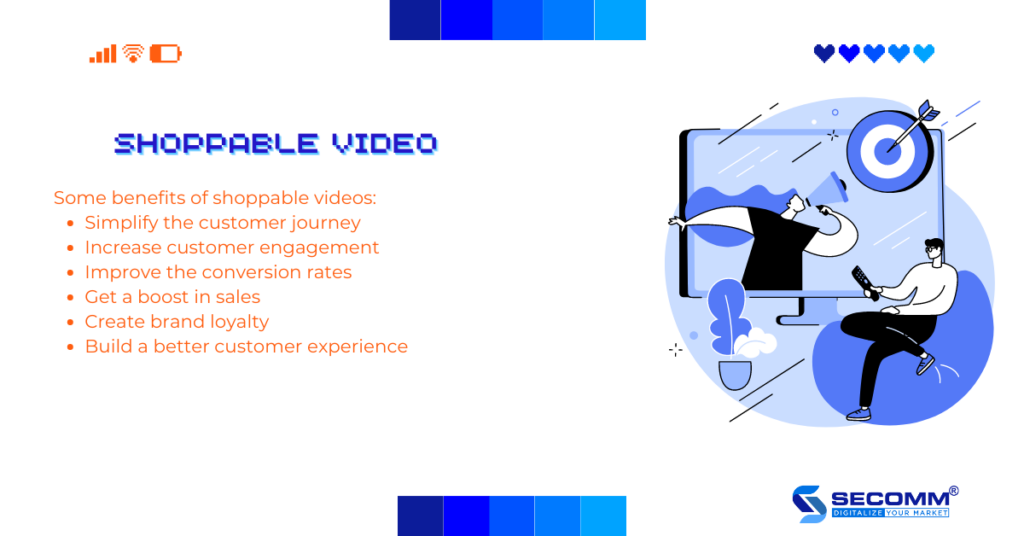
Gamification
Gamification or Gamification Marketing is the skillful incorporation of a video game’s mechanics into promotional operations in a unique and impressive method to meet marketing objectives.
Gamification’s primary advantage, similar to live selling, is engagement, which keeps people on the site, drives conversions, and boosts sales.
Users are actually more likely to return for more shopping if a business can convince them that engaging with it is an interesting experience rather than a transaction.
A study by Bazaar Voice demonstrates the impact of gamification on businesses’ marketing strategies as follows:
- 70% of shoppers want gaming elements incorporated into online shopping.
- But only 42% of shoppers enjoy gaming in-store.
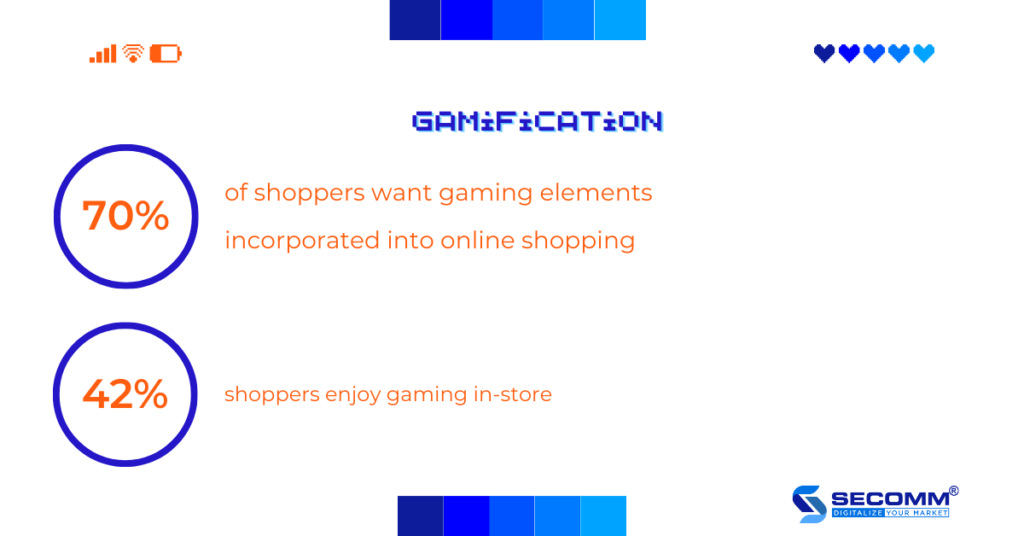
For instance, take Bajaj Finserv’s Indian financial company’s Gamification Marketing campaign. The game was created by this firm to encourage people to use its travel loan services.
Users will complete tasks and respond to questions about their preferred travel destinations. Customers adored the campaign, and it immediately trended on Twitter with more than 75 million impressions.
Thus demonstrating Bajaj Finserv’s efforts to develop engaging experiences and provide them to customers in line with its marketing strategy. Brands attract more potential customers, enjoy the better engagement, and increase conversions as a result of the viral impact.
Shoppertainment has been around for a while, but it wasn’t until Covid-19’s effect that this trend truly took off. Businesses should take advantage of this trend to improve the online shopping experience for customers and increase sales in the era of eCommerce.
Due to the growing demands of customers for a better shopping experience and the ongoing changes in the market, achieving this goal is difficult and labor-intensive. As a result, companies must work with expert agencies to plan the proper eCommerce deployment from the start.
With many years of experience in successfully implementing eCommerce for many customers in many countries, SECOMM specializes in providing consulting services with comprehensive and professional eCommerce implementation solutions.
Contact SECOMM today for free support and advice.
 3
3

 3,477
3,477

 0
0

 1
1

3 KEY FACTORS MAKE NATIONAL DIGITAL TRANSFORMATION SUCCESSFUL
When the Prime Minister approved the “National Digital Transformation Program to 2025, with a vision to 2030,” national digital transformation became formally a goal shared by the entire Vietnamese people in 2020.
Since then, localities, ministries, branches, and even the government have all gradually incorporated the term “Digital Transformation” and applications of digital technology into their everyday activities.
Thus, we all realize the significance and impact of the digital transformation trend. What essential elements, nevertheless, determine the National Digital Transformation Program’s success or failure?
Overview
What is Digital Transformation?
The process of using digital technology to completely alter each person’s lifestyle, each company’s business model, and each nation’s government operations in order to create new values and prospects for future development is referred to as transformation, also known as digital transformation.
Today, all businesses, big and small, have to decide whether to embrace innovation or risk lagging behind, becoming ineffective, and going out of business.
Furthermore, digital transformation involves- not just comprehending and utilizing technology but, more importantly, reinventing the complete business strategy as well as the vision and development priorities of the nation in relation to the global development trend.
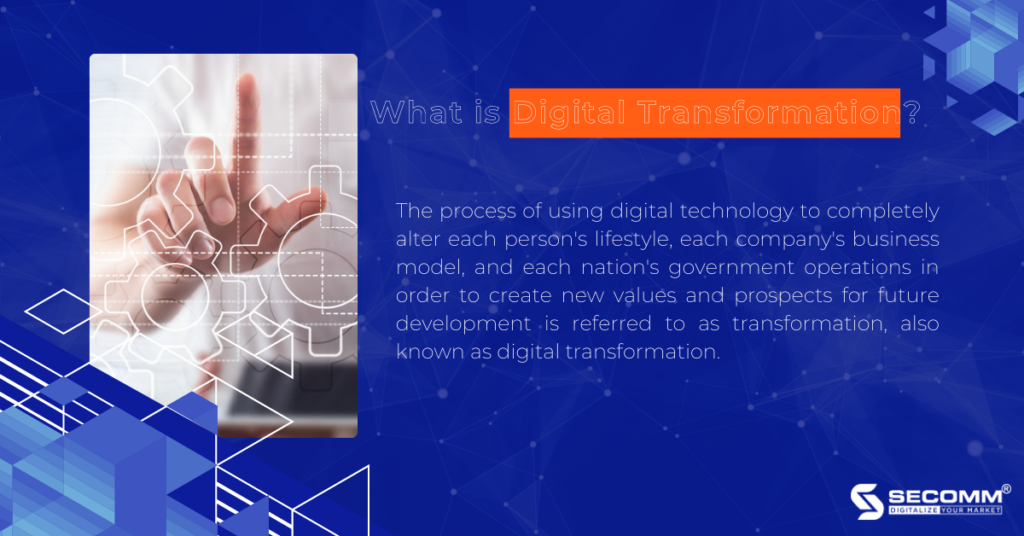
According to data from Mordor Intelligence, the digital transformation age is shining in practically “every nook” of the global economy, confirming that this is not a “soon to fade” trend but rather a new and sustainable development orientation following the pandemic crisis.
- The estimated value of the global market for digital transformation is $998.99 billion in 2022 and is expected to reach $2744.68 billion by 2026. The compound annual growth is 17.42%.
- Global spending on digital transformation is expected to reach $1.6 trillion by the end of 2022 and surpass $3.4 trillion by 2026.
- Over 90% of global businesses, both large and small, are adopting digital initiatives.
- 97% of business executives say the COVID-19 pandemic has spurred digital transformation efforts.
- 95% of startups have a digital business plan compared to 87% of traditional, established companies.
- According to statistics, currently, only 13% of jobs do not require digital skills, and 33% are jobs that require proficiency and advanced digital skills.
In Vietnam alone, the government has established a National Digital Transformation Program for 2025, with a vision to 2030, with particular targets to shorten the distance with other countries around the world, including:
- 80% of online public services at level 4 are performed on mobile devices.
- 90% of work records at ministerial and provincial levels are online while 80 percent of work records at the district level and 60 percent of work records at the commune level are processed online.
- All national databases including those for population, land, business registration, finance, and insurance are online and connected, with shared data on a government reporting information system.
- 50% of banking operations by customers are to be fully online.
- 50% of the population has a digital checking account.
- 70% of customer transactions are made through digital channels.
- 50% of decisions on lending, small and consumer loans of individual customers made digitally and are automated.
- The digital economy accounts for 20% of GDP.
- The rate of the digital economy in each industry, and each field accounts for at least 10%, and labor productivity increases by at least 7%.
- Vietnam is among the top 50 leading countries in information technology, the top 30 countries in innovation, and the top 50 countries on the competitiveness index.
- Fiber optic network infrastructure covers 80% of households and 100% of communes.
- Universalize 4G/5G mobile networks and use smartphones in remote areas.
- The percentage of the population with electronic payment accounts is over 50%
Why is Digital Transformation important?
The fact that the goals are stated in great detail in the national digital transformation program with a focus on 2030 demonstrates how seriously the Vietnamese government takes the significance of digital transformation for the prosperous growth of the nation.
Think about the global Industrial Revolution 4.0 wave that is currently in motion. With the aid of connection provided by the Internet of Things (IoT), real-time data access, and the introduction of cyber-physical systems, the Industrial Revolution 4.0, also known as Industry 4.0, primarily focuses on advancing modern digital technology to an entirely new level.
Every Government, organization, corporation, and individual throughout the world must transform its business model, and the manner of working from non-digital to digital operation, in order to keep up with this current technology and immerse itself in the Industry 4.0 wave. The name of this procedure is “digital transformation”.
Vietnam, despite having a minor economy compared to other countries, is a crucial part of the massive Industrial Revolution 4.0 that is currently underway. Vietnam must therefore undergo a digital transformation in order to compete.
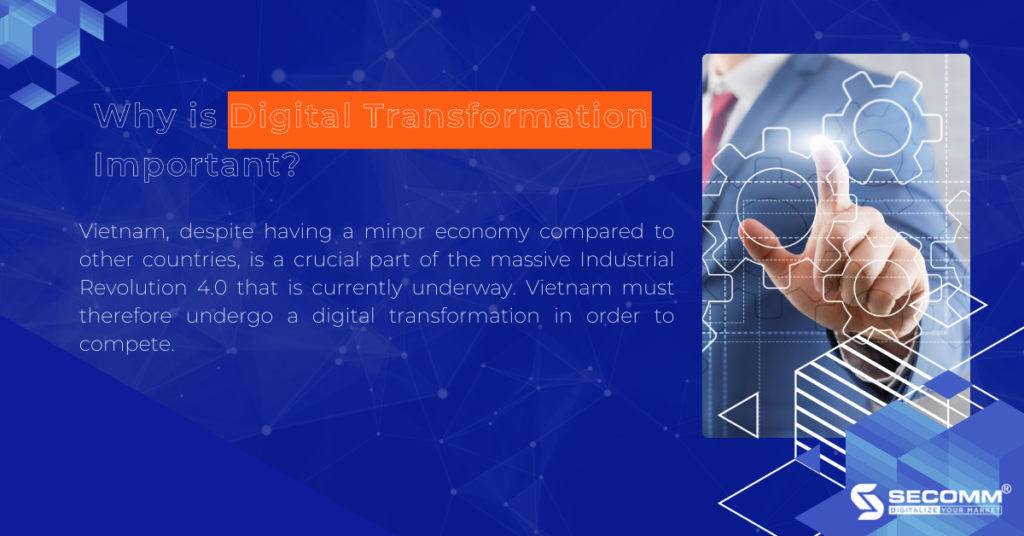
The goal will be challenging to accomplish if just businesses execute digital transformation because the capital and costs are quite high; therefore, businesses require assistance from the government budget and outside finance.
On the other hand, even with a massive budget, it can be challenging for businesses to implement effective digital transformation if the government does not go digital, but continues to run in the old manner, handles administrative procedures slowly, lacks direction, and supports businesses clearly and methodically.
Furthermore, without the support of the people, the National Digital Transformation process to catch up with the global Industry 4.0 wave will be impossible. However, the public needs the government to inform, direct, and inspire digital transformation.
Also, businesses must create useful digital transformation strategies that both before and after implementation considerably raise people’s quality of life.
Vietnam must structure three main areas of digital transformation: the government, businesses, and people, or in other words, the digital government, digital economy, and digital society, if national digital transformation is the outcome it seeks to achieve in order to gradually join the Industrial Revolution 4.0.
These three crucial overlapping and interdependent relationships make up the National Digital Transformation.
The current state of Vietnam’s National Digital Transformation
Throughout the earlier years, Vinasa reports that in 2019, 40.6% of organizations and businesses confirmed that they have resources available for digital transformation and that 23.6% of them are putting it into practice. However, 30.7% of them are uncertain of what to do despite doing some research, and 38% are unsure of where to begin.
Due to the Prime Minister’s approval of the “National Digital Transformation Program to 2025, with a vision to 2030” and the abrupt change brought on by the impact of the global pandemic, Digital Transformation is now regarded as the process’ starting year. This makes it a top priority to maintain Vietnam’s economy.
The government and Vietnamese enterprises have been able to promote awareness of the importance and urgency of digital transformation in order to help the country overcome the obstacle thanks to the economic crisis brought on by the effects of the Covid-19 outbreak.
According to the UN, Vietnam’s digital government statistics are better than the average for the area. Vietnam specifically saw a rise of 2 places in 2020, moving up to rank 86th out of 193 UN member states globally and 6th out of 11 Southeast Asian nations.
The establishment of the National Digital Transformation Committee and the decision to appoint October 10 of each year as National Digital Transformation Day in accordance with the National Digital Transformation policy for a better life for the people are two additional significant events that will forever be remembered in Vietnam in the years 2021 and 2022.
As a result, leaders and people are more conscious of the significance, function, and advantages of digital transformation, and there are coordinated actions throughout the entire system, from the government to the general populace.
According to data from the Ministry of Information and Communications, the databases that Vietnam has built up to the second quarter of 2022 include:
- Citizen data: Approximately 78 million data including birth registration, marriage registration, death registration,…
- Social insurance data: Over 17 million records.
- Vaccination data: Over 133 million records.
- Data of officials and employees: Over 570,000 records.
- Citizen ID card with the chip: Nearly 72 million records.
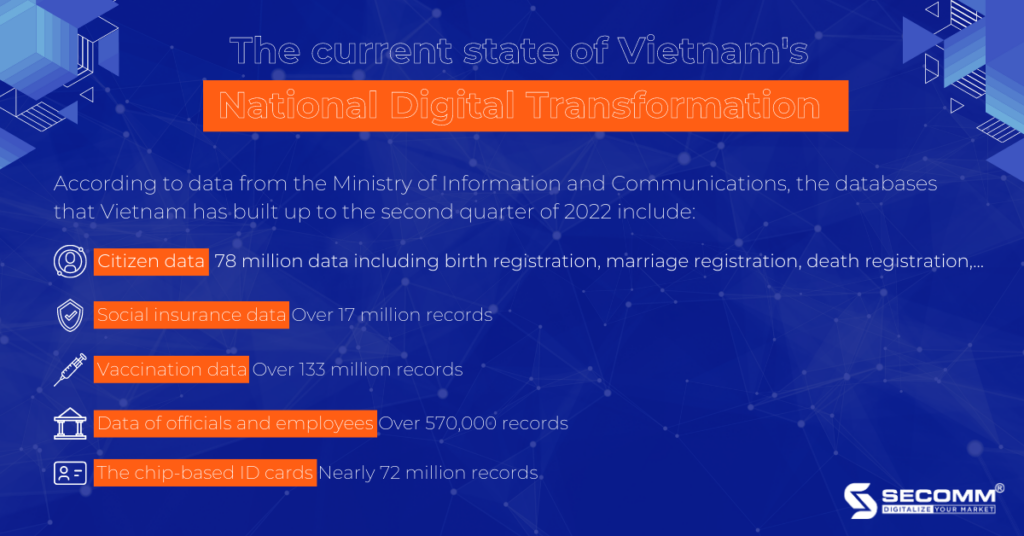
Additionally, the percentage of qualified online public services offered to individuals and enterprises has surpassed 97.3%; the percentage of these services that produce dossiers has gotten to 67.8% and the percentage of administrative procedures handled online has gotten to 43.2%.
Moreover, the economic sector has seen some very good improvements as a result of digital transformation. The Ministry of Information and Communications predicts that by the first quarter of 2022, the value of Vietnam’s digital economy will be 53 billion USD and that there would be 500 more newly founded digital technology businesses than there were at the same point in 2021.
The number of monthly users on Vietnamese mobile digital platforms climbed by more than 100 million compared to the same period in 2021, and the percentage of the digital economy in GDP increased to 10.41% in the first half of the year from 9.6% in the end of 2021.
3 key factors make National Digital Transformation successful
Based on specific analysis and data on the situation of National Digital Transformation in Vietnam, it is clear that there are 3 main pillars that lay the foundation for the success of the National Digital Transformation process: Digital Government, Digital Economy, and Digital Society.
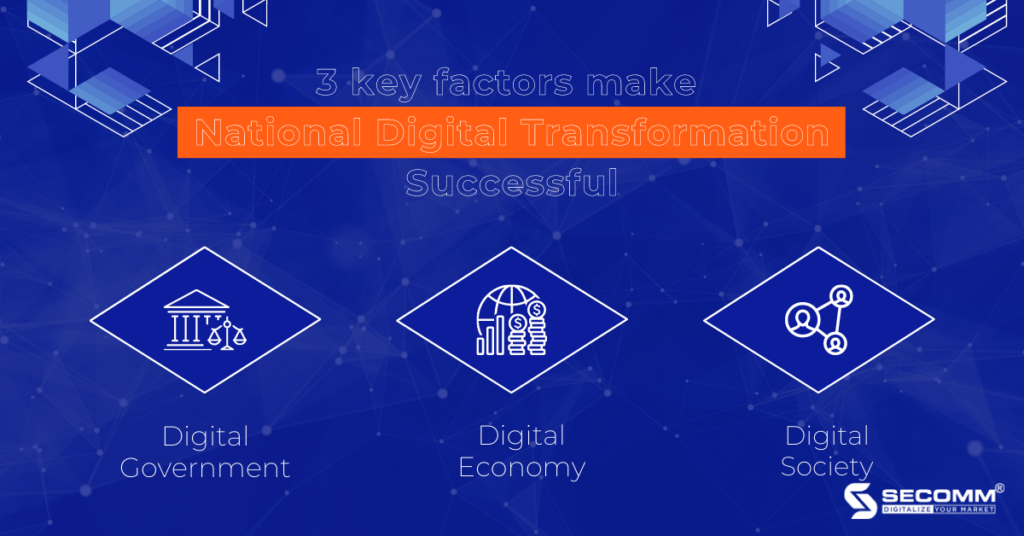
Digital Government
In order to increase operational efficiency and develop new operating models and alter the way services are offered using digital technology and data, a government must transition all of its operations to a digital environment. This allows enterprises to take part in the service delivery process. In other words, this is how the government is becoming digital.
Vietnamese citizens have been instructed in the past to finish the registration processes necessary to access the Citizen Identity Card with a chip, which is gradually replacing the previous ID card. This serves as one illustration of how well the digital government is progressing in Vietnam.
The process of processing dossiers and issuing ID Cards in the early stages is not really effective because the National Database on Civil is still under construction and staff training on how to use digital technology and digitize paper data on the data system is still limited. However, the procedure for issuing chip-based ID cards in addition to the cost is public and transparent.
As a result, when people arrive at the location where the chip-based ID card is made, processing will go more quickly if their information is already in the National Database; otherwise, they will need to provide more birth certificates and household registration information and will have to wait a long time for staff to check, enter data, and complete related procedures.
After that, the chip-based ID card will be sent to the registered address by post, but for the above reason, this process also takes quite a while.
The Public Service Portal of the Ministry of Public Security, however, is currently supported by the government and simply requires people to visit the location to capture pictures and fingerprints.
This demonstrates the government’s prompt responsiveness in streamlining business procedures while also saving time for both citizens and employees. This is evidence of the Government’s ongoing attempts to modernize itself digitally.
In addition, on the CCCD chip, more than 14 information fields of citizens are stored: (1) CCCD number; (2) Full name, other names; (3) Date of birth, month, and year; (4) Gender; (5) Nationality; (6) Ethnicity; (7) Religion; (8) Hometown; (9) Place of permanent residence registration; (10) Identification characteristics; (11) Date of issue; (12) Expiration date;
(13) Full name of parent, spouse; (14) issued 9-digit ID card number; (15) Portrait photos; (16) Features of fingerprint extraction and selection of two index fingers; backup for iris images, and other information.
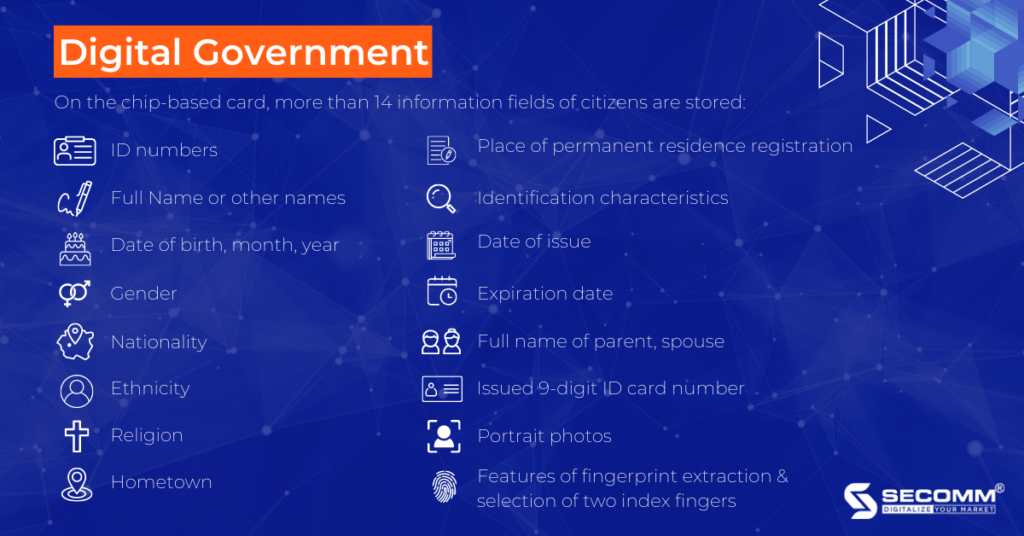
Moreover, a chip-based ID card can replace important papers such as Identity Cards, Health Insurance (HI), Social Insurance (Social Insurance), Birth Certificate, Marriage Certificate, and Household Registration Books….
It is clear that switching from conventional ID cards to chip-based ID cards has several advantages for both the general public and the government. People’s personal information is highly secure, preventing the creation of fake documents.
Also, ID cards with chips make paperwork and transactions straightforward because many pieces of crucial information are combined onto a single card, saving time and preventing the scenario where someone forgets to bring the necessary paperwork and causing the processing of documents to be interrupted.
The government made a wise choice by implementing chip-based ID cards.
The government can save, control, and check information about a specific individual quickly and efficiently with the use of chip-based ID cards and the National Database, helping to effectively control the situation of local security and order as well as national security.
Also, this helps free up labor for government employees who deal with people, handle paperwork, and maintain correctness, speed, and synchronization.
Digital Economy
The second factor that makes the success of the National Digital Transformation process is the Digital Economy.
Digital Economy is an economy that maintains and develops constantly based on modern digital technology. The digital economy is also known as the Internet Economy, the New Economy, or the Web Economy. This particular economy is made up of electronic transactions over the internet.
According to the definition from the Vietnam Private Economic Forum, the digital economy is all economic activities based on digital platforms. Digital economy development is the use of digital technology and data to create a new model of cooperation and business, in line with the development trend of modern technology.
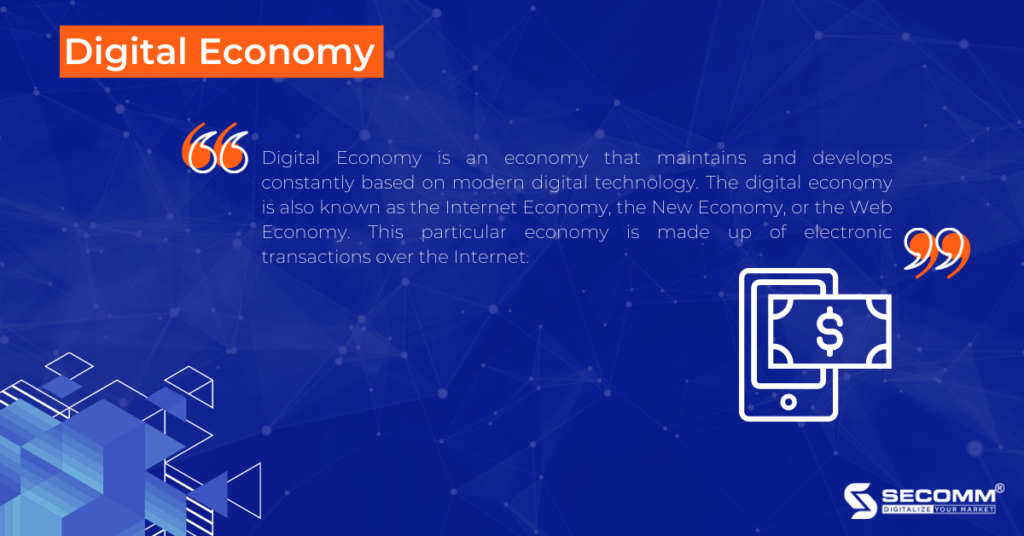
Therefore, everyone would immediately think of eCommerce when discussing the digital economy or the most prominent business model of the trend of digital transformation, and the strong push that this industry provides for high-volume industries catches the trend of digital transformation.
Few people anticipate that the conventional market model, which has become ingrained in Vietnamese culture, would soon be replaced by the market model 4.0, which accepts cashless payments. In several of Hai Phong’s traditional markets, this novel method of buying and selling was introduced for the first time, to the delight of the locals.
The Viettel Money application of Viettel Military Telecom Group, a pioneer in the digital transformation of market 4.0 models in 63 provinces/cities, enables all small businesses and individuals to purchase and sell things at the market by scanning QR codes or transferring money via phone number.
Moreover, cashless payment makes it easier for customers to shop at the market without worrying about issues like carrying change or budgeting extra cash for purchases. Also, many shopkeepers in the market are afraid of this issue pretty much.
Previously, if customers paid in cash with a denomination that was too big, shopkeepers would have to run everywhere to change money, causing time-consuming for both parties and other customers waiting to be served, the issue is now solved with just one smartphone.
Following the success of Hai Phong’s 4.0 market model, many other localities have also implemented this model and received positive feedback signals from the people such as Da Nang, Quang Ninh, Thai Nguyen, Lang Son, etc.
The market 4.0 model has spread to every nook and cranny of the nation’s small trading places, including farmers’ markets, grocery stores, sidewalk shops, amusement parks, parking lots, and more.
The digital transformation trend has quickly extended to places where it was previously impossible, helping to advance the digital economy and achieve the objective of a comprehensive national digital transformation.
Digital Society
Finally, the term “digital society” refers to all human activities in a broad sense. Digital technology, which is based on the exponential growth of information and data, is the primary driver behind digital society.
It transforms all facets of social structure, from the government and business to the individual. In a limited sense, “digital society” refers to both digital citizenship and digital culture.
From this perspective, the three pillars of a digital nation are the digital society, the digital government, and the digital economy.
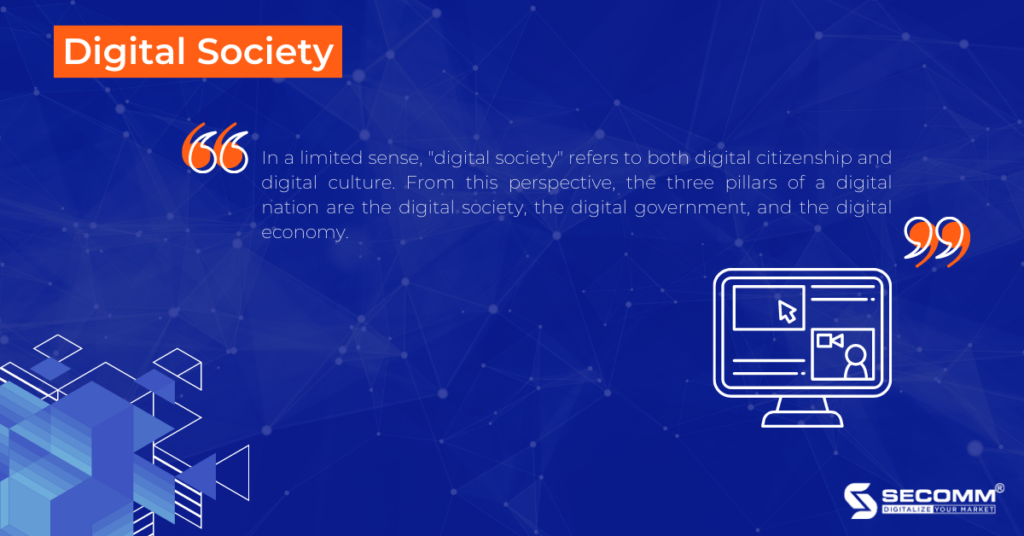
Teachers, parents, and students all adore the eLearning model, which is developing into a popular teaching and learning trend, especially in light of the recent pandemic and widespread implementation of social distancing policies.
Students can access lessons at any time, studying at home, using simply an electronic device with an Internet connection. As a result, teachings can be discussed and interacted with by professors and students without them having to actually meet.
This model also supports student doing teamwork well because it is not time- or space-constrained, saving on travel expenses in addition to using many other helpful resources.
However, for eLearning to really replace traditional teaching and learning methods, it takes a lot of effort from both the Government, the school system, and the student’s parents.
In fact, eLearning is only a small part of the digital society effort besides many other important aspects of society that need to be digitally transformed to make life more convenient for people.
National Digital Transformation has become one of Vietnam’s top goals and this is also a rare project that has received special attention from the highest levels of leadership and international support. Since then, Vietnam has had a full foundation to hope to realize the goal of becoming a digital country from now to 2030.
The development of a digital society, economy, and government, in particular, is a necessary and sufficient condition for a successful national digital transformation.
In fact, every citizen, from intellectuals to regular citizens, is gradually demonstrating a certain understanding in their own way about the digital transformation and awareness that the country is in a transition period to match the general development trend of the times.
This is in addition to the efforts of businesses and the support from the government.
Especially for businesses, digital transformation is an imperative remedy to withstands to withstand the tsunami of eradication brought on by the pandemic’s rapid shift in new business patterns.
Following Covid-19, business digital transformation flowed slowly, gently, and steadily, assisting the economy’s continued rotation.
The first step of the digital transformation journey for businesses is to start implementing eCommerce.
With many years of experience in successfully implementing eCommerce for many customers in many countries, SECOMM specializes in providing consulting services with comprehensive and professional eCommerce implementation solutions.
Contact SECOMM today for free support and advice.
 2
2

 2,191
2,191

 0
0

 1
1
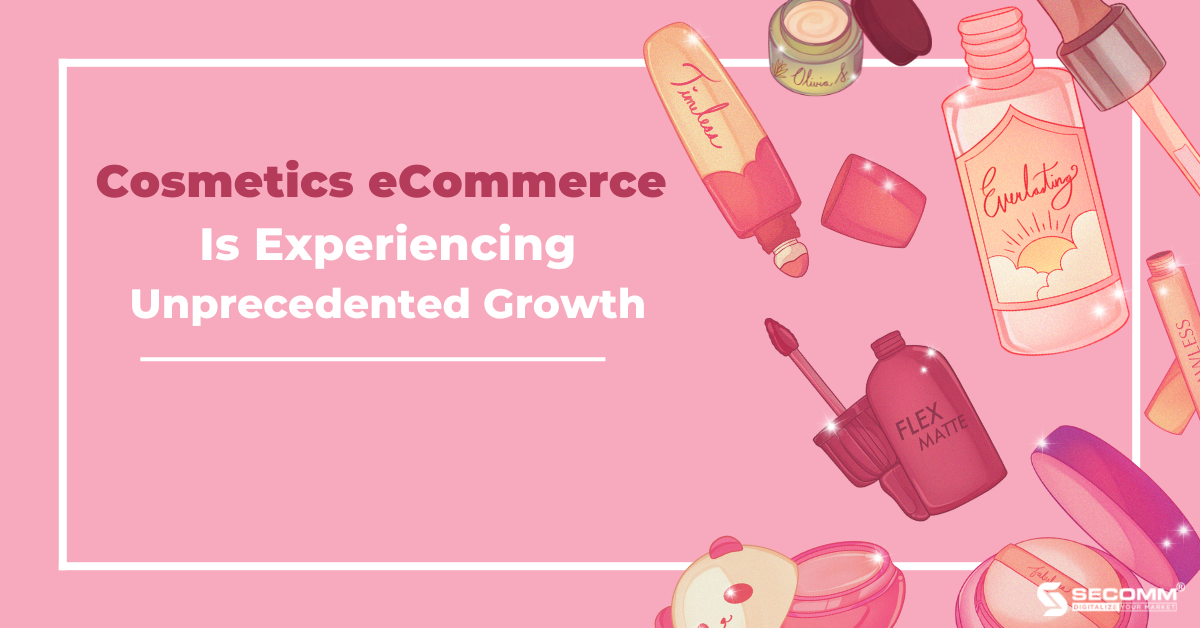
COSMETICS ECOMMERCE IS EXPERIENCING UNPRECEDENTED GROWTH
Consumer demand for beauty and health care is rising as the quality of life gradually improves. The fact that so many individuals are involved in commerce has also contributed to the cosmetics industry’s reputation as one of the most important sectors in the modern economy.
Additionally, the rapid growth of eCommerce following the pandemic is gradually emerging as a successful business strategy and a crucial step in the digital transformation of every industry, including the cosmetics industry.
The market size for cosmetics sold online is estimated by CommonThread to be $483 billion in 2020 and expand to $511 billion in 2021 at a compound annual growth rate (CAGR) of 4.75%. The market size is anticipated to surpass 716 billion USD by 2025 and reach 784.6 billion USD by 2027.
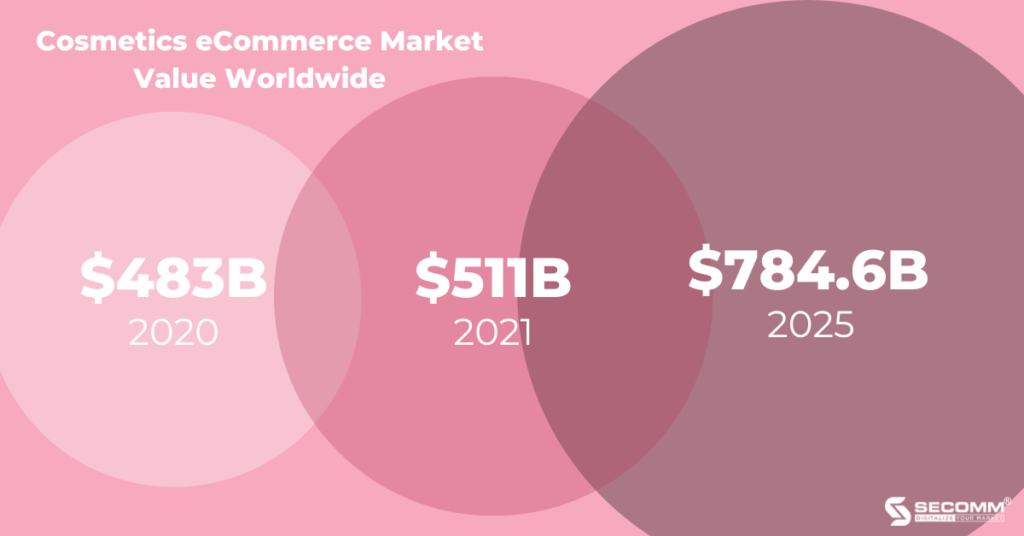
How do cosmetics firms benefit from eCommerce?
Keep up rapidly with the market shift
In the past pandemic years, the global economy has witnessed a sudden decline in sales in many industries, including the cosmetics industry.
People are compelled to reduce their social interactions while social distancing mechanisms are in effect.
At this time, people’s psychology will be more concerned with keeping an eye on and caring for themselves. Due to the unpredictable changes of the pandemic, there has been a sharp rise in the need for skincare, hair care, and body care products to enhance spiritual life.

Due to restrictions on leaving the house, online shopping at the time had become not only a need but also an urgent method of purchasing in place of in-person purchases. That serves as a springboard for eCommerce to take off and spur significant growth in other industries like fashion, grocery, wine, and even cosmetics.
These two elements highlight the enormous potential of this “cake,” assisting several cosmetic companies in realizing and swiftly implementing eCommerce for both sustainable development and market revolution.
Scale up the business
Using eCommerce as a solution will allow the cosmetics industry to shift from offline to online (O2O) business models rather than allowing their businesses to “get lost” in the crisis of the global pandemic.
Additionally, if businesses still do not have a competent eCommerce website to introduce and sell products to customers who love to shop online in the age of digital transformation, they will quickly lose many potential customers to rivals.

This is especially true for a highly competitive industry like cosmetics, but several firms, including Hasaki, LixiBox, Watsons, Guardian, etc., have embraced the trend early and are now the market leaders in cosmetic eCommerce.
Furthermore, early eCommerce development will also provide benefits that will make marketing efforts more successful, broadening the economic opportunities for businesses.
Enhance customer’s shopping experience
Businesses must consider customers’ purchasing experiences when launching eCommerce websites, and not just for the cosmetic industry.
Thanks to the use of contemporary technologies, which are quite popular in the cosmetics industry, the purchasing procedure will be swift, and effective, and bring customers satisfaction when they choose to buy cosmetics online.
For example, a 360-degree intuitive vision, virtual reality (VR), or augmented reality (AR) technology (AR).
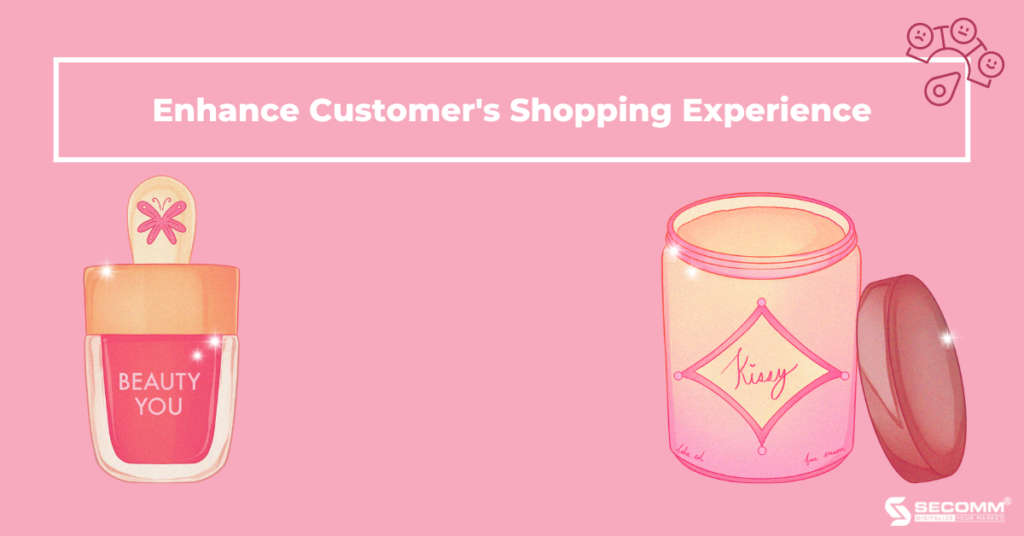
eCommerce enables businesses to quickly and effortlessly tailor the experience for customers by gathering, evaluating, and synthesizing the consumption behavior of each target group. Typically, this is done with the capabilities listed below: Products have seen, similar product recommendations, etc.
eCommerce provides clients with a seamless experience in addition to an intuitive one across a variety of channels, including social networks (Facebook, Instagram, Tiktok, Zalo, etc.), eCommerce platforms (Shopee, Lazada, Tiki, Sendo, etc.), eCommerce websites, mobile apps, etc.
Best cosmetics eCommerce sites that really stand out
Kylie Cosmetics
One of the most successful cosmetic brands that has a significant global media impact is Kylie Cosmetics. When it comes to Kylie Cosmetics, it’s tough not to give Kylie Jenner credit.
She’s the youngest female millionaire in the US and has been hailed as a business genius by prominent publications like Forbes due to her success in the saturated cosmetics industry.
When Kylie Cosmetics was founded in 2015, it generated an astonishing $ 420 million in revenue in its first 18 months. It is predicted that by 2022, net sales will have reached $ 1 billion.
The sensible business strategy, in addition to the founder’s reputation, focuses on utilizing the “gold mine” of eCommerce and launching social media marketing campaigns, which are the factors that contribute to that respectable revenue block.
As a result, the company used Shopify, a platform that specializes in creating websites for the top online retailers in North America, to develop its eCommerce website.
With pink and white as its primary colors, the website’s design is incredibly clean and uncomplicated. The layout of the website centers on showcasing the company’s products.
Also, this is a part of Kylie Cosmetics’ business strategy, which includes releasing collections of cosmetic products like lipsticks, eyeshadow, and eyebrow pencils with limited design and manufacturing to appeal to customers’ FOMO (Fear of Missing Out).
It is not surprising that Kylie’s new collections or cosmetics Cosmetics are continually “sold out” every time it is published because this is thought to be a very intelligent strategy of Kylie Cosmetics, completely different from other well-known cosmetic firms.

The business also utilizes social media platforms that are hugely popular in the US, like Instagram, Youtube, and Snapchat, to create content to market brands and products and engage with a huge audience across three platforms before driving traffic to the eCommerce website and generating conversions.
The company’s inventiveness and innovation are also on display in offline events that draw customers to free product samples. Here, the company wins over even customers who have reservations about the product’s quality, which greatly increases sales.
Since Kylie Cosmetics established its first traditional cosmetic retail store in 2018, customers may now purchase cosmetics from this cult brand at Ulta Beauty locations around the US.
Indeed, Kylie Cosmetics started off quite shrewdly and went on to tremendous success by keeping up with market changes by building an online business model at first, that is, selling through an eCommerce website and relying primarily on social media for promotion.
Guardian
Since entering the Vietnamese market in 2011, Guardian has grown to be a very well-known and recognizable brand among consumers of cosmetics. This brand is a part of the Dairy Farm Group, a company that manufactures and distributes health and beauty products in Asia.
Since its start, Guardian has made ongoing improvements to encourage millions of followers to lead healthy lifestyles and offer a trustworthy, high-quality purchasing experience at the finest rates and services.
With a system of more than 100 outlets “encompassing everywhere,” this retail chain is delighted to be a place to shop for cosmetics “for everyone” who can “purchase everything” and simply select appropriate items.
A clever business strategy and significant investment in successful marketing efforts are the only explanations needed to understand Guardian’s success.
When first entering the Vietnamese market, Guardian specifically pushed to quickly expand its business chain, focusing on cities with high purchasing power, with 80% of stores located in Ho Chi Minh City, the rest in Hanoi and some other major cities such as Da Nang, Can Tho, Bien Hoa, and Vung Tau.
Because at the time, online channels were not really well-known and powerful enough for this business to keep an eye on.
As a result, the company successfully raises the level of brand recognition with extensive coverage from the Guardian orange white wave, taking into account the characteristics of the cosmetics and beauty care industry, which require customers to have a direct point of contact, learn from, and test.
By 2019, the company began its journey toward digital transformation by combining offline and online (O2O) business models in parallel, and simultaneously, deploying Omnichannel.

It is even more critical for Guardian to immediately implement potential sales channels like marketplaces, applications, fast delivery services like GrabMart, and eCommerce website operate side by side with a chain of 105 retail outlets in strategic locations due to the pandemic’s dual effects, which include changing market trends and altering consumer buying habits.
The orange and white colors and quick page loads make the Guardian website’s design stunning. Additionally, Guardian offers enticing incentives in the shipping policy, such as free fast delivery within 4 hours with orders from 349,000 VND, to encourage online shoppers.
The company’s unique product catalog, which is prominently shown on Guardian’s eCommerce website and features items like shampoos, shower gels, and hand sanitizers, is another standout.
The foundation for helping Guardian dominate the cosmetic retail market and leave a lasting impact on customers is a deliberate investment in developing a multi-channel ecosystem.
Hasaki
Modernity and growth come with invisible pressures that have an impact on everyone’s life as people struggle to keep up with the “standards” of the times.
However, that does not result in a drop in the demand for beauty and self-care, on the contrary, it is always rising, with a diversity of sufficient options to match customer expectations.
Vietnamese women are among the most beautiful in Asia, but, due to the responsibilities of work pressure and family, they occasionally neglect to care for and love themselves.
Because of this, Hasaki Beauty & Clinic was established with the desire to become a reliable beauty and spiritual care destination for Vietnamese women.
The Hasaki store system, which was introduced in 2016 and now has 76 locations across 29 Vietnamese provinces and cities, has steadily established itself as one of the top retail chains for real cosmetics. Hasaki is dedicated to offering real cosmetics at discounted pricing, living up to its motto of “True Quality – True Value”.
Along with system expansion, Hasaki also works on creating an eCommerce website with features appropriate for the cosmetics industry and always enhancing and upgrading the system to provide customers with the greatest online shopping experience.

The Magento platform was used to build the website, and the interface is attractive with green serving as the primary color tone for the entire eCommerce website and app system. Customers can check current promotions and conveniently look up order details when accessing the Hasaki website.
Additionally, the “handbook” section at Hasaki has a wealth of knowledge on cosmetics and skin care tips that each customer may learn and arm themselves with before making a purchase decision. Since then, the process of beauty restoration is safe and effective.
Similar to Guardian, Hasaki encourages people to order online with NowFree 2h and take advantage of free shipping rules.
As a result, Hasaki will provide free delivery to customers within two hours of receiving orders of 90,000 VND in 29 provinces and cities where the company has locations, including on Saturday and Sunday. Customers will benefit from free national shipping on orders that are at least 249,000 VND.
Therefore, Hasaki has sparked a “green craze” among many beauty fans and is now gradually competing with the country’s top cosmetics brands thanks to its quick recognition of market trends and broad perspective with an efficient marketing mix strategy.
It is clear that the growth of the furniture market has been hastened by the speed at which eCommerce is developing.
Today, numerous local and international cosmetics companies participate in and offer the greatest shopping experiences to customers through the effective implementation of an eCommerce website, including Kylie Cosmetics (USA), Guardian, and Hasaki (Vietnam).
From there, companies may quickly connect with a wider pool of Internet users and generate conversions through efficient marketing strategies.
However, business leaders need to carefully and comprehensively take into account the growing customer expectations and rapidly shifting market trends, not to mention specifically describe a systematic and precise business strategy for taking the most advantageous actions in the short and long term.
Completing that difficult task will take a lot of time and resources. As a result, many cosmetics companies opt for a more straightforward approach to the issue, enlisting the assistance of a highly qualified and dependable unit.
SECOMM has many years of expertise in effectively executing eCommerce for numerous customers in various countries. We specialize in offering free consultation services with qualified eCommerce implementation solutions.
Contact us right away for free counsel and assistance.
 2
2

 2,500
2,500

 0
0

 1
1
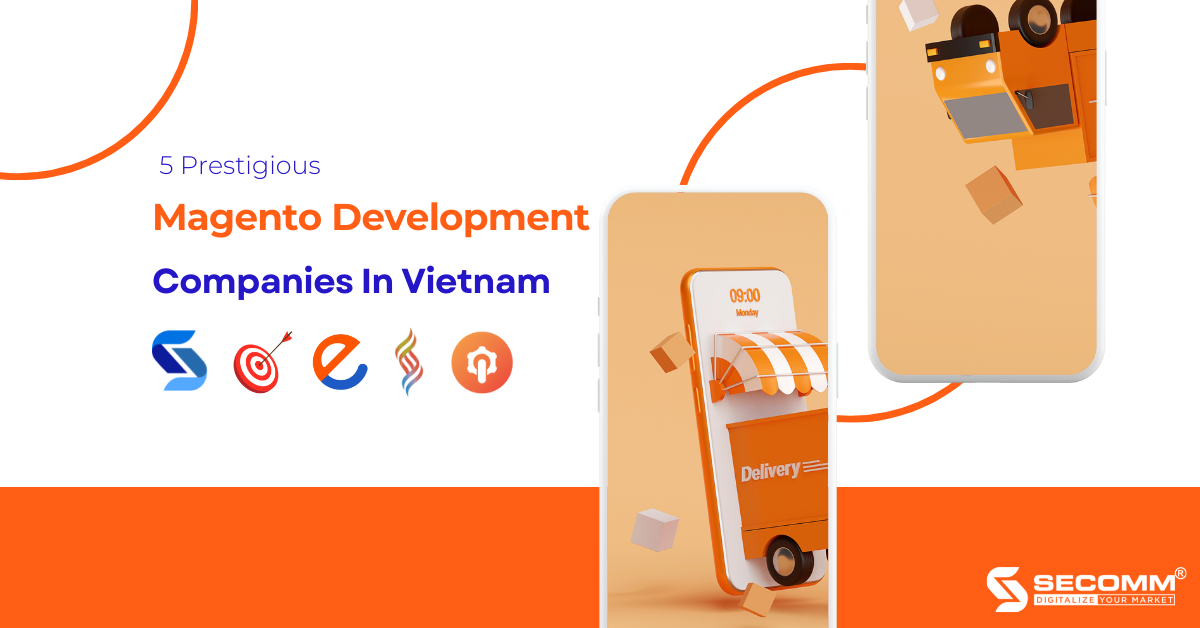
5 PRESTIGIOUS MAGENTO DEVELOPMENT COMPANIES IN VIETNAM
The vast and competitive eCommerce sector is witnessing the constant entry of all-sized businesses, making it challenging for many “nascent” companies to prosper in a billion-dollar market that is seen as the domain of technology giants.
Therefore, creating a professional eCommerce website is a crucial objective for new enterprises looking to take the first steps firmly, quickly dominate the market, and follow the success of the big guys.
As a result, Magento is one of the best options to consider when establishing an eCommerce website to ensure that the process is carried out successfully. It can be difficult to find a partner with strong IT skills and Magento platform development experience.
The list below details the top 5 leading Magento development companies in Vietnam that businesses can refer to make the best choice.
Kyanon Digital
One of the leading consulting companies providing solutions to develop eCommerce websites with the Magento platform and Omnichannel (Omnichannel) is Kyanon Digital. through many years of operation steadily established itself as a trustworthy technology partner of many major retail groups in the Asia-Pacific region thanks to its team of qualified experts.

Magenest JSC
Magenest is a longtime technology solutions partner based in Vietnam and a leading partner of Adobe Magento, Odoo ERP, Salesforce, AWS, and Google Cloud Platform.
The company specializes in providing comprehensive hosting services and eCommerce implementation and providing package solutions in line with market trends to promote the business activities of partner businesses.
Magenest strives to support brands in achieving their goals of developing eCommerce websites with Magento. Magenest has a solid technical and consulting experience from over 30 certified consultants and developers.

BSS Commerce
BSS Commerce is an Adobe Solution Partner that provides proper Magento-related eCommerce solutions to businesses throughout the world.
The business has serviced more than 22,000 customers worldwide since its foundation in 2012, accomplished more than 500 projects, and earned the greatest level of customer satisfaction.

SECOMM
SECOMM is another well-known eCommerce website developer in Vietnam that is well-regarded by customers for the excellence of its work and service.
This business specializes in eCommerce consulting and offers a wide range of services, including site development, maintenance, and upgrades on platforms including Magento.
Since its establishment in 2014, SECOMM has worked with major local and foreign clients like LayByLand, Trentham Estate, An Nam Group, and others to implement eCommerce websites on the Magento platform effectively.
By simplifying all eCommerce activities, SECOMM is confident to be a reliable companion in the comprehensive digital transformation journey of businesses in Vietnam and globally.

AgileTech
AgileTech is a top software outsourcing company in Vietnam that has a team of experienced Magento developers who specialise in creating and maintaining high-performance E-Commerce websites.
The company is constantly up-to-date on the latest Magento features and developments, and they use this knowledge to create websites that are scalable, secure, and user-friendly during their 8-year establishment. AgileTech is committed to providing clients with the best possible Magento development experience.
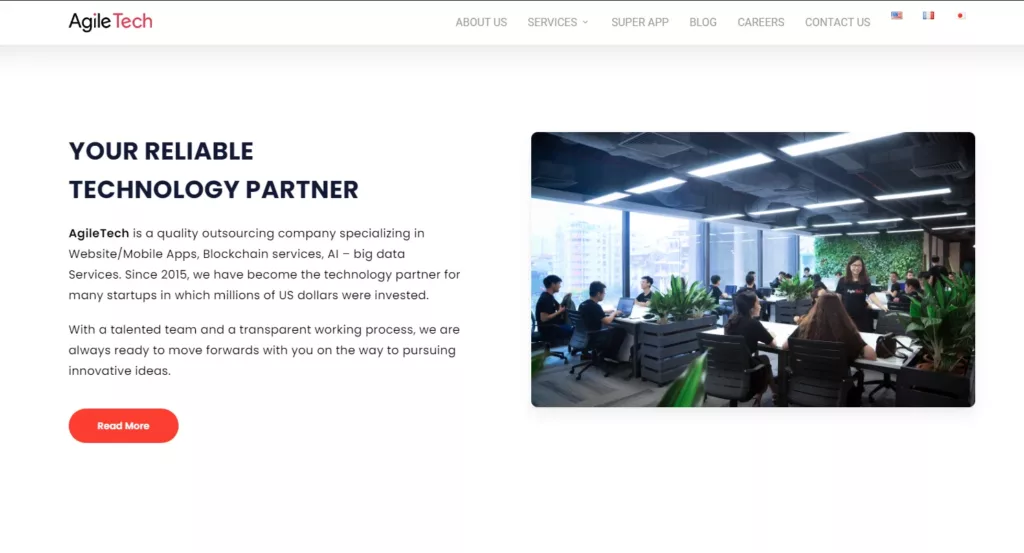
It is evident that eCommerce implementation offers businesses many advantages for entering and dominating the industry. The top 5 support firms for creating and developing eCommerce websites on the Magento platform that companies can rely on are listed above.
 2
2

 1,539
1,539

 0
0

 1
1
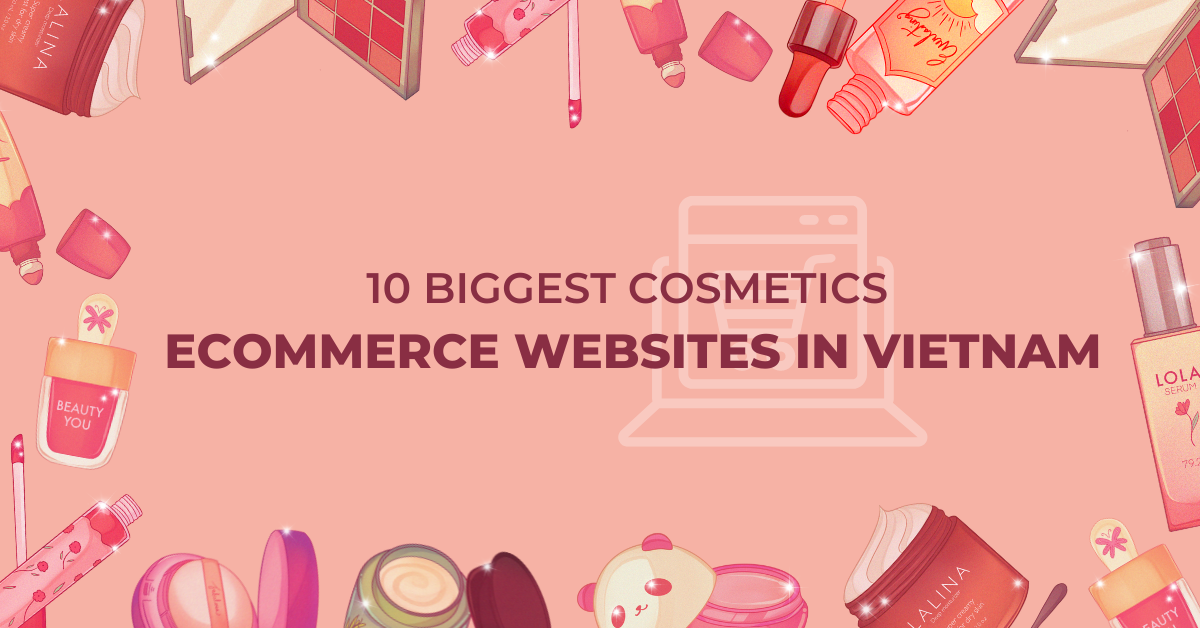
10 BIGGEST COSMETICS ECOMMERCE WEBSITE IN VIETNAM
Exporting and trading internationally has become challenging due to the Covid-19 epidemic. In order to increase sales and find online customers, numerous companies in several industries, including the cosmetics industry, have used eCommerce.
Additionally, to support eCommerce activities and achieve the objective of growth and scalability, cosmetic retailers shift from traditional business practices to keep up with the general development trend of the global economy.
In Vietnam alone, a handful of cosmetic firms in Vietnam have demonstrated extraordinary flexibility and agility in reacting to market adjustments “despite” the complicated changes brought on by the global pandemic.
The following brands have gained the trust of and made a lasting impression on cosmetic customers by creating professional and insightful eCommerce websites.
Hasaki
Hasaki, a company founded in April 2016 to provide full health and beauty care for Vietnamese people, has developed secure and quick online shopping experiences with a choice of high-quality cosmetic items from many of the world’s leading brands in today’s market.
Hasaki’s eCommerce website was invested in and methodically developed from the start with the open-source platform – Magento – in order to deliver clients satisfaction in terms of comfort and efficiency when purchasing online.
More than 7 million visitors per month of traffic at a very high level demonstrate the wisdom of Hasaki’s eCommerce investment. This company’s expansion of its distribution network increased market penetration, and identification and diversification of the target customer were all made possible by sensible strategy.

- Website: https://hasaki.vn/
- eCommerce platform: Magento
- Traffic: 7.244m/month
- Ranking: 514 (Vietnam); 26,288 (Global)
The Gioi Skin Food
The Gioi Skin Food is another well-known eCommerce site with over 2 million monthly visitors that focuses on selling cosmetics. This business worked with Haravan to create an effective eCommerce website with an easy-to-use interface.
The Gioi Skin Food has up now employed eCommerce in addition to the conventional retail shop method, which has been incredibly successful. This would enable the business to catch up with the online-to-offline (O2O) trend and raise brand awareness and revenue.

- Website: https://thegioiskinfood.com/
- eCommerce platform: Haravan
- Traffic: 2.285M/month
- Ranking: 1,670 (Vietnam); 84,473 (Global)
Watsons Vietnam
The Watsons Group, Asia’s top retail organization for health and beauty products, owns the Watsons Vietnam brand. The company desires to provide Vietnamese customers with the finest shopping experience possible while also bringing them high-quality products that are appropriate for their needs.
Notably, Watsons adopted the O2O business model right away after entering the Vietnamese market. With the goal of dominating the market, Watsons Vietnam invests in developing an eCommerce website with SAP Commerce Cloud in addition to the store system dispersed throughout the neighbourhoods of Ho Chi Minh City.
Additionally, the user-friendly and aesthetically designed interface contributes to the website’s amazing monthly visitation of more than 1 million.

- Website: https://www.watsons.vn/
- eCommerce platform: SAP Commerce Cloud
- Traffic: 1.267M/month
- Ranking: 2,715 (Vietnam); 129,769 (Global)
The Gioi Son Moi
The Gioi Son Moi is one of the places where people go to get lipstick that is well-known and reputable because of the guaranteed product quality and the courteousness of the staff. Every day, new products are added to the site, ensuring that there is always enough supply of well-known companies’ lipstick lines in the right hues at competitive rates.
The Gioi Son Moi also swiftly launched an eCommerce website to join the common playground of the cosmetic retail sector, in addition to two physical locations in HCMC that are constantly being renovated, extending the amount of shopping space. As a result, the website is built on the Haravan platform and has a straightforward interface that is nonetheless opulent and complex.
Also, the extremely high monthly traffic volume (more than 1 million) also demonstrates the company’s successful business strategy in the context of the market’s innovation trend.

- Website: https://thegioisonmoi.com/
- eCommerce platform: Haravan
- Traffic: 1.103M/month
- Ranking: 3,582 (Vietnam); 156,691 (Global)
Bo Shop
Beauty lovers in HCMC can’t help but be aware of Bo Shop, a company that provides a broad range of high-quality cosmetics, from skincare to makeup, at rates that are specifically stated to fulfil customers’ demands for all types of beauty care.
The company quickly creates an eCommerce website using WooCommerce to keep up with contemporary business trends in order to become the top cosmetic retail brand in Vietnam.

- Website: https://www.boshop.vn/
- eCommerce platform: WooCommerce
- Traffic: 1.020M/month
- Ranking: 5,030 (Vietnam); 234,462 (Global)
Guardian
For many years, Vietnamese consumers of cosmetics have been familiar with the name Guardian. This is a brand from the Dairy Farm Group that manufactures and distributes well-known health and beauty care goods all over Asia. In Vietnam, where Guardian first opened in 2011, the company now has more than 100 outlets.
In 2019, the business started its transformational path and parallel fusion of offline and internet business models. In order to create an omnichannel sales network (Omnichannel), Guardian focuses on building eCommerce websites with Shopify in addition to deploying potential sales channels like eCommerce platforms, apps, and fast delivery channels via GrabMart.
This gives customers more affordable, quick, and convenient home shopping options. After only a short period of time in operation, the Guardian website has attracted close to 1 million visitors each month.
Guardian has risen to the top of the industry and evolved into the biggest and most prominent retail chain for health and beauty products in existence today thanks to a significant investment in developing a multi-channel ecosystem.

- Website: https://www.guardian.com.vn/
- eCommerce platform: Shopify
- Traffic: 908,599/month
- Ranking: 4,037 (Vietnam); 188,419 (Global)
Lam Thao Cosmetics
Since Lam Thao Cosmetics’ formal opening in 2017, young people have come to love it as one of their favourite cosmetic shops. Lam Thao Cosmetics is continually upgrading its product line with the most affordable rates in an effort to give customers more options with the trendiest goods and improve their experience.
Along with offering high-quality goods, Lam Thao also runs an eCommerce site on the Haravan platform to enhance clients’ offline and online purchasing experiences. The success of eCommerce implementation has also helped Lam Thao Cosmetics reach a significant number of online prospects, boosting both sales and brand recognition.

- Website: https://lamthaocosmetics.vn/
- eCommerce platform: Haravan
- Traffic: 437,475/month
- Ranking: 8,423 (Vietnam); 392,219 (Global)
Nuty Cosmetics
For those who love cosmetics, Nuty Cosmetics is regarded as a cosmetics heaven. After operating and growing for more than ten years amid market ups and downs, the business is still a renowned source for real beauty products from well-known manufacturers in the US, Germany, France, Japan, and Korea.
The WooCommerce platform was used to create Nuty Cosmetics’ website, which has an easy-to-use interface and exceptional features that may satisfy clients when they shop online. Additionally, Nuty Cosmetics’ website offers thorough information about each product, along with clearly stated costs.
Because of this, despite the fact that there are only roughly 200,000 visitors per month on the site currently, Nuty Cosmetics has the potential to become a major player in the cosmetics industry with the correct efforts and attitude.

- Website: https://nuty.vn/
- eCommerce platform: WooCommerce
- Traffic: 229,347/month
- Ranking: 7,505 (Vietnam); 352,535 (Global)
AB Beauty World
In the midst of the Covid-19 outbreak that was raging in 2020, AB Beauty World (ABBW) was founded with the goal of being the top family-friendly cosmetics retailer in Vietnam. The brand has not given up despite the fact that this birth appears to have occurred at the wrong time.
In fact, AB Beauty World has grown and expanded with approximately 20 branches spread throughout the city’s districts in just two years since opening the first store in HCMC, concentrating on growing eCommerce, thanks to the timely redirection.
The WooCommerce-powered cosmetics website for AB Beauty World features an interface and capabilities tailored to the sector. The website has already seen more than 150,000 visitors in the short time since it launched, which is nonetheless viewed favourably for a newcomer to the fight for digital transformation.

- Website: https://abbeautyworld.com/
- eCommerce platform: WooCommerce
- Traffic: 157,602/month
- Ranking: 3,538 (Vietnam); 169,419 (Global)
Beauty Garden
Beauty Garden is one of the top retail and distribution brands for real cosmetics today. Since its establishment in 2014, the company has effectively extended its retail network to be present in numerous provinces and major and minor towns throughout the nation, including Hanoi, Da Nang, Ho Chi Minh City, Dak Lak, Gia Lai, Dong Nai, and Can Tho.
In addition, Beauty Garden concentrates on developing eCommerce websites in the context of economic integration. As a result, the company’s website is expertly and systematically constructed using WooCommerce, the most popular eCommerce development platform worldwide, and is ideal for the cosmetics business.
The eCommerce implementation of Beauty Garden is seen as a sensible move since the development potential of this area is extremely great and at that time, the company had many advantages to build a business model, even though the number of users is still modest with more than 100,000/month.

- Website: https://beautygarden.vn/
- eCommerce platform: WooCommerce
- Traffic: 127,439/month
- Ranking: 6,029 (Vietnam); 284,460 (Global)
All things considered, the Covid-19 pandemic outbreak has impacted and altered consumer shopping behaviours for a variety of goods. Shopping for cosmetics, in particular, has seen a significant change from physical to online formats.
The information above is a summary and evaluation of SECOMM for 10 eCommerce sites with a good reputation and the capacity to meet customers’ demands when making a decision to purchase cosmetics.
These companies demonstrate their efforts to create the technological infrastructure needed to enhance the online shopping experience as well as their well-founded optimism regarding the market’s growth potential and dominance in Vietnam.
With many years of experience in successfully implementing e-commerce for many customers in many countries, SECOMM specializes in providing consulting services with comprehensive and professional e-commerce implementation solutions.
Contact SECOMM today for free support and advice.
 2
2

 10,348
10,348

 1
1

 1
1
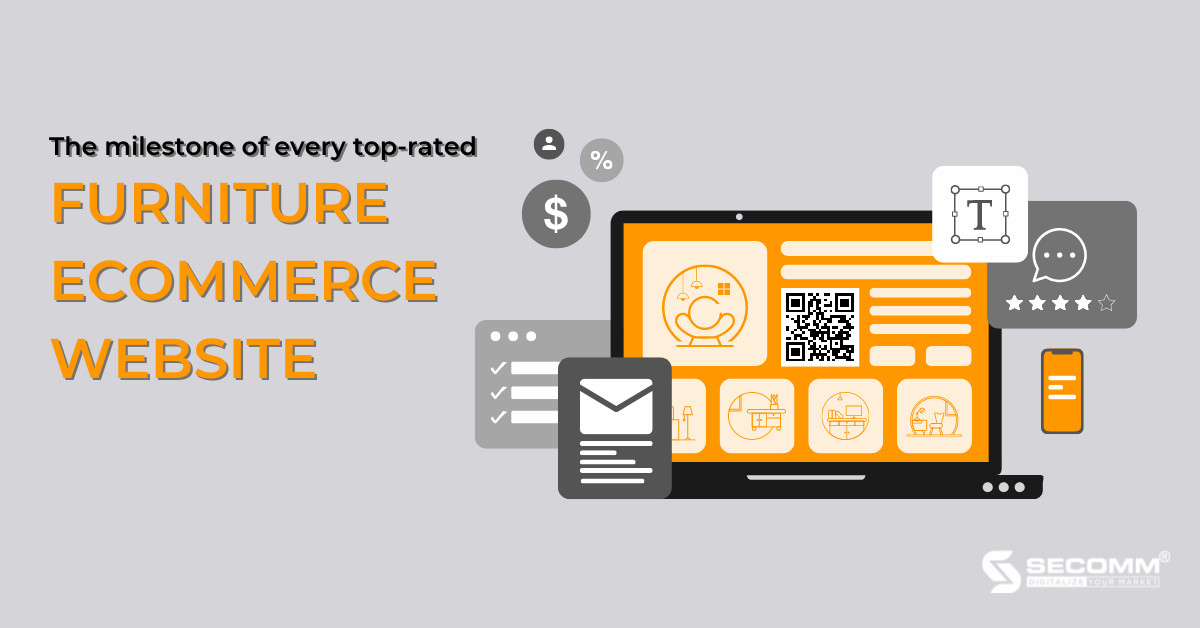
THE MILESTONE OF EVERY TOP-RATED FURNITURE ECOMMERCE WEBSITE
In the context of the Covid-19 pandemic, which is seen as an “obstacle” to the business activities of most businesses, eCommerce is emerging as an efficient way to enable Vietnamese furniture businesses to participate in the typical “playground” of global digital transformation.
At the same time, it is a pressing solution for furniture products to be consumed easily and accessible to many potential customers.
Therefore, the first wise step furniture brands have been hurrying to do in order to fast access the market is developing an eCommerce website. However, this difficult path calls for a significant investment of time and energy.
With years of expertise supporting several companies, SECOMM has developed a thorough process for developing a successful eCommerce website exclusively for the furniture sector.
Overview
A brief overview of the eCommerce market
The Covid-19 pandemic’s convoluted dynamics made travel challenging, which led to a necessity and urgency that resulted in the explosion of global eCommerce. At that point, internet buying and selling, which is more practical, takes the place of on-the-spot buying and selling.
Global eCommerce sales will rise from 15% in 2019 to 21% in 2021 and then continue to rise to 22% in 2022, according to Morgan Stanley. eCommerce will likely continue to have a large surplus. The market is established, and its growth rate might rise from its current level of 3.3 trillion USD to 5.6 trillion USD in 2026 as a result of significant company penetration in all industries worldwide.
In Vietnam alone, many service sectors had negative growth as a result of the Covid-19 outbreak, although the eCommerce market continued to grow steadily. In particular, the sector for wholesale and retail fell by 0.21%, transportation and warehousing fell by 5.02%, and that for lodging and food services fell by 20.81% in comparison to 2020.
In contrast to that doom, eCommerce has consistently grown at a pace of 16%, with retail sales reaching $13.7 billion USD in 2021. Additionally, the proportion of eCommerce retail sales in all retail consumer goods and services nationally reached 7%, up 27% from the same period in 2020. (Vietnam eCommerce White Paper in 2022).
Because of this, even if the epidemic is now under control and customers are beginning to purchase again in stores, expectations about the potential and rapid growth of the post-Covid eCommerce business are well-founded. The furniture business will not be the only one promoted to extraordinary growth from that point on.
Significance of eCommerce in the Furniture industry
According to Forbes, furniture and building materials have experienced the biggest growth in eCommerce sales during the past two years of the epidemic, with a cumulative growth rate of more than 200% over the year prior to the pandemic, 2019. The category of furniture and home appliances likewise experienced a remarkable cumulative gain of more than 66% compared to the same time in 2019.
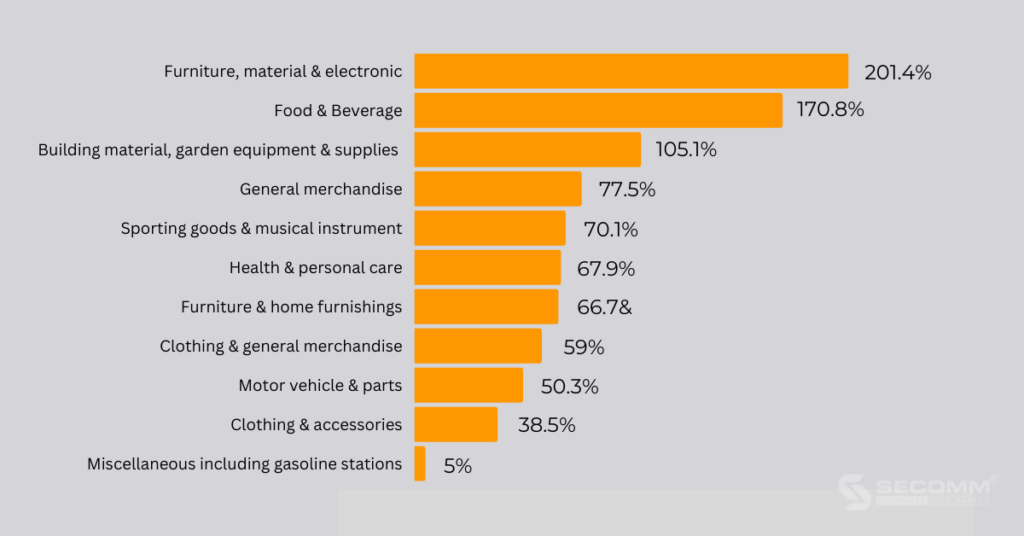
Recent findings made by Maddyness include the following intriguing details:
- The value of the worldwide furniture eCommerce market exceeds $200 billion.
- Online sales account for more than 90% of the growth of the furniture industry.
- According to estimates, 8 out of every 10 consumers who purchase furniture have made an internet purchase at least once.
- One in three consumers prefers to buy furniture online.
- 16% of sales of furniture and home goods are made online.
- Customers anticipate purchasing sofas online in 53% of cases and mattresses in 80% of cases.
Stage 1: Basic furniture eCommerce website development
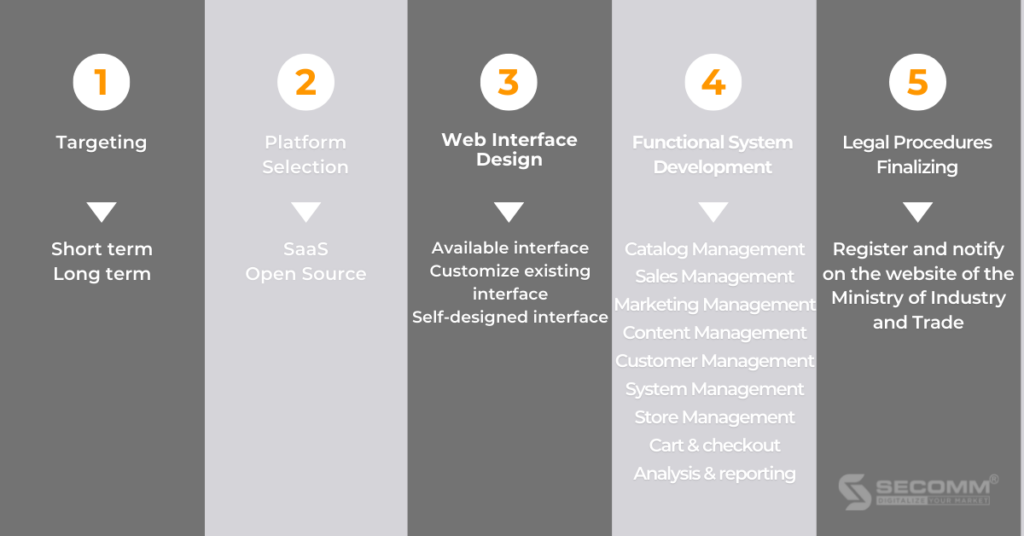
Targeting
The very first thing that furniture businesses need to do is to determine their short-term and long-term goals and priorities before starting to develop an eCommerce website.
To accomplish the anticipated revenue increase in the short term, firms should place a priority on promoting marketing activities, tracking and analyzing customer behaviour, and assessing the efficacy of marketing initiatives. Furthermore, user experience is a crucial consideration that furniture companies must have in mind while advertising eCommerce.
Long-term objectives for firms could include raising brand awareness and coverage as well as evaluating the viability of individual items on online marketplaces. Effective marketing campaigns are also one of the long-term objectives that firms should take into consideration if they want to increase their online consumer base.
Businesses can take a lot of advice from specialized eCommerce implementation consulting units with a lot of experience in consulting a long-term roadmap to get the right list and priority of goals for both this period and beyond since they currently have little data to analyze and evaluate for the entire process.
Platform selection
There are currently two categories of platforms available on the market that enable the development of expert eCommerce websites and are highly well-liked, namely SaaS platforms and Open-source platforms. When used to create eCommerce for the furniture sector, these two types of platforms will each have the following advantages and disadvantages:
SaaS Platform
A service-based software application distribution mechanism for eCommerce commercial purposes is the simplest definition of a SaaS platform. To put it another way, the service provider develops and maintains software to aid in the creation of an eCommerce website, and the firm pays a set fee to use this service.
With SaaS platforms, the provider will own and manage the source code and data because the complete enterprise website system is hosted on the provider’s server. This means that the service provider will be in charge of handling and resolving technical issues that arise during the implementation of eCommerce by businesses.
Popular SaaS platforms are especially favored by businesses today, such as Haravan, Shopify, BigCommerce, etc.
Some of the advantages of the SaaS platform include:
- Fast eCommerce site deployment: Typically, it only takes a few minutes or days for businesses to possess an eCommerce site with all the features they need for the furniture sector at a fair initial building cost.
- Ease of use: The SaaS platform is built with user-friendliness in mind, making it possible for companies without IT advantages or technical expertise to swiftly develop and manage an eCommerce website.
- Good security: SaaS providers are in charge of the security aspect since they give and maintain the platform for building eCommerce websites. As a result, eCommerce companies in general, and furniture eCommerce companies in particular, won’t need to worry too much about PCI compliance, SSL, or the possibility of websites being hacked.
- Excellent customer service: Due to the supplier’s 24/7 assistance, businesses may easily contact them by email, hotline, or live chat if their eCommerce website experiences any issues during implementation.
The leading furniture enterprises in Vietnam using the SaaS platforms to build eCommerce websites include
- Noi That Hoa Phat: The Vietnamese furniture giant has implemented eCommerce with the BigCommerce platform to maintain its position in the market.
- Noi That Moho: A rooky of the furniture village uses the Haravan platform to build a website as the first step on the journey to conquer eCommerce.
- Noi That Cozy: The European furniture import and distribution tycoon has chosen Shopify as a companion to design a website to expand sales channels in the online environment.
However, there are still several drawbacks to the SaaS platform that should be taken into account:
- Expenses rise over time: Instead of paying once and owning the platform for a long time, businesses will have to pay for interfaces, applications, extensions, marketing, and SEO, among other fees, steadily and continuously. This is in addition to having to pay for the cost of using the platform month by month and year by year. Too many expenses are incurred each month, which makes it challenging to monitor cash flow.
- Can not own the source code and data: As mentioned earlier, the business will not own and control the source code and data of the website that this right belongs to the supplier. Therefore, when you want to switch platforms, businesses will not be able to keep and bring all the source code and data to the new platform because of the Lock-in feature of SaaS.
- Limited functionality and customization: Businesses employing SaaS platforms will have fewer options for functionalities and customization in accordance with the particular requirements of each eCommerce website. To enhance clients’ online shopping experiences, the website system must be modified to reflect the company model’s growth as well as industry and product features. SaaS’s constraint, however, makes it challenging to adapt to corporate demands.
Open-Source Platform
Open Source Platform is software with generally available source code that enables customers to obtain, upgrade, and modify additional features required for eCommerce company needs. Instead of being produced by a single corporation, open-source platforms are frequently created by a community of developers.
In addition, because it offers extensive customization options, this platform will be perfect for creating sophisticated eCommerce website systems tailored to a variety of industries, including the furniture industry.
This means that in order to efficiently administer the website and handle technological issues, firms either need to work with expert eCommerce website builders or develop a team of highly qualified internal workers.
In Vietnam, the most popular Open Source platforms to mention are Magento, OpenCart, WooCommerce (WordPress Plugin), etc.
The outstanding advantages of the Open-Source platform:
- Ownership of source code and data: Unlike a SaaS platform, the enterprise is the sole owner of the system’s source code and data. Businesses can thus bring all the data and reuse the existing source code when switching to a new platform.
- Flexible customization: Companies using the Open Source platform can quickly alter or expand the functional system and create new features to keep up with the rapidly shifting market. From there, companies may quickly link with systems and services provided by other parties to help run eCommerce websites more effectively. Moreover, the Open Source platform’s flexible customization capabilities enable businesses to choose between three popular options for customizing the interface design of their eCommerce website: using an existing theme, customization based on an existing interface and designing its own interface tailored to the particular requirements of the industry.
- Numerous features and add-ons: The Open Source platform includes a wide range of advanced capabilities, like advanced search, product suggestions, abandon cart, etc., in addition to the fundamental functions that facilitate eCommerce implementation. Since the Open Source platform is so well-liked, there is a sizable global developer and expert community from which add-ons are explored and shared. These add-ons are more varied and better than the SaaS platform’s utilities.
The following well-known Vietnamese furniture companies are developing their online stores using the Open Source platform:
- Sieu Thi Noi That va Trang Tri Baya: A reputable furniture retailer that serves many Vietnamese families, has created a professional eCommerce website using the Magento platform for the purpose of immediately dominating the market.
- Noi That Nha Xinh: Manufacturer and supplier of Asian-style furniture products, using the WooCommerce platform for easy and effective eCommerce website deployment.
The disadvantages worth noting when implementing eCommerce with the Open Source platform:
- Long implementation period: In comparison to SaaS systems, an open-source platform typically takes 3 months to 1 year to create an eCommerce website, depending on the complexity of the functional system.
- High building expenses: Even though companies are free to utilize the platform, it costs quite a bit of money to own a complete eCommerce website with all of its features, usually between $10,000 and $50,000 per project.
- Not easy to use: Building an eCommerce system is more difficult than building on SaaS platforms since the system of open source eCommerce features is so diverse and is made to be fine-tuned for each business model. When IT is not a strong suit for a company, this presents a significant challenge, necessitating the assistance of a highly skilled unit.
Web interface design
Businesses should focus on making sure that the website interface conforms to UI/UX standards, clearly displays the brand’s distinctive characteristics and those of the furniture industry, and is synchronous in terms of product presentation and layout when designing the interface of an eCommerce website.
So, businesses can select one of the three methods listed below to create the website interface:
- Using the available interface: In comparison to the other two payment options, this is the most affordable way for businesses to pay for the interface. With pricing ranging from $300 to $500, both SaaS and Open Source platforms offer a selection of common UI/UX interfaces.
- Customizing based on the available interface: Like the previous method, businesses will use the current interface but will modify it to suit their brand’s requirements. As a result, companies cut expenses while also expressing their brand’s distinctive qualities in part.
- Using a self-designed interface: Companies can start thinking about designing their own website interface right immediately to develop a brand image that is unique and more creative than rivals. Even while this is more expensive for businesses than adopting an already-existing interface, the “tailor-made” design interface will match the industry-specific requirements and expectations of the company during the eCommerce deployment phase.
Firms should typically only use methods 1 or 2 at this point because the functional system is still in its early phases and easily found in the available interface.
Functional system development
In phase 1, businesses can prioritize the development of a system of basic functions needed for a complete furniture eCommerce website, specifically as follows:
- Catalog management: Manage and control categories, product functions, as well as prices and images/videos for each product to optimize the operation and achieve high efficiency when doing furniture eCommerce business.
- Sales management: Manage all order information, including order status and order fulfillment process, thereby helping businesses understand and analyze customers’ shopping behavior and set up and control payment and delivery processes efficiently.
- Marketing management: Integrating basic SEO optimization support features such as URLs, meta tags, internal links, etc., and deploying effective marketing campaigns to drive sales.
- Content management: Build and optimize content for CMS pages from text, images, pagination, blocks, banners, widgets, and templates to all kinds of branded content, blogs, etc.
- Customer management: Manage and control all customer information and customer groups to improve the effectiveness of marketing campaigns, thereby providing a better shopping experience for customers.
- System management: Manage and decentralize administrators to control and operate, secure and maintain the eCommerce website system.
- Store management: Using tools to support inventory management at branches, stores, and different warehouses to ensure the continuous supply of goods for the whole system.
- Cart and checkout management: Manage and control customers’ shopping carts and payment information.
- Analysis and reporting: Support to analyze and measure the performance of the eCommerce website system, thereby offering the next effective business strategies in the future.
Legal procedures finalizing
The final step of building a basic eCommerce website is completing the necessary legal procedures for the website to be allowed to operate legally. Businesses can follow the simple registration steps as instructed at the eCommerce Management Portal.
This is a mandatory requirement of the Ministry of Industry and Trade for every individual or organization that owns an eCommerce website to sell goods and to perform the registration/notification obligation on time.
Stage 2: In-depth furniture eCommerce website development
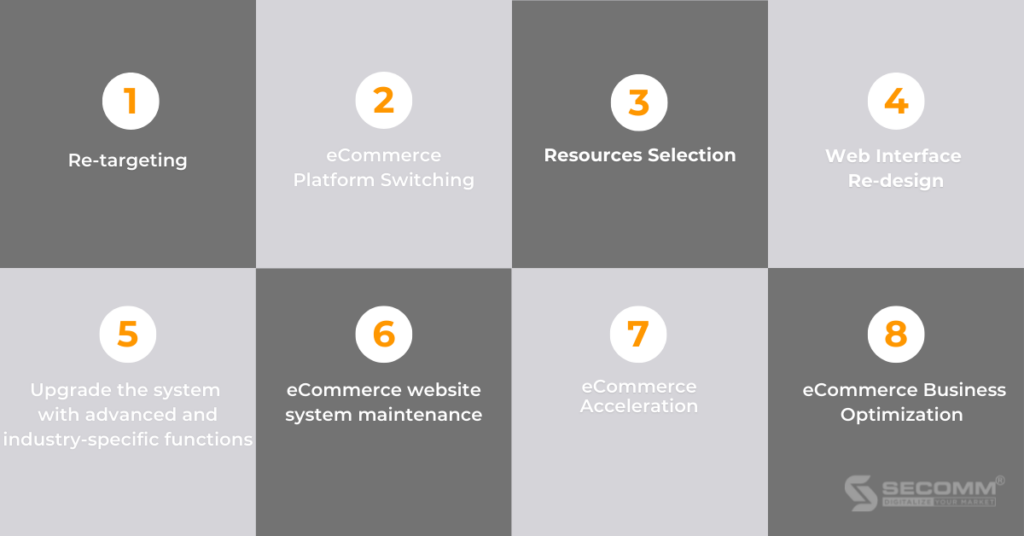
Re-targeting
Along the journey of business development that comes with ever-changing consumer needs, business goals and strategies need to be adjusted and reconfigured to fit the current business landscape In addition, at this stage, businesses also have problems, data, and insights about their online users, so setting goals will be easy.
In the short term, companies can use efficient marketing techniques to locate and connect with a wider pool of new potential clients online and boost online sales.
In the long run, market sector expansion and building a loyal customer base might be objectives for furniture eCommerce firms. In the second step of the trip to create a successful eCommerce website, businesses will simply develop and implement marketing strategies in accordance with the product features and individual directions of each business by identifying the target market segment.
Businesses must prioritize thinking about the time and cost of investing in a furniture eCommerce website system in addition to short- and long-term objectives because at this stage, the cost and investment budget will frequently be substantial and much higher than the above basic building phase.
eCommerce platform switching
If a company decides to use the SaaS platform to create an internal eCommerce website in the first stage, it will not be able to satisfy the expectations for development and expansion in the second stage due to its restricted customization and capability. Businesses should now convert to an open-source platform with well-known names worth considering, such as Magento, WooCommerce, Ziel Commerce, etc., in order to create an advanced furniture eCommerce website.
Following are some criteria for furniture companies to take into account when selecting an Open Source platform:
- Support to design standard UI / UX website interface with beautiful and high-quality images and videos, showing the unique characteristics of the brand and the furniture eCommerce industry.
- Provide a functional system from basic to advanced in the furniture industry
- High levels of scalability and customization enable the creation of specialized features as well as the integration of several add-ons, third-party services, and administrative support that extends from a single website to numerous websites, multiple language support, multiple currencies, etc.
- High levels of security assist businesses in reducing the dangers from illegal access to the data system and, when necessary, aid in data recovery for the eCommerce website system.
Businesses should focus on the costs associated with switching from a SaaS platform to an Open Source platform, the time required for staff to adapt to the new platform, the risk of data loss, and any errors that may occur during the changeover.
Resources selection
Resource selection for the deployment of an advanced system must be made with considerable thought, in contrast to the basic system development phase. Businesses have the option of creating an internal team or hiring a professional website developer to assist them.
The business will hire and train skilled and specialized IT people on the selected platform for internal team building which requires a lot of time and money, but it will improve resource management and control and actively adapt the development of the eCommerce website system in line with the original objective.
Businesses frequently consult several eCommerce website developers before choosing the finest one for their collaboration. The needs of the businesses for an eCommerce website will thus be satisfied as anticipated, the collaboration process will go smoothly, and the businesses will gain more expertise and experience in website development from that partner, which will provide them with directions consistent with the development trend of the furniture eCommerce industry.
These are the criteria that businesses should consider when choosing: In-depth knowledge and experience in eCommerce and the furniture industry; professional working team; clear and detailed working process; ability to quickly handle problems that arise during website construction.
Web interface re-design
Businesses are not required to update the website interface while switching platforms. However, the redesign of the website interface to fit the Open Source platform is now turning out to be a beneficial piece of advice given the new company development plan introduced concurrently with the implementation of eCommerce websites at a more advanced level.
Similar to the preceding period, companies have three alternatives for designing the user interfaces of their eCommerce websites: they can use the existing interface, customize it based on the existing interface, or create their own interface. To ensure the distinctiveness of the brand and the particularity of the furniture eCommerce industry, businesses should typically use methods 2 or 3 to develop the interface at this stage.
Upgrade the system with advanced and industry-specific functions
Businesses should concentrate on establishing a system of advanced and specific features of the furniture eCommerce industry to suit the new development phase, in addition to the basic functions that have been established for the eCommerce website system in the early stages.
Businesses may better grasp the challenges of implementing intense furniture eCommerce and provide solutions to address those challenges and fulfil the market’s rising expectations thanks to advanced and distinctive functions.
As a result, companies use AR technology to improve the consumer experience. While augmented reality (AR) technology is built on virtual reality (VR) technology, it focuses on fusing the actual environment and digital data to give users the ability to view digital data in the physical world. The furniture eCommerce sector makes extensive use of this technology.
Customers now only need to download the company’s AR program, turn on the camera, and evaluate the product’s fit with the area of the house rather than physically going to the store to see the things and try them on to see whether they fit.
Customers’ buying experiences are improved and made more unique by augmented reality (AR) applications, which convert traditional marketing into interactive marketing. IKEA Place App, the furniture buying an app from “big man” IKEA, is a wonderful example because it offers clients a novel and engaging shopping experience.
Customers can use their smartphones to place and try out the more than 2,000 tables, chairs, sofas, shelves, and other household appliances in a real room, change the viewing angle, and zoom in and out. Also, the software will scale items to their true size with 98% accuracy.
The eCommerce website system maintenance
A sophisticated eCommerce website system demands a great deal of experience and effort to operate and maintain. This is the procedure of continuously maintaining, updating, and upgrading the entire system to aid firms in foreseeing and resolving problems (for example, sudden increase in traffic from the promotions that stimulate shopping).
That supports sustained and persistent online sales growth, which is important for eCommerce businesses in general and furniture eCommerce in particular as they compete for a market share of this “pie,” which is “delicious” but can be challenging to consume.
eCommerce acceleration
Furniture eCommerce enterprises readily accomplish growth above and beyond expectations by putting into practice efficient business and marketing strategies.
Therefore, the entire process—from planning through implementation—must be structured with effective, practical solutions that have been demonstrated to work. Implementing Omnichannel, eCommerce Marketing, and SEO optimization are some suggested methods for eCommerce enterprises to accelerate growth.
eCommerce business optimization
The journey of developing an eCommerce website ends with measuring, analyzing, and optimizing eCommerce business activities.
Businesses can use analytics tools such as Google Analytics, Google Tag Manager, Facebook Pixel, etc., to track, update and measure website performance metrics as well as the effectiveness of marketing campaigns.
From there, the eCommerce business strategy for the next stage of development will be carefully and methodically planned thanks to clear and detailed reports & analysis.
Some special notes for furniture eCommerce website development
The journey of developing an eCommerce website for the furniture sector is divided into two phases with clear step-by-step instructions. Businesses will, however, be able to go in one of two strategies, each with its own advantages and drawbacks, depending on the platform they decide to use for the first phase.
Strategy no.1: Initially use an eCommerce SaaS platform before switching to an Open Source platform later on.
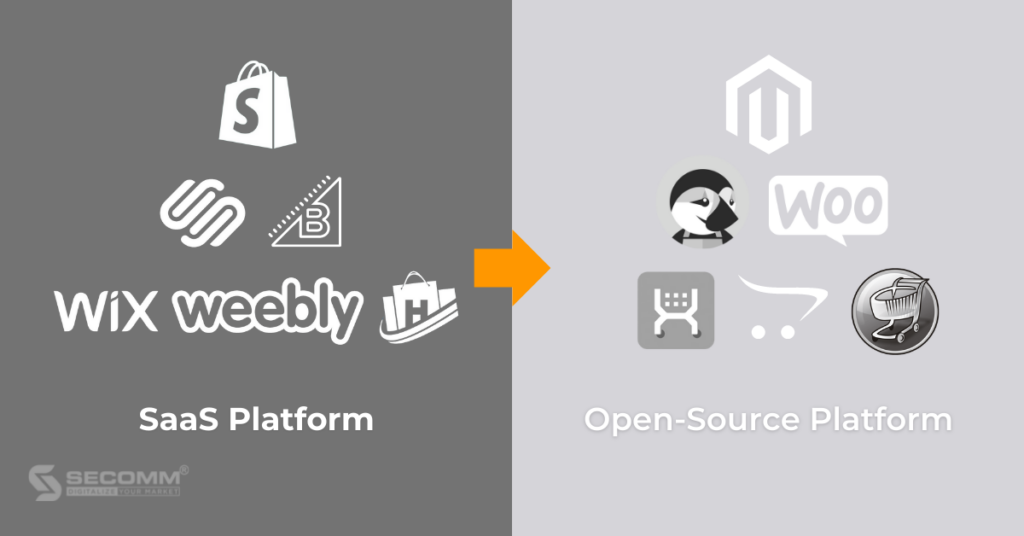
Pros
The quick deployment time of a SaaS platform is one of its benefits. In order to swiftly enter the market and create a simple website system, enterprises can pick SaaS at an early stage. Businesses will evaluate the furniture items’ suitability for the eCommerce market’s demands as well as their influence on upcoming consumer trends there.
The switch to an open-source platform will make it more reasonable to extend and develop a specialized website system in order to raise brand awareness and increase online sales over a period of time long enough for businesses to become accustomed to and adapt to the ever-changing market.
Businesses will save a lot of money by implementing eCommerce utilizing the SaaS platform early on as opposed to developing a website using the Open Source platform. Businesses can use that capital to invest in other activities, such as marketing strategy, which is one of the crucial components for the success of any company, not only furniture companies, because the initial cost of a SaaS platform is typically not too expensive.
The ability to conduct business while gaining knowledge and expertise in technology and how to efficiently implement eCommerce is another advantage of this approach to developing an eCommerce website. In general, running a business is challenging, and operating an eCommerce firm is even more challenging in today’s continuously shifting market and technologically complicated and varied trends.
As a result, acquiring knowledge and real-world experience is both a necessary and a sufficient condition for businesses to achieve extraordinary success. Because a SaaS platform is simple to use and doesn’t require a lot of technical knowledge, choosing one to deploy in the early stages can help businesses become comfortable with eCommerce terminology, concepts, and how to build a website at a basic level.
Due to the complex requirements of an extensive eCommerce website system, businesses will need support from a strong IT team during the second stage of switching to the Open Source platform. The collaborators and partners will then complement each other’s knowledge and experience at that point.
Cons
As was stated in the introduction to the platform, the fundamental functional system of SaaS platforms will not be sufficient to meet the needs of the eCommerce business at the growth and scalability stage.
Therefore, whether you like it or not at this moment, you must switch to the Open Source platform in order for the eCommerce system’s expansion and scalability goals to continue to be successfully implemented.
When adopting this approach for the process of developing and perfecting the website system, eCommerce firms in general, and furniture enterprises, in particular, should pay close attention to this first drawback.
Businesses will significantly reduce the initial cost of the working process by using this strategy. The initial benefit, though, later turns into a detriment in the long run. In addition to the ongoing platform usage fees that companies must pay for the SaaS platform, additional service costs are also significant enough to complicate and make cash flow management challenging to manage.
Because of the characteristic of the SaaS platform, customers are not permitted to keep the source code and data when switching platforms, thus enterprises must once again pay the initial development costs after the stage of moving to the Open Source platform. Additionally, the cost of development using an Open Source platform is rather costly, ranging between $30,000 and $50,000 on average.
Additionally, firms will “headache” from the sunk costs associated with switching platforms. The cost of staff training is seen as an additional expense rather than a true investment if you are accustomed to the new system, especially at a time when the economy is anticipated to rebound following COVID-19.
Furthermore, it is easy to make mistakes during the platform shift that result in the loss of crucial firm data, such as data that is closely tied to financial matters. With all the hazards mentioned, managing cash flow and maintaining balance is still a challenging issue that obviously affects furniture companies’ eCommerce business strategies.
Strategy no. 1 will be appropriate for startups or SMEs learning about eCommerce and entering the market safely based on the pros and disadvantages highlighted.
Strategy no.2: Implement an open-source eCommerce platform from the first phase on and use it throughout the second phase.
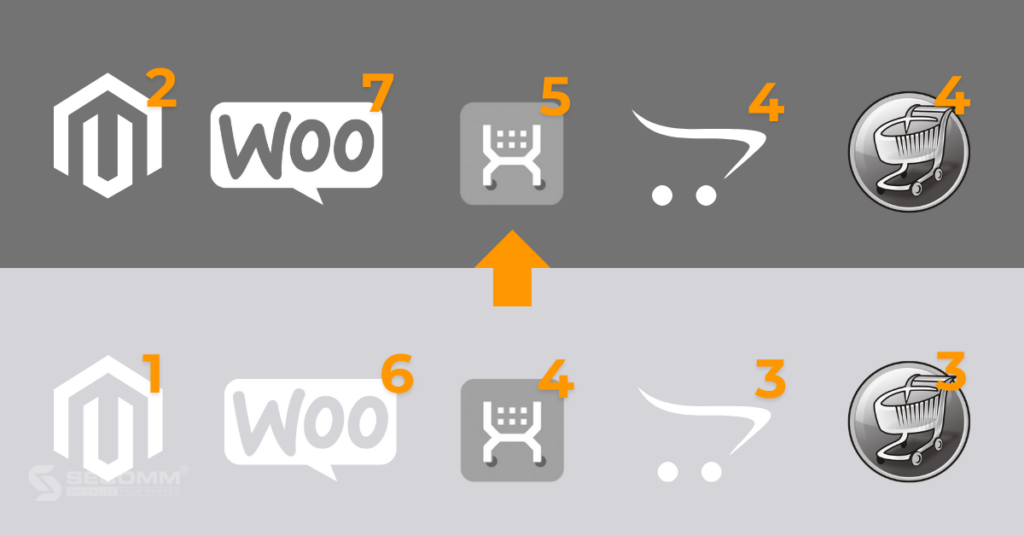
Pros
With the second strategy, companies develop eCommerce websites on the Open Source platform from the very beginning. Due to the smooth website development process, businesses merely need to gradually improve their functional systems in line with their growth and scale rather than switching platforms.
Long-term cost savings for enterprises are made possible by this seamlessness. In which, addition to saving money by avoiding the cost of starting over when switching platforms as a first strategy, firms also minimize the danger of data loss and spend less time and money training staff to use the brand-new platform.
The second approach, on the other hand, aids firms in laying a strong foundation right away with a professionally designed and smooth eCommerce website system and a team of essential technical personnel who are knowledgeable and well-trained from the start.
Cons
Similar to the first strategy, despite its notable benefits, the second one still has some drawbacks that companies should take into account before implementing furniture eCommerce. The market penetration will be slowed down if Open Source is chosen for the first phase of the deployment process.
All of the website’s features will be designed from the ground up because it will be built on an open-source platform. It takes the team a lot of effort, time, and brainpower to accomplish the entire process, which often takes between three months and a year.
Therefore, the lengthy implementation period is a drawback that slows down market entry, increasing the risk of falling behind in the competitive eCommerce race. Correspondingly, firms will have to pay a considerably larger upfront development fee than they would for a SaaS platform.
When companies must invest a significant sum of money in a platform upfront yet are unsure of its viability and effectiveness for adopting eCommerce, there is a risk involved.
From a business perspective, this drawback is viewed as an opportunity cost, meaning that while this strategy offers firms enormous long-term rewards, it also comes with trade-offs that present difficulties in the short term.
To meet growth and scalability objectives as well as avoid potential risks from switching platforms mentioned in advance, or to make the process of eCommerce implementation simple and efficient.
Therefore, it is incredibly appropriate to invest time and money in starting from scratch with Open Source.
The second approach can be appropriate for firms with a variety of business models, including B2B, B2C, and B2B2C, when the advantages and downsides are carefully thought.
With the high growth rate of Vietnam’s economy, eCommerce makes a significant contribution to promoting the flow of goods and services, supporting small and medium enterprises, especially those in the furniture sector, to seek effective business opportunities in the context of deep integration and the spread of the 4th Industrial Revolution.
Moreover, a qualified eCommerce website serves as a “bridge” for furniture companies to achieve that integration objective. However, building a comprehensive, modern, and professional eCommerce website is never simple and necessitates a significant financial investment.
The journey to develop an eCommerce website is described above in great detail by SECOMM with a few extra tips that furniture businesses can refer to shorten your own planning.
With many years of experience in successfully implementing eCommerce for many customers in many countries in recent years, SECOMM understands the difficulties and challenges in the process of implementing an interior eCommerce website.
Contact SECOMM today for free support and advice.
 2
2

 1,600
1,600

 1
1

 1
1
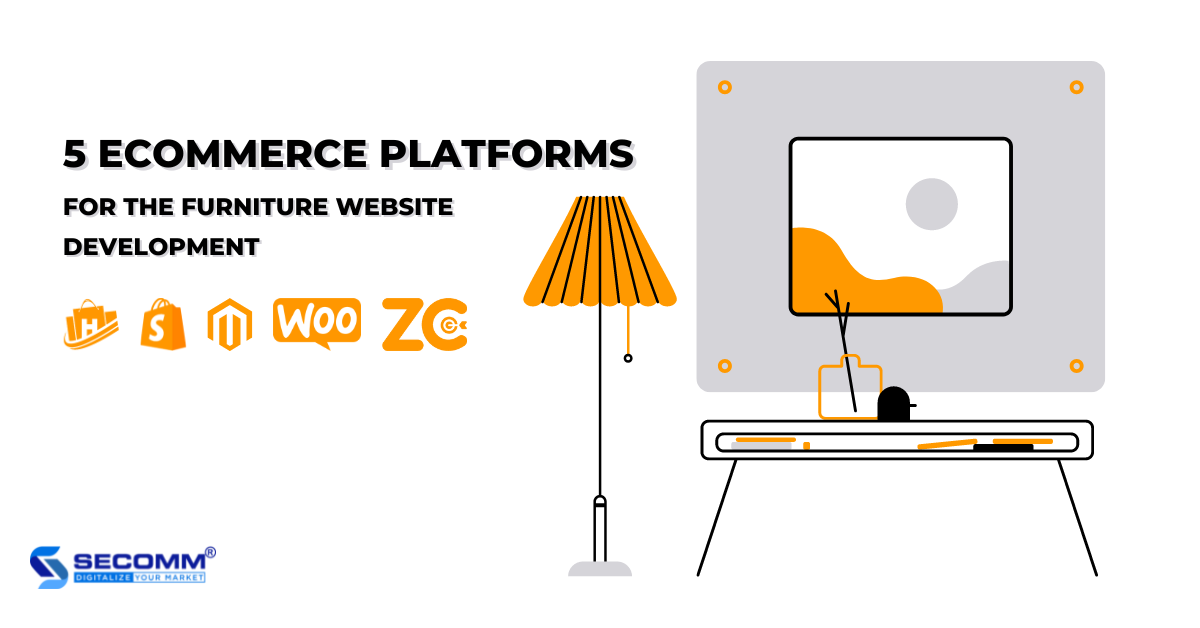
5 ECOMMERCE PLATFORMS FOR THE FURNITURE WEBSITE DEVELOPMENT
eCommerce is currently developing into a fresh and promising sales channel for furniture companies in addition to the traditional sales channel. Businesses must work hard to sustain and achieve breakthrough growth through eCommerce platforms, though.
As a result, numerous furniture companies started developing online furniture business websites and found surprising success, such Sieu Thi Noi That va Trang Tri Baya, Nha Xinh, Cozy, or Noi Phat Hoa Phat.
These websites’ success can be attributed to their early selection of an adequate and suitable eCommerce platform. Which platforms are appropriate for the furniture industry, then?
Main aspects of the eCommerce furniture industry
UI/UX standard furniture eCommerce website interface
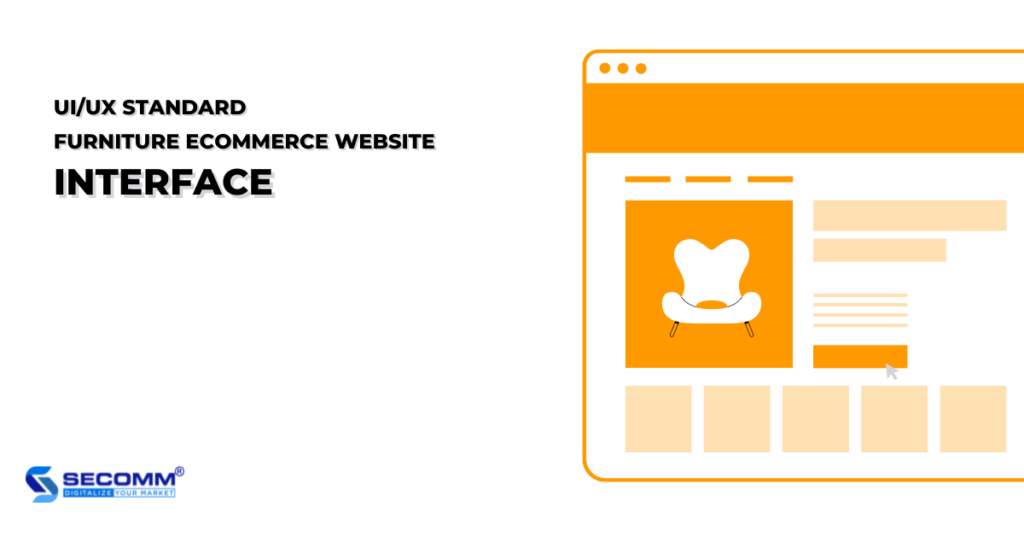
The first criterion businesses set when developing an eCommerce website is a standard UI / UX interface, friendly to users who enjoy shopping for furniture online and other home goods to increase customer interaction.
Similar to eCommerce websites in other sectors like fashion, electronics, etc., websites in the furniture sector must feature stunning and high-quality photographs and videos.
This makes it simpler for companies to communicate product information to customers, especially with banner advertisements that have an easy-to-use interface and a pleasing style that will pique shoppers’ interests.
Businesses also need to consider other concerns including call-to-action button placement, cross-device compatibility, and layout designs that display a range of product designs from the navigation bar to page-by-page details.
Comprehensive functional system

Furniture firms need a functional system from basic to advanced to fully meet consumers’ buying expectations and maximize the user experience. This system should include:
- Catalog Management: Manage properties, pricing systems, inventory, photos, and videos to keep them running
- Content Management: Content development for CMS pages, image hosting, theme customization, and website design
- Customer Management: Control information, behavior, and consumption habits to build strategies for each specific customer group
- Sales Management: Set up and operate sales, order, payment, and shipping processes
- Marketing Management: Implement and optimize programs to attract potential customers with built-in support tools
- System Management: Seamless supply chain response with shipping navigation and automation management tools
- Store Management: Navigate and maintain your eCommerce business from online to offline
- Cart & Checkout: Manage shopping carts and process the next payment steps for customers
- Analytics and Reports: Monitor and measure eCommerce performance to give detailed reports to improve business efficiency
Businesses also need to develop some additional specialized features to address the furniture industry’s “own challenge,” such as:
- Omnichannel to track customer footprints across all channels from eCommerce platforms, and social networks, to eCommerce websites and mobile apps to deliver a seamless shopping experience.
- VR/AR or 360-degree view brings a visual experience and realistic visualization of the product, thereby enhancing the online furniture shopping experience.
- Customers who request customized products can specify the colors, materials, and sizes they want and pay a deposit. The supplier will then continue to produce the furniture items in accordance with the requirements and deliver them to the customer once they are finished. The consumer will then pay the supplier the balance at that time.
Integration with a variety of third-party services
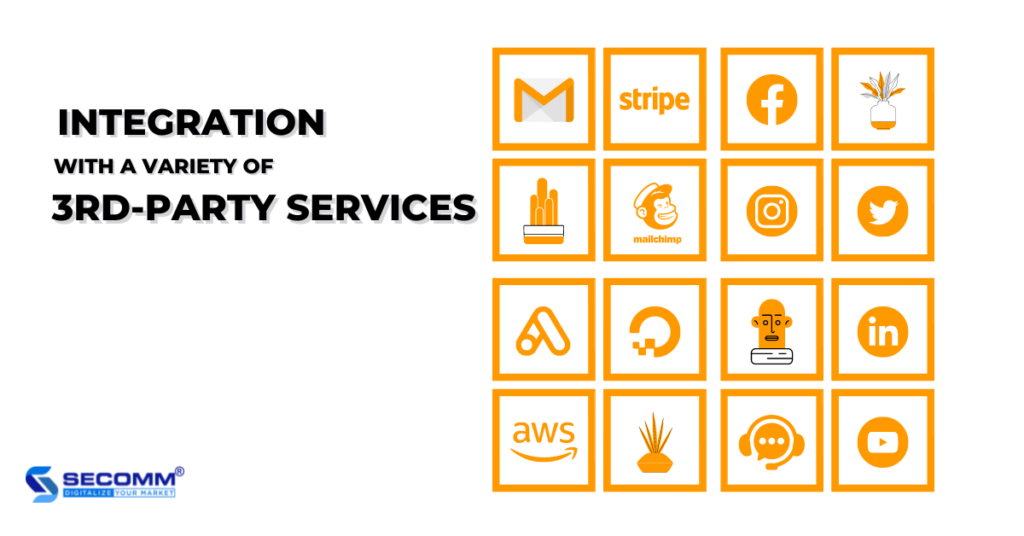
Furniture businesses frequently integrate a range of payment options, shipping services, management software, and business analysis tools to optimize eCommerce business systems in order to provide customers with a comprehensive shopping experience.
Some popular payment methods businesses can integrate on the website to diversify payment methods to help customers have many choices such as card payment; eWallet; payment gateways.
Businesses might take into consideration software like ERP (SAP, Salesforce, Oracle), among others, when integrating back-office administration and operation software.
Finally, incorporating BI tools like Tableau, Looker, etc. will aid in the long-term analysis of business plans.
Scalability of the website

Businesses that are just starting to use eCommerce won’t concentrate on the website’s scalability in the future because platforms that provide this feature are sometimes hard to find. But tactically, spending money on a platform that facilitates this function will provide organizations an advantage over rivals in the market.
These aid furniture companies in making necessary adjustments, creating new features, and expanding their online systems to support several stores, languages, and currencies in the future.
Top 5 eCommerce platforms for furniture website development
Haravan
Haravan was founded in 2014 and is a very popular and popular eCommerce deployment platform in the Vietnam market with a variety of solutions for businesses and individual sellers.
Pros:
- Available and diverse themes for the furniture industry
- Wide range of applications, from basic to advanced to start an eCommerce business
- Reasonable eCommerce deployment cost, various packages from 200,000 VND/month to 3,000,000 VND/month, making it easy for customers to choose.
- Time to build an eCommerce website is fast, only about 30 minutes for businesses to own a website with all the necessary features to get started. However, for the website to work effectively, businesses need to spend more time researching and developing the system.
Cons:
- The layout of existing templates causes duplicating, and it’s challenging to alter themes or create your own interface because doing so will have an adverse effect on the entire system.
- The system of specific functions for the furniture sector is still limited.
- Only integrated with services/utilities located in Haravan’s ecosystem.
- Because it is a SaaS platform, it will be difficult for Haravan to expand the website in the future.
=> Rating: 2/4
Haravan is suitable for start-up furniture businesses or SMEs (small and medium-sized enterprises) with operations mainly in Vietnam.
Shopify
Shopify is a popular SaaS platform in the world that provides a variety of solutions for businesses of all sizes to successfully build eCommerce websites.
Pros:
- Available and diverse themes for the furniture industry.
- Wide range of applications, from basic to advanced to start an eCommerce business.
- The initial cost is quite reasonable with a variety of options for businesses from $29/month to about $2,000/month.
- The time to build an eCommerce website is quite fast from 1-7 days, or more depending on the complexity of the system.
- Shopify has a large developer community to serve businesses.
Cons:
- The layout of existing templates causes duplicating, and it’s challenging to alter themes or create your own interface because doing so will have an adverse effect on the entire system.
- The system of specific functions for the furniture sector is still limited.
- A wider range of 3rd party services than Haravan but still only integrated with services available in Shopify’s app store.
- Deployment costs are both advantages and disadvantages of Shopify when the initial cost is quite reasonable, but in the long run, businesses have to pay the cost of using the platform, interface, application, etc., regularly every month. This makes it difficult to manage cash flow
- Because it is a SaaS platform, it will be difficult for Shopify to expand its website in the future.
=> Rating: 2/4
Shopify is considered suitable for start-ups or SMEs with global operations.
ZielCommerce
ZielCommerce is an eCommerce platform with ready-made solutions specialized for the furniture industry.
Pros:
- Many themes are specific to the furniture industry, allowing businesses to customize according to their needs, helping to reflect the characteristics of the industry and position the brand image.
- Detailed internal eCommerce website construction challenges can be solved with the help of a comprehensive system of functions that combines the fundamental, sophisticated, and niche aspects of both customer and business needs, such as the best order processing system.
Cons:
- The ability to integrate with 3rd party services is still limited. This platform only supports add-ons available in its ecosystem, so businesses will not be able to link with the ERP, POS, CRM, BI, etc. Therefore, when using Ziel Commerce, businesses need to transfer all existing data to the platform’s servers.
- Although highly appreciated for the ability to expand the website system, this is still the disadvantage of Ziel Commerce in the long run. Accordingly, this platform will not support businesses to expand or develop new features because businesses cannot own the source code, so when affected, it will destabilize the entire website system.
- Ziel Commerce is not yet popular in the Vietnam market, so there is no Vietnamese version yet.
- Deployment time will depend on the complexity of the system, the average time is from 3-6 months.
- High implementation cost of about $50,000 per project.
=> Rating: 3/4
ZielCommerce will be the optimal choice for B2B, and B2C furniture businesses to deploy eCommerce websites or build mobile apps. However, this platform is not really popular in the Vietnamese market but is especially favored by foreign furniture retailers such as Frampo, Zeyka, etc.
WooCommerce
WooCommerce is a free WordPress plugin that allows businesses to transform a regular WordPress website into a professional eCommerce website with full features and easy customization with just a few simple steps.
Pros:
- There are many free and premium themes from the WordPress and WooCommerce communities for the furniture sector which are easy to customize or businesses can use self-designed themes.
- Functional system from basic to advanced for eCommerce business.
- Easy integration with a variety of 3rd party services.
- Because it is an open-source code platform, businesses can plan to expand their website in the future.
- The cost of building an eCommerce website is not too high compared to other open-source platforms like Magento, with total annual costs ranging from $110 to $1,500+ for domains, hosting, themes, extensions, plugins, etc.
- eCommerce website implementation time with WooCommerce takes about 1 to 3 months to complete.
Cons:
- The functional system is still limited in terms of features specific to the furniture industry.
- The scalability is not as high compared to other open-source platforms such as Open Cart, Magento because it depends on the WordPress system.
=> Rating: 3/4
WooCommerce will be suitable for furniture businesses who are familiar with the WordPress platform and want to develop an eCommerce system.
Magento
Magento is a popular open-source commerce platform in the field of eCommerce, with nearly 200,000 websites in use. Currently, Magento has 2 versions: Magento Open Source (free), and Magento Commerce (paid).
Pros:
- Many furniture themes from the global developer community and Magento website developers so businesses can use existing themes which easy to customize or use self-designed themes.
- Easy integration with a variety of 3rd party services.
- High scalability: multi-language, currency, easy future feature development.
Cons:
- There is no repository of themes from Magento to support businesses.
- Implementation typically takes three to six months, but it might take up to a year due to a sophisticated functioning system.
- Although the platform is free to use, the cost of implementing eCommerce with Magento is quite high, about $50,000-$100,000 depending on the complexity of the project.
=> Rating: 4/4
Magento is appropriate for a range of furniture business types, including B2B, B2C, and B2B2C, as well as for various business sizes, including start-ups, SMEs, and major companies. However, large organizations use Magento because it is frequently relatively expensive to deploy.
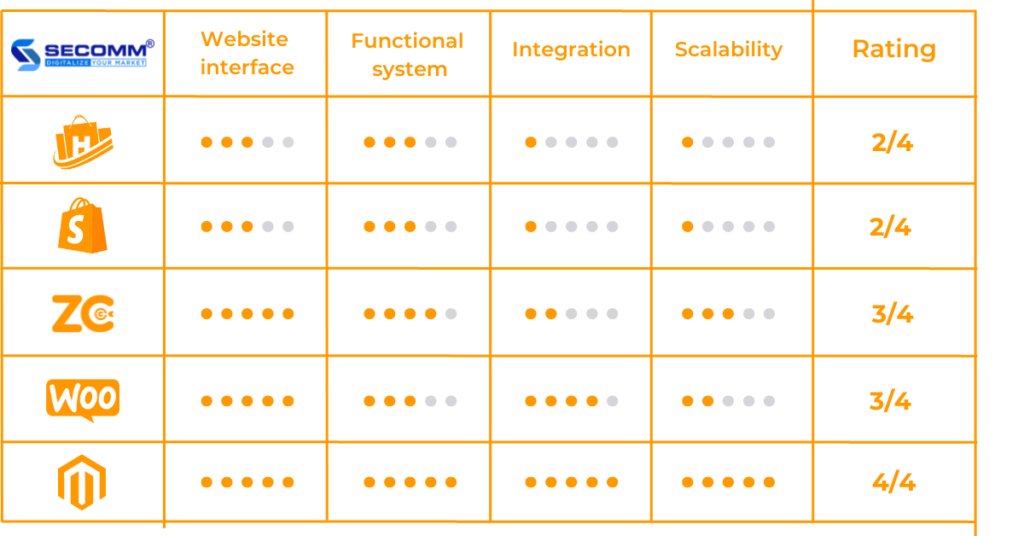
Choosing the right platform is an extremely important first step when building an interior eCommerce website. Choosing the right eCommerce platform will help businesses save budget and time to build a website while increasing competitive advantage and sustainable growth. On the contrary, when choosing the wrong platform, it will cost businesses a lot of time and budget to deploy and switch platforms many times. Therefore, businesses need to consider the goals and problems in the current model to be able to choose the most suitable platform.
With many years of experience in successfully implementing eCommerce for many customers in many countries, SECOMM specializes in providing consulting services with comprehensive and professional eCommerce implementation solutions.
Contact SECOMM today for free support and advice.
 2
2

 2,653
2,653

 0
0

 1
1

TOP 10 INCREDIBLE WINERY ECOMMERCE WEBSITE IN VIETNAM 2022
Many businesses have promoted winery eCommerce in the context of the Covid-19 pandemic, which has been described as a “nightmare” for many economic sectors but appears to be “luck” for eCommerce.
According to Rabobank, eCommerce sales in the wine industry will reach USD 6 billion in 2021, up 4% from the same period in 2020. As said by Forbes, the percentage of online wine orders increased significantly compared to previous years before the pandemic.
Recognizing the potential of this field, many wineries in Vietnam have begun to develop eCommerce websites in order to quickly establish a market position.
Nam An Market
Nam An Market is a retail chain of healthy food stores that Nam An International Investment Co., Ltd. invested in in 2012. Its eCommerce website, which receives over 100,000 visits per month, was built successfully on the Haravan platform.
Aside from fruits, vegetables, meat, and fish, alcoholic beverages, particularly wines, are popular on Nam An’s website. Furthermore, the online shopping experience focuses on safety, convenience, speed, reasonable prices, and various appealing incentives.
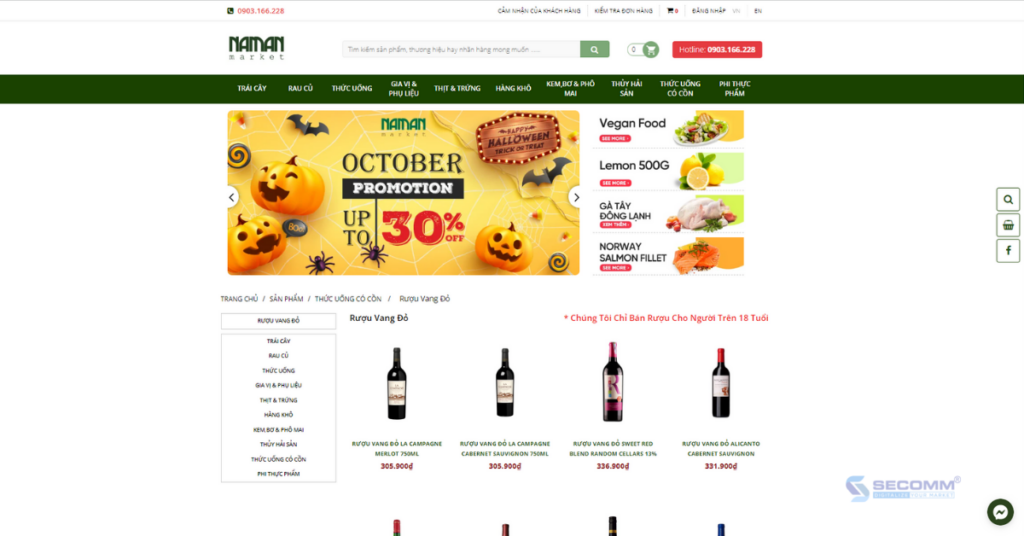
- Website: https://namanmarket.com/
- eCommerce platform: Haravan
- Traffic: 101.3K/month
- Ranking: 9,079 (Vietnam); 404,452 (Worldwide)
Winemart
Winemart was founded in 2015 to provide consumers with the best services and products possible. Currently, Winemart operates in two main areas:
- Premium wine brand distribution
- Design and package Tet gifts for businesses and customers as needed.
Winemart’s eCommerce website receives over 60,000 visits and is regarded as one of Vietnam’s most prestigious online wine suppliers.
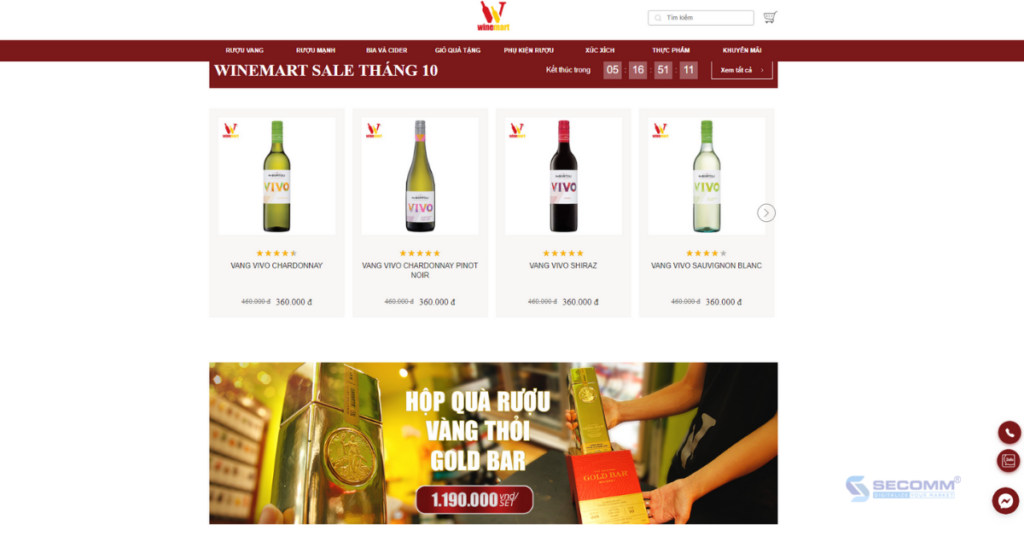
- Website: https://winemart.vn/
- eCommerce platform: WooCommerce
- Traffic: 66.4K/month
- Ranking: 17,459 (Vietnam); 730,667 (Worldwide)
Sieu Thi Ruou Ngoai
Sieu Thi Ruou Ngoai is not only an eCommerce website that sells imported foreign wine but also a knowledge system about culture, history, and how to choose, preserve, and enjoy wines from around the world, allowing people who are passionate about or want to learn about wine culture to share and improve their understanding.
Sieu Thi Ruou Ngoai now has its own eCommerce website system, which receives over 50,000 visits per month and is highly regarded by customers for both product quality and online shopping experience.
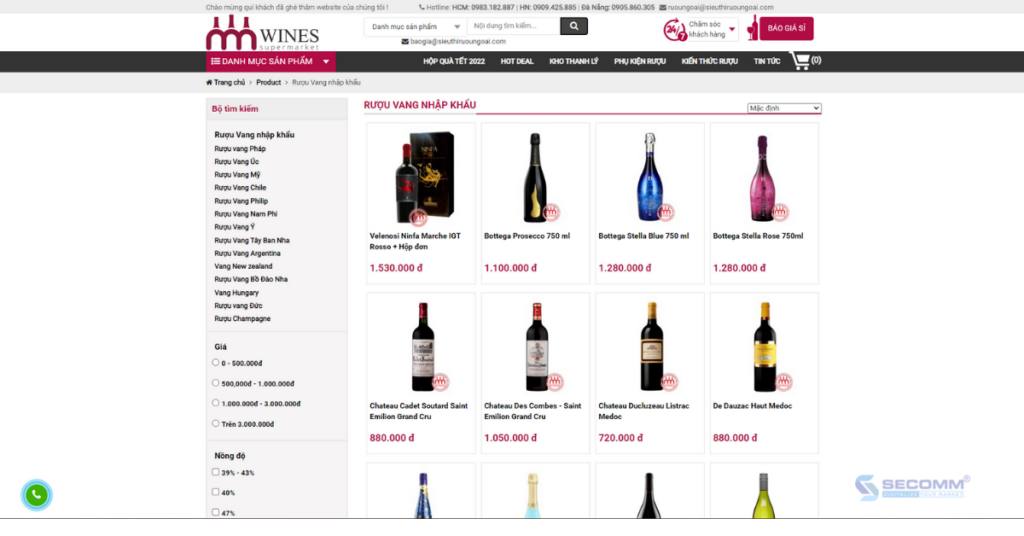
- Website: https://www.sieuthiruoungoai.com/
- eCommerce platform: PHP language
- Traffic: 48.1K/month
- Ranking: 16,664 (Vietnam); 735,935 (Worldwide)
Ruou Vang Cao Minh
Cao Minh was founded and developed by CEO Thanh Dung, a wine enthusiast who is passionate about learning about wine culture. After many years of research, learning, and improving service quality, Cao Minh has fully converged all the factors to become Vietnam’s leading wine supplier.
Cao Minh’s website is written in PHP and includes all the necessary features and an easy-to-use interface. Cao Minh Wine has become a household name among customers who prioritize online wine shopping.
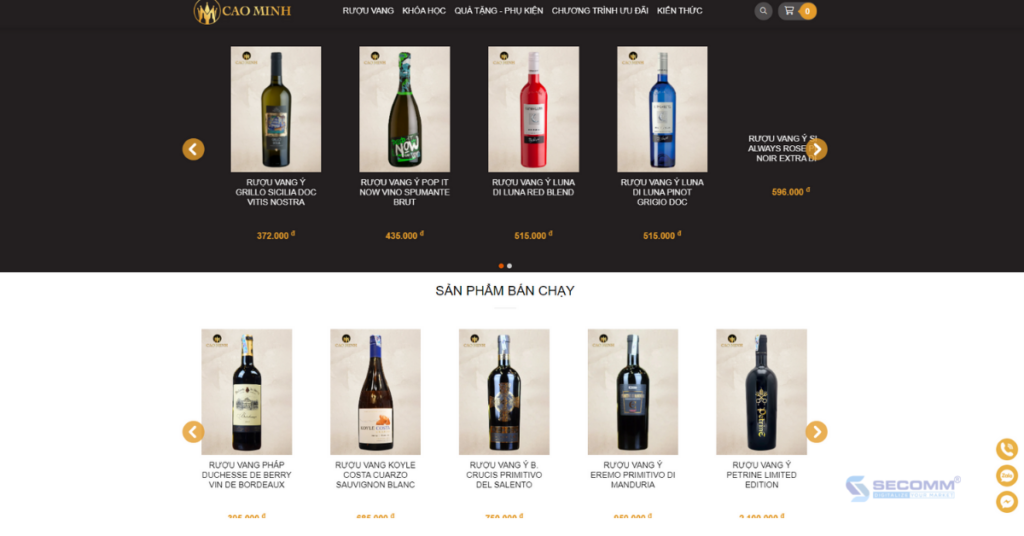
- Website: https://ruouvangcaominh.vn/
- eCommerce platform: PHP language
- Traffic: 45.9K/month
- Ranking: 22,324 (Vietnam); 982,166 (Worldwide)
Kho Ruou
Kho Ruou, also known as Kho Ruou Co., Ltd., is Vietnam’s leading importer and distributor of foreign wines and spirits, with over 3000 products of wine, spirits, beer, Japanese sake, and genuine high-end accessories.
Kho Ruou pursues an eCommerce business model by investing in developing a website using the WooCommerce platform. As a result, the company can easily reach a large number of potential customers both online and offline.
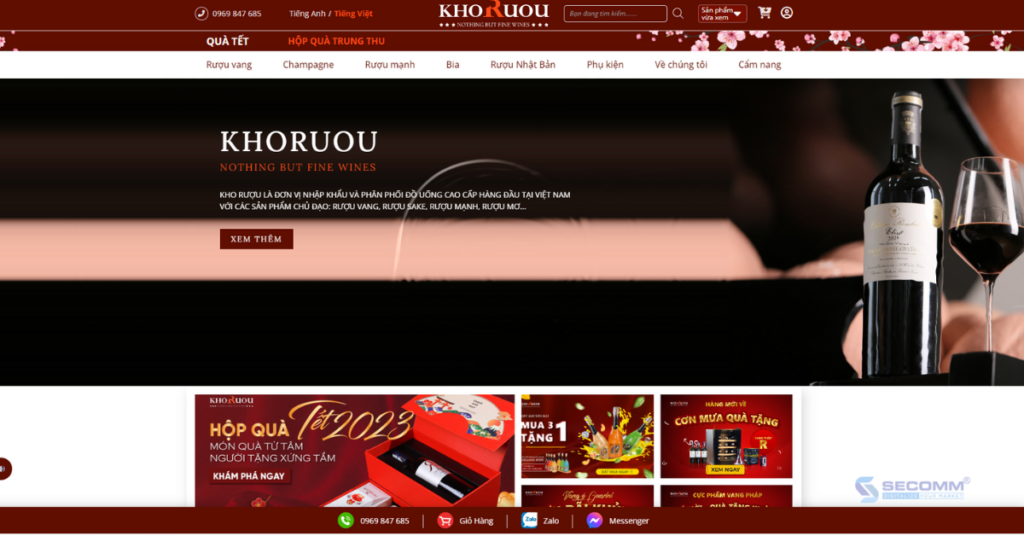
- Website: https://khoruou.com/
- eCommerce platform: WooCommerce
- Traffic: 32.9K/month
- Ranking: 52,372 (Vietnam); 2,140,674 (Worldwide)
Ruou Tot
When eCommerce is a new trend widely praised by the Covid-19 pandemic. To keep up with that trend, Wine Tot built an eCommerce website with WooCommerce, which helped to increase brand coverage and reach a large number of potential customers on the Internet.
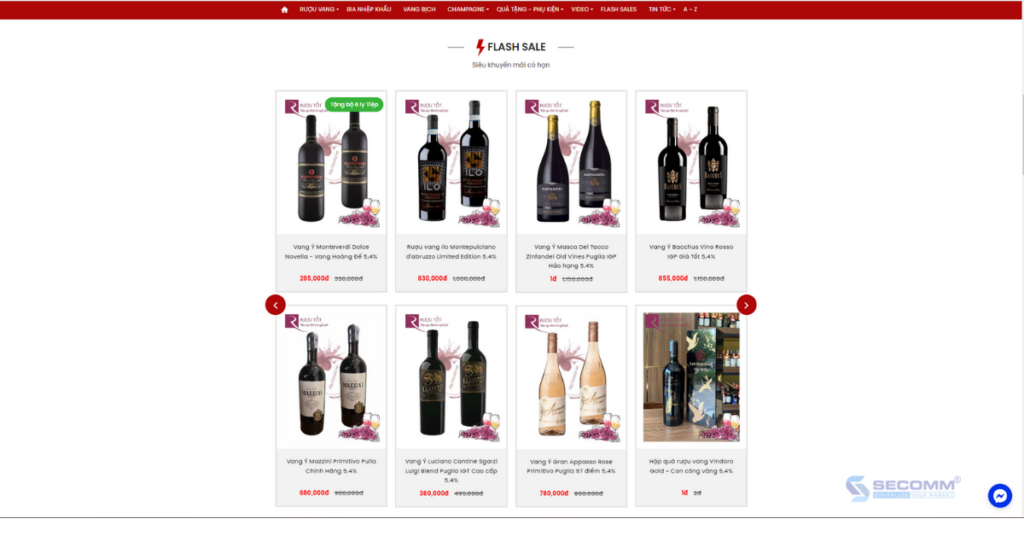
- Website: https://ruoutot.net/
- eCommerce platform: WooCommerce
- Traffic: 36.3K/month
- Ranking: 21,489 (Vietnam); 943,255 (Worldwide)
Ruou Nhap Khau
Ruou Nhap Khau is a wine eCommerce website operated by Ham Ruou Vietnam Co., Ltd, one of Vietnam’s leading import and distribution businesses.
Ruou Nhap Khau creates an e-commerce website with the PHP programming language. With an easy-to-use interface and good product quality and service, the company has gradually gained customer trust for its imported wine product lines ranging from popular to high-end.
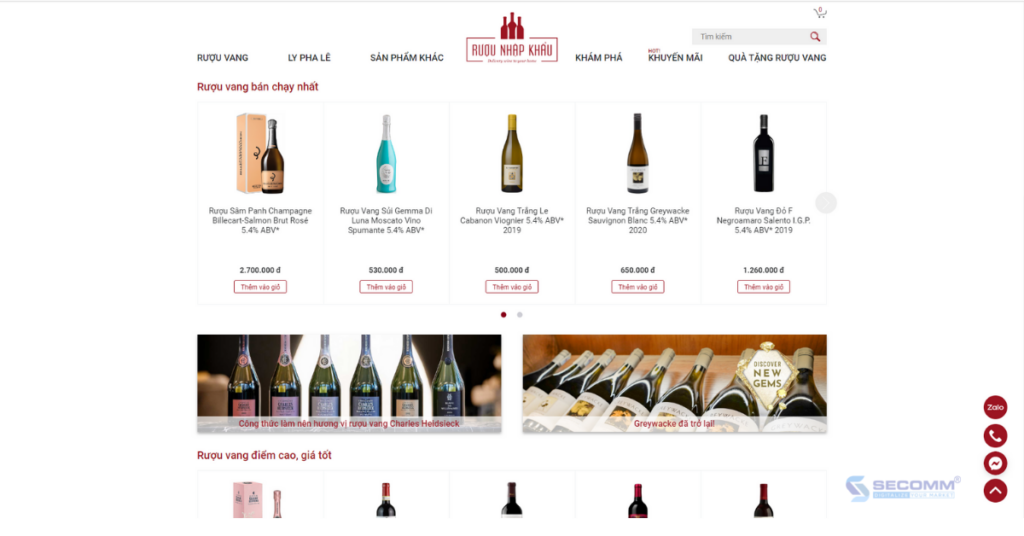
- Website: https://ruounhapkhau.com/
- eCommerce platform: PHP language
- Traffic: 28.3K/month
- Ranking: 31,246 (Vietnam); 1,334,043 (Worldwide)
Sanh Vang
Sanh Vang is a wine distribution brand founded in 2015 by Saigon Hoang Kim Investment and Trading Company Limited. Sanh Vang has expanded its branch network to many provinces, including Ha Noi, Ho Chi Minh City, Bien Hoa (Dong Nai), and Buon Ma Thuot.
Furthermore, Sanh Vang’s eCommerce website receives over 25,000 visits per month, and the brand receives many positive reviews from customers due to its wine quality, competitive price, available stock, and variety.
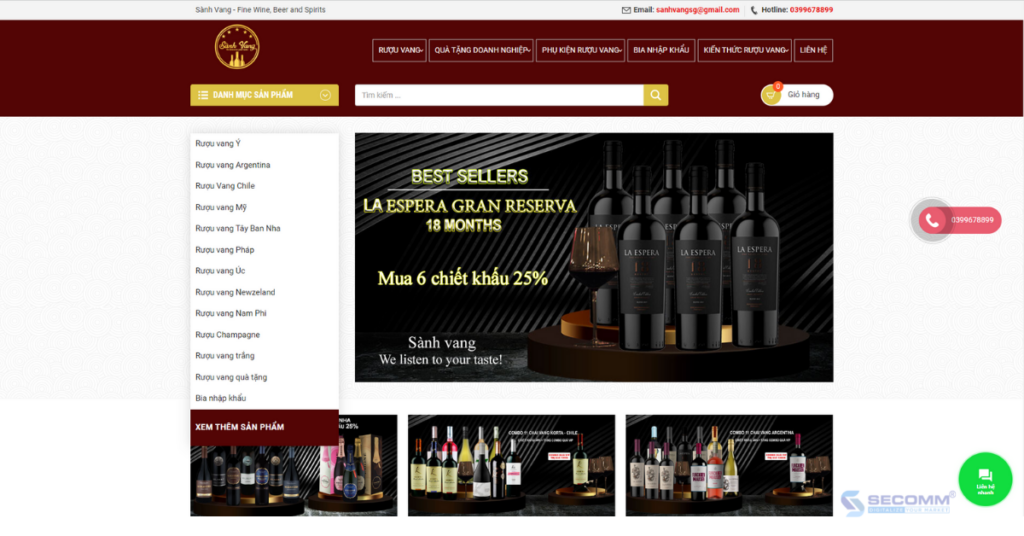
- Website: https://sanhvang.com/
- eCommerce platform: WooCommerce
- Traffic: 25.4K/month
- Ranking: 545,398 (Vietnam); 1,735,237 (Worldwide)
Winecellar
Winecellar, founded in 2007, is one of Vietnam’s largest wine companies, specializing in high-quality wine, beer, whiskey, food, mineral water, tea, and ceramic products. Winecellar, like Kho Ruou and Sanh Vang, uses the WooCommerce platform to implement eCommerce.

- Website: https://winecellar.vn/
- eCommerce platform: WooCommerce
- Traffic: 21K/month
- Ranking: 48,961 (Vietnam); 2,063,194 (Worldwide)
The Warehouse
The Warehouse is a wine and spirits distributor in the Vietnamese market, as well as one of An Nam Group’s retail brands.
With a long-term and sustainable eCommerce business in mind, this brand has decided to invest in developing its own eCommerce website on the open-source Magento platform and continuously upgrading this system to provide a better eCommerce experience for customers.
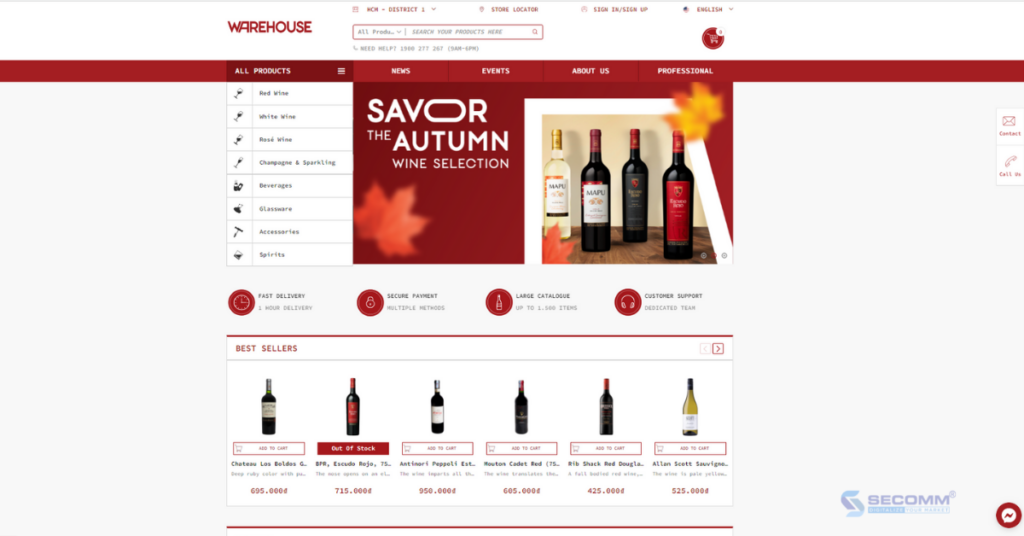
- Website: https://warehouse-asia.com/
- eCommerce platform: Magento
- Traffic: 5K/month
- Ranking: 78,311 (Vietnam); 3,571,809 (Worldwide)
In general, Vietnamese wine brands are reaping numerous market successes after successfully developing their own eCommerce websites. However, the wine eCommerce business necessitates careful consideration of tactics to take the most effective steps not only in the short term but also in the long term.
Furthermore, wineries need to find a support unit or build a highly qualified in-house team to help them to achieve a common goal.
With many years of experience implementing eCommerce in many countries, SECOMM provides free consulting services with professional eCommerce solutions.
Contact us today for free support and advice!
 2
2

 3,133
3,133

 0
0

 1
1
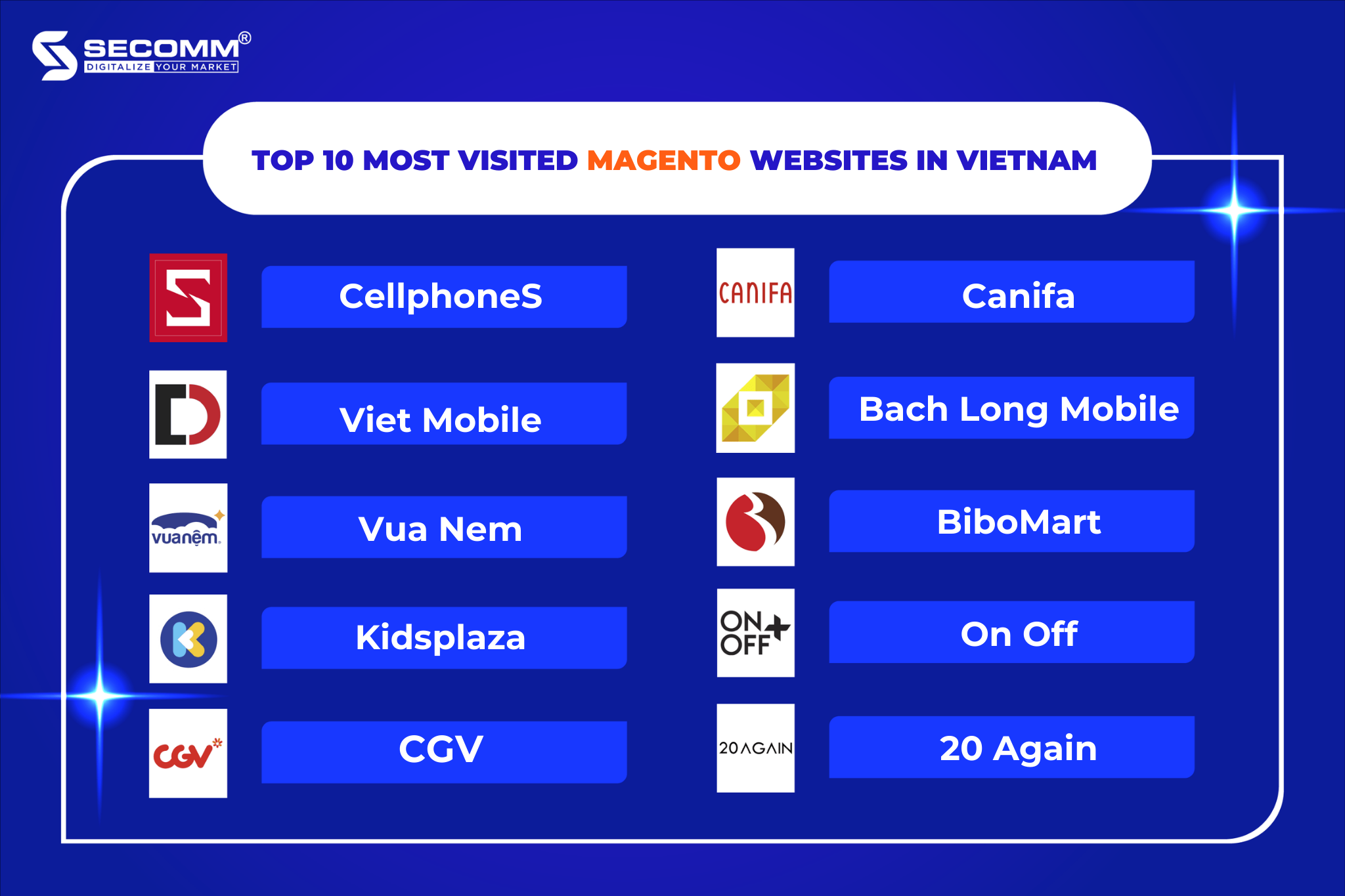
TOP 10 MOST VISITED MAGENTO WEBSITES IN VIETNAMESE MARKET
Magento is the leading open source eCommerce platform, powering over 186,000 websites worldwide. However, this platform has not been widely used in Vietnam, particularly among the community of new businesses entering the eCommerce market.
What is the Magento platform?
Magento is an open-source eCommerce platform written in the PHP programming language. Magento currently has two versions: Magento Open Source (free) and Magento Commerce (paid).
Why should businesses develop eCommerce websites on the Magento platform?
Inheriting outstanding advantages of open source eCommerce platform:
- Magento has a comprehensive set of features, ranging from basic to advanced, to serve all types of businesses, including B2C, B2B, and B2B2C eCommerce models.
- Customizability and extensibility make editing, building new functionality, and upgrading your eCommerce system easier.
- A diverse ecosystem and global technical support community provide diverse and continuous solutions, comprehensively and quickly resolving many eCommerce problems.
- High security, particularly for the administrator account, so that businesses can control data and reduce risks from website system transactions.
Top 10 most popular eCommerce websites in Vietnam using Magento
CellphoneS
In Vietnam, CellphoneS is a well-known retail system for technological products. The company is currently operating in Ho Chi Minh City, Hanoi, Binh Duong, Hai Duong, Hai Phong, Bac Ninh, Vinh Phuc, Thai Nguyen, and Vung Tau.

- Website: https://cellphones.com.vn/
- Traffic: 9.08M/month
- Expected online sales revenue: $49K+
- Expected website investment cost: $500+
- Used Version: Magento Open Source 1.9
Viet Mobile
Viet Mobile is a reputable electronics brand and a strategic partner of global technology corporations such as Apple, Samsung, Apple, OPPO, Sony, ASUS, and others.

- Website: https://didongviet.vn/
- Traffic: 1.98M/month
- Expected online sales revenue: $45K+
- Expected website investment cost: $1000+
- Used Version: Magento Open Source 2.3
Vua Nem
Vua Nem is a leading retail chain of mattresses, blankets, sheets, pillows and accessories with more than 100 stores spanning from North to South.

- Website: https://vuanem.com/
- Traffic: 1.44M/month
- Expected online sales revenue: $500+
- Expected website investment cost: $64K+
- Used Version: Magento Open Source 2.2
Kidsplaza
Kidsplaza is a big star in the mother and baby industry, with over 133 locations nationwide.\

- Website: https://www.kidsplaza.vn/
- Traffic: 816.17K/month
- Expected online sales revenue: $500+
- Expected website investment cost: $64K+
- Used Version: Magento Open Source 2.3
CGV
CGV, along with Galaxy, Lotte Cinema, BHD Star Cineplex, and CineStar, is one of the top five largest cinema clusters in the world and a major distributor and cinema cluster in Vietnam.

- Website: https://www.cgv.vn/
- Traffic: 674.80K/month
- Expected online sales revenue: $1.5M+
- Expected website investment cost: $2000+
- Used Version: Magento Commerce
Canifa
CANIFA is a fashion brand that specializes in designing clothes, accessories, and retailing casual wear for families. It is currently owned by the Hoang Duong Textile Group.
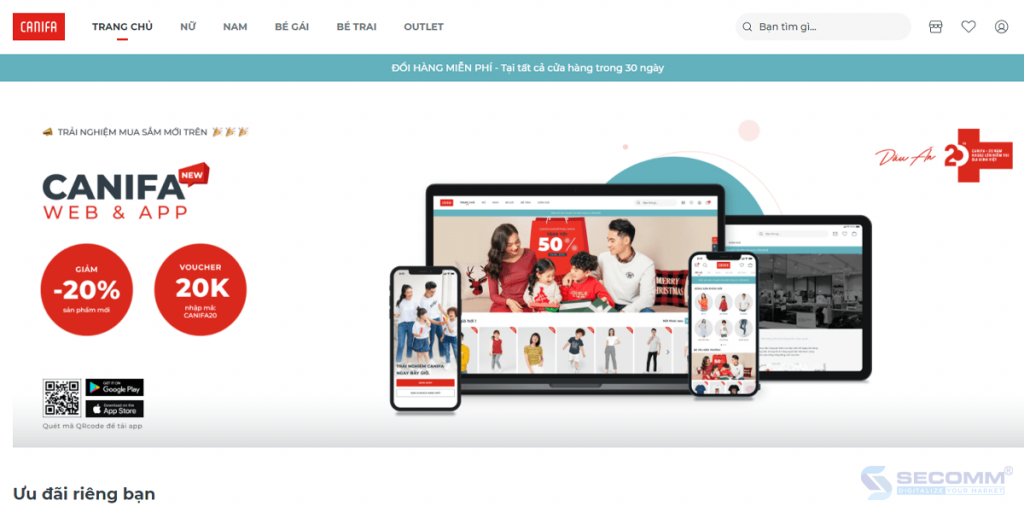
- Website: https://canifa.com/
- Traffic: 293.41K/month
- Expected online sales revenue: $156K+
- Expected website investment cost: $2000+
- Used Version: Magento Open Source 2.3
Bach Long Mobile
Bach Long is one of the popular retailers of smartphones, tablets, and technology accessories in Vietnam.

- Website: https://bachlongmobile.com/
- Traffic: 283.79K/month
- Expected online sales revenue: $47K+
- Expected website investment cost: $500+
- Used Version: Magento Open Source 1.9
Bibomart
Bibo Mart is a Vietnamese supermarket chain that sells and services to mothers and babies. Bibomart used eCommerce in 2019 to reach customers and expand its online business.
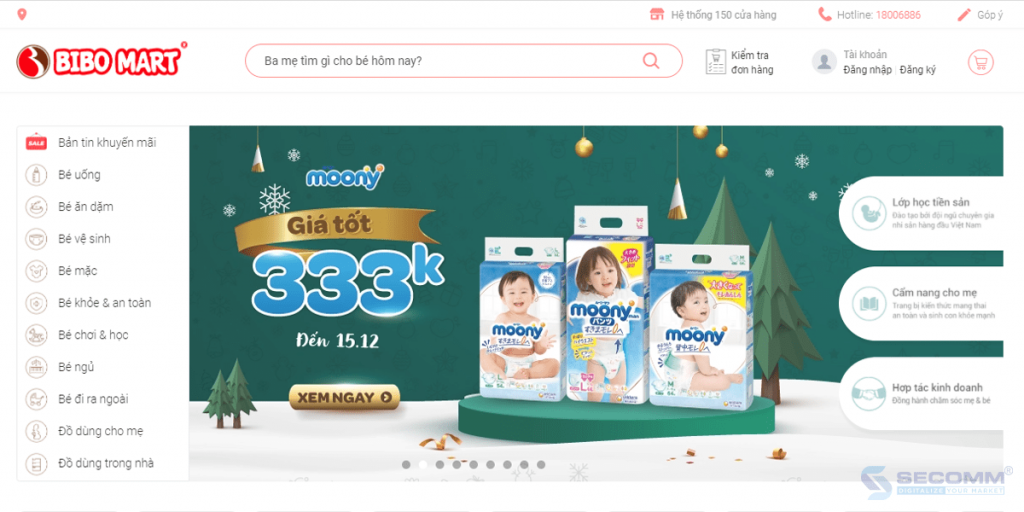
- Website: https://bibomart.com.vn/
- Traffic: 217.45K/month
- Expected online sales revenue: $1.5M/month
- Expected website investment cost: $2000+
- Used Version: Magento Open Source 2
On Off
On Off is a lingerie brand founded in 2005 to bring everyone comfort every day.

- Website: https://onoff.vn/
- Traffic: 162.29K/month
- Expected online sales revenue: $31K+
- Expected website investment cost: $250+
- Used VersionMagento Open Source 2
20 Again
20 Again is a women’s fashion brand with 3 main product lines: Office Wear, Dress Design, and Street Wear.

- Website: http://20again.vn/
- Traffic: 1K/month
- Expected online sales revenue: $24k+
- Expected website investment cost: $250+
- Used Version: Magento Open Source 2
Are you looking for the best Magento website development solution?
Contact SECOMM now for a free consultation on eCommerce development roadmap on Magento platform.
- Comprehensive understanding: Providing comprehensive eCommerce solutions from consulting, development, operation to eCommerce system growth.
- Expertise: Over 7 years of experience in implementing complex eCommerce systems for many customers from many countries (Australia, Singapore, USA, New Zealand, Denmark, Vietnam).
- Flexible schedule: The project’s time and progress can be adjusted to meet the specific needs of the business.
- Reasonable budget: Own a Magento website quickly with a reasonable budget, saving 80% for businesses.
 3
3

 3,596
3,596

 0
0

 5
5
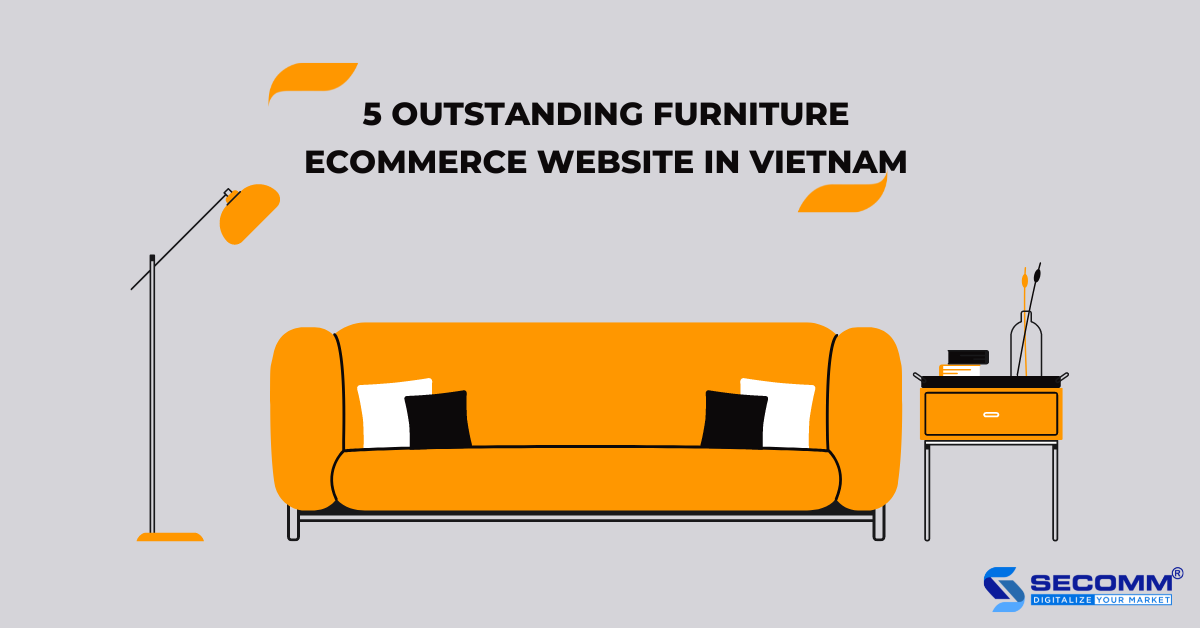
5 OUTSTANDING FURNITURE ECOMMERCE WEBSITE IN VIETNAM
Businesses may quickly detect a change in consumer behavior throughout the course of the pandemic as online purchasing steadily expands from basic necessities like food and medicine to a variety of other industries like fashion, wine, and furniture.
Also, customers’ awareness of a pleasant, modern, and healthy lifestyle has grown dramatically, which has given the furniture business a chance to go online and serve as a catalyst for Vietnamese eCommerce furniture to see breakthrough growth.
Realizing the great potential of this field, Vietnamese furniture enterprises have been embarking on building an eCommerce website system, which is considered an important factor leading to the success of this modern business trend.
Baya
Initially founded in 2006 under the name Sieu Thi Noi That Uma, the business has only recently (in 2019) changed its name to Sieu Thi Noi That Trang Tri Baya.
Although the brand’s name has changed, its essential values haven’t. It still offers clients high-quality furniture with a clean, sophisticated, trendy design in a neutral tone, and each piece is beautiful in its own right.
Thanks to the wise investment in developing a professional eCommerce website with the Magento open-source platform with an attractive and user-friendly interface, Baya’s website currently receives more than 100,000 visits each month.
In order to give clients the best eCommerce experience, this furniture manufacturer is constantly improving the system.
In addition, the company demonstrated its awareness of market trends by creating an app called My Baya with a QR payment method and positioning it as one of the primary categories on an eCommerce website to draw consumers’ attention to the website.
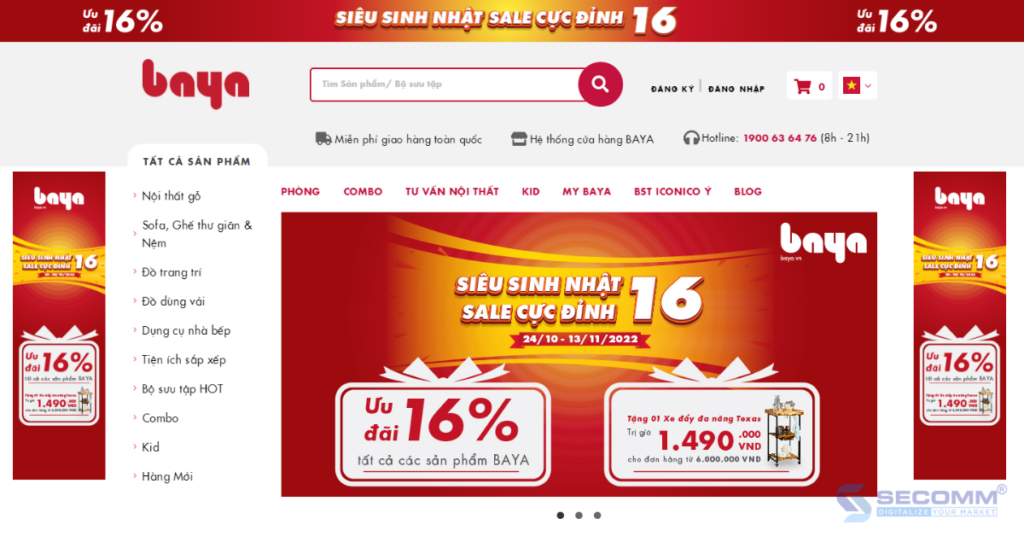
- Website: https://baya.vn/
- eCommerce platform: Magento
- Traffic: 103.9K/month
- Ranking: 11,388 (Vietnam); 526,185 (Worldwide)
Hoa Phat Furniture
With nearly 30 years of market experience and a wide range of clients, Hoa Phat Furniture is one of the top furniture suppliers and manufacturers in Vietnam.
All of Hoa Phat’s items are designed with a contemporary, opulent, and refined aesthetic in mind. In addition to a business strategy that is flexibly adjusted to the changes in the market, the company fully exploits the potential of eCommerce by building a professional and well-organized website on the BigCommerce platform.
From there, businesses increase their coverage and brand awareness on the Internet and reach more customers thanks to effective marketing methods.
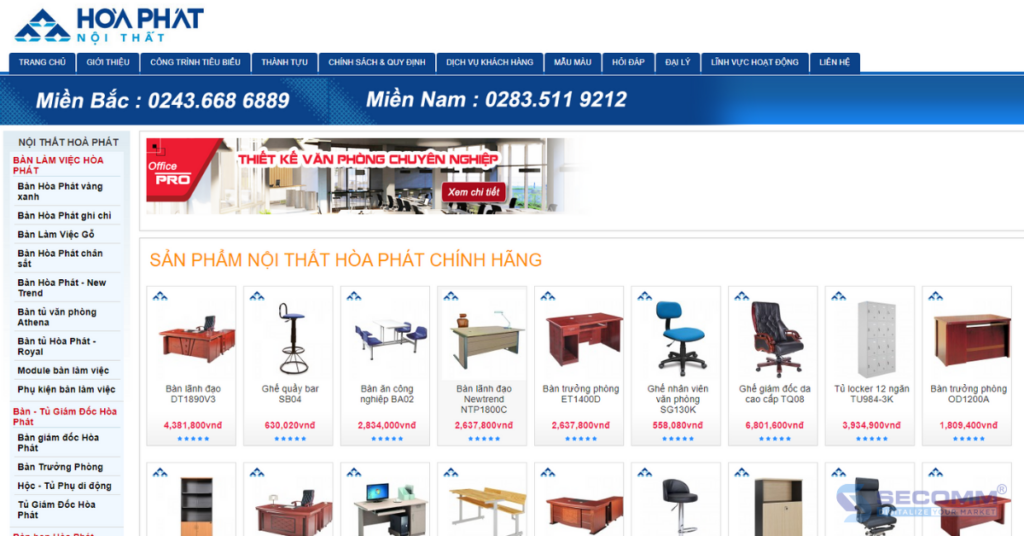
- Website: http://noithathoaphat.com.vn/
- eCommerce platform: BigCommerce
- Traffic: 59K/month
- Ranking: 11,855 (Vietnam); 545,292 (Worldwide)
Moho
The Moho furniture brand was established in March 2020 and is a subsidiary of Savimex, a company with over 35 years of expertise in the production and export of furniture. In order to fulfill the goal of sustainable development, Moho has kept offering clients furniture goods with affordable pricing and quality in accordance with international standards.
With more than 50,000 monthly visitors and a popular Haravan platform, Moho’s eCommerce website is well-liked by customers for their online buying experience.
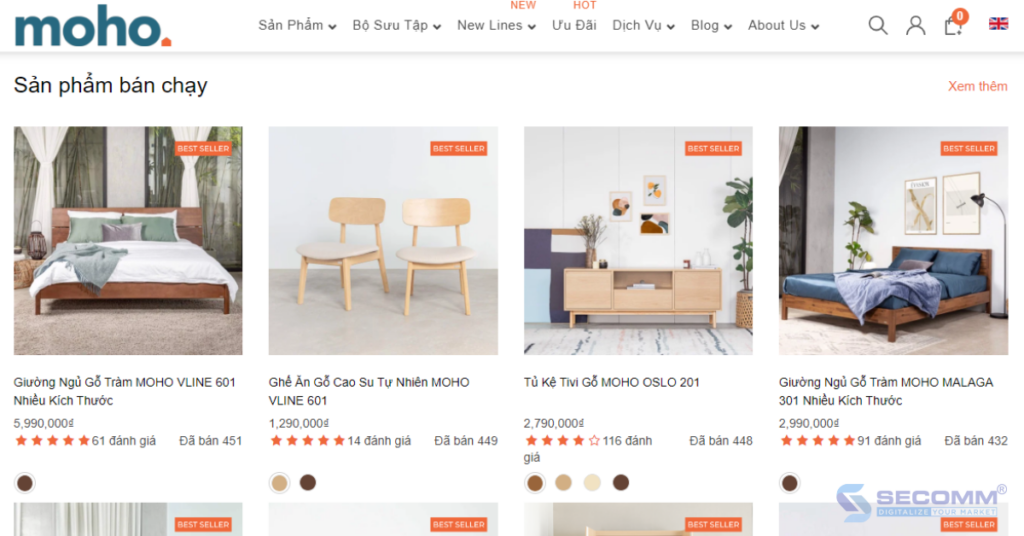
- Website: https://moho.com.vn/
- eCommerce platform: Haravan
- Traffic: 53.6K/month
- Ranking: 16,983 (Vietnam); 751,671 (Worldwide)
Cozy
COZY is a famous furniture brand present in the market since 1995 with high-class Italian-style designs. All products distributed by COZY are subjected to quality checks. With more than 25 years of establishment and development, COZY is one of the leading prestigious units in Vietnam in importing furniture from high-end brands from Europe.
In order to increase sales channels and reach a large number of potential customers online, COZY invested in developing an eCommerce website using the Shopify platform in addition to the showroom system dispersed around the districts of Ho Chi Minh City.
Because of the website’s elegantly crafted, opulent, and smart user interface, it receives an astonishing 45,000 visitors each month.
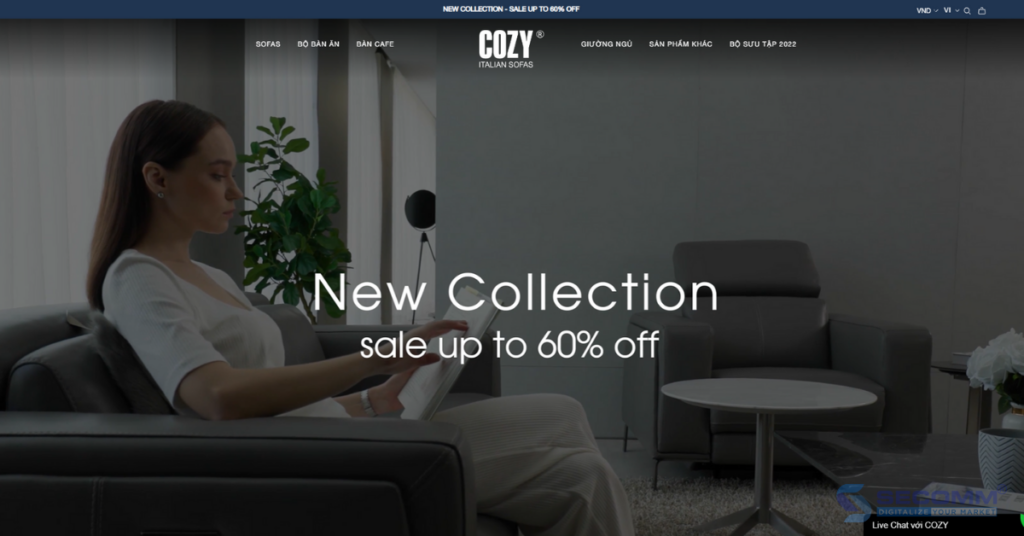
- Website: https://cozyliving.com.vn/
- eCommerce platform: Shopify
- Traffic: 45.3K/month
- Ranking: 23,596 (Vietnam); 1,033,514 (Worldwide)
Nha Xinh
Nha Xinh chooses a simple and intimate interior design style for each of the company’s products. The WooCommerce platform’s straightforward and user-friendly design of Nha Xinh’s eCommerce website’s interface amply illustrates this.
Furthermore, Nha Xinh’s website uses 360-degree technology to enable buyers to experience the company’s interior items from a distance in an accurate manner, providing information and a complete price list for each item from every angle of the room and product.
The eCommerce website now receives more than 40,000 visitors each month because of its painstaking attention to every last detail.
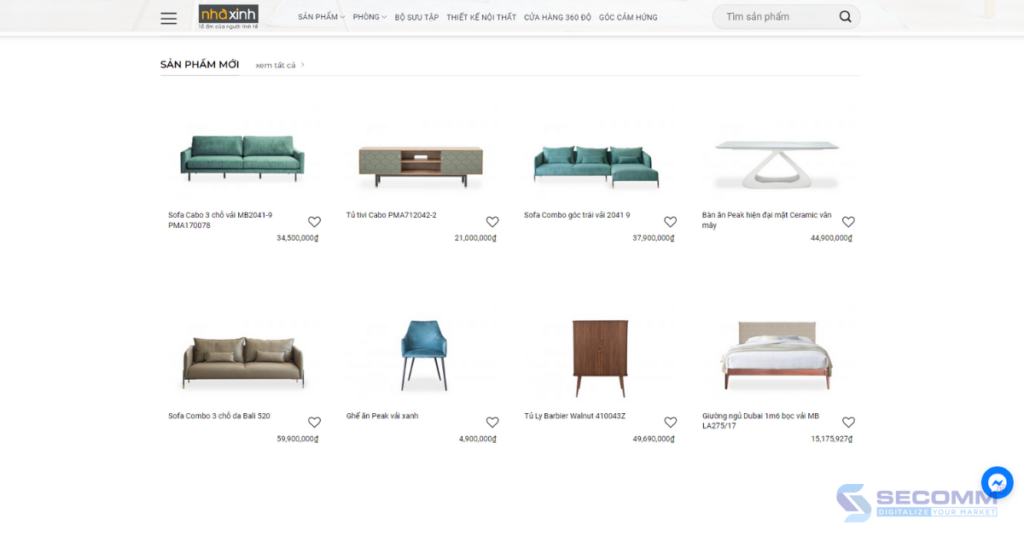
- Website: https://nhaxinh.com/
- eCommerce platform: WooCommerce
- Traffic: 41.1K/month
- Ranking: 15,415 (Vietnam); 696,229 (Worldwide)
Customers can save a ton of time and money when shopping online, especially when purchasing furniture. However, there are a lot of potential hazards associated with this type of business, particularly with regard to product quality and information security, and safety during the shopping and payment processes.
The furniture eCommerce sites discussed in this blog post are well-known destinations that have been active on the market for a long time and have serviced and satiated the wide range and expanding needs of clients.
These companies demonstrate their efforts to create the technological infrastructure that will enhance customers’ online shopping experiences, and they take priority on the development of a professional, well-invested supply chain that will expedite shipments while maintaining the quality of the goods until they are received by the customer.
When Vietnamese furniture businesses launch their own fully-functional eCommerce websites, professionalism, adaptability, and speed are the key success criteria.
Nevertheless, in order for the furniture eCommerce firm to succeed, business managers must carefully and comprehensively take into account the growing client wants and the continuously shifting market trends.
In particular, the task is to lay out a solid and methodical company plan so that the best short- and long-term actions can be taken. Completing that difficult task will take a lot of time and resources. As a result, many furniture companies opt for a more straightforward approach to the issue, enlisting the assistance of a highly qualified and dependable unit.
With many years of experience in successfully implementing eCommerce for many customers in many countries, SECOMM specializes in providing consulting services with comprehensive and professional e-commerce implementation solutions. , repertoires.
Contact SECOMM today for free support and advice.
 2
2

 3,762
3,762

 0
0

 1
1


